
- What to see
- Monuments and attractions

Hofburg Palace
The Hofburg Palace is one of the world's biggest palace complexes . With parts dating back to the 13th century, today it's Vienna's most popular monument.
The Hofburg is an enormous palace complex in the heart of Vienna, which includes fascinating museums , a church and chapel, the Austrian National Library , and the Spanish Riding School , as well as the office of the President of Austria.
There is undoubtedly something at the Hofburg complex to suit everyone's interests, and here we have compiled a guide to the three most popular places to visit within the palace: the Imperial Apartments, the Sisi Museum and the Imperial Silver Collection .
Imperial Silver Collection
At the end of the Habsburg monarchy, the court's impressive silver collection became property of the Austrian Republic. The museum's exhibitions of luxury crystal glasses, silverware, porcelain and more provide insight into the extravagant dining culture of the former imperial dynasty,
Sisi Museum
Discover fascinating facts about the incredible life of the beloved Sisi thanks to the museum audioguide as you explore the museum's six rooms dedicated to the Empress. Hear about her rebellion against court ceremony, her obsession with beauty and the deep sadness that affected her.
In an effort to escape the tragedies that had befallen her, Sisi travelled the world, until she was assassinated in 1898 in Geneva. The exhibition includes numerous objects belonging to the legendary empress, including childhood toys and musical instruments, her watercolour kit, jewellery and lavish outfits.
Imperial Apartments
Explore the different bedrooms, studies and living rooms that were home to the Habsburgs for over 600 years, including the official and private chambers of Emperor Franz Joseph and Empress Elisabeth. Perfectly preserved with their original decor and furnishing, the rooms are an incredible testament to the splendour of the dynastic Austrian royal family and to their personal histories as well.
Your audioguide will keep you entertained and informed with interesting facts as you wander through the palace's offices, lounges and bedrooms.
With your ticket giving you access to all three parts of this fascinating museum, and the included audioguide providing enlightening explanations of the history of Imperial Austria, the Hofburg Palace is undoubtedly one of the best visits in Vienna .
Save money by combining your visit buying the Sisi Ticket , giving you access to the Schonbrunn Palace and Imperial Furniture Collection as well as the Hofburg.
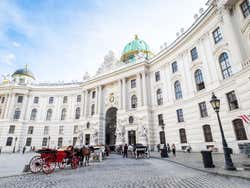
1 Michaelerplatz.
The Sisi Museum, the Imperial Apartments and the Imperial Silver Collection are open daily, including public holidays.
September to June: 9 am to 5:30 pm . July and August: 9 am to 6 pm .
Adults : € 15 ( US$ 16) Students (19-25): € 14 ( US$ 14.90) Children (6 to 18 years old): € 9 ( US$ 9.60) Vienna Pass holders: free.
Metro : Herrengasse , line U3 (orange). Tram : Burgring , lines 1, 2 and D. Bus : Burgring , lines 2A and 57A.
Nearby places
Spanish Riding School (76 m) Austrian National Library (178 m) Globe Museum (252 m) Ringstrasse (333 m) Albertina Museum (340 m)
You may also be interested in
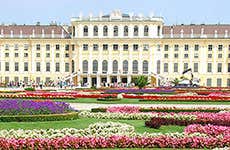
Schonbrunn Palace
Constructed in the 17th century, the immense Schonbrunn Palace in Vienna was the summer residence of the Austrian imperial family for several hundred years. Its stunning Baroque architecture, lavish interiors and beautiful gardens are well worth a visit.
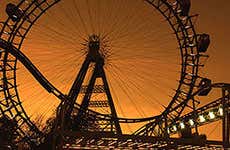
The Prater is a popular public park and green space in the city, and is home to one of the oldest amusement parks in the world. Its ferris wheel, at over 200 feet (65 m) tall, is one of the symbols of Vienna.
[An * means an affiliate relationship; see footer] City guide | Search the site | April tips
Visiting Vienna
Sisi Museum & Hofburg tour

If you want to plunge into the world of courtly life, love and even lavatories, you’re in the right place with a look inside the Hofburg complex.
- Sisi Museum
- Imperial Apartments
- Silver Collection (currently closed for renovations)
- Everything from baths to baby shoes
- Particularly recommended for fans of Empress Elisabeth
- Book a guided tour * of the Hofburg area
- Hofburg overview
- Schönbrunn Palace
- Tours in Vienna
What’s on the tour?
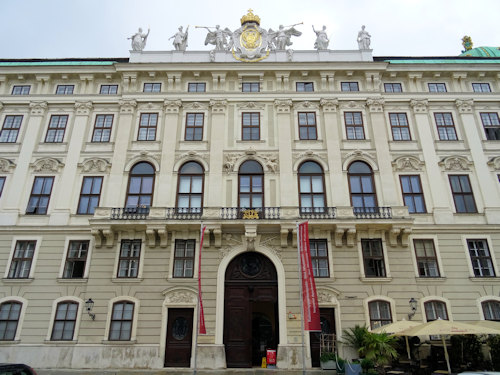
(The outside of the apartments)
Although the wider Hofburg area now features numerous separate institutions, your first address for seeing inside the imperial complex itself should be a tour of the Sisi Museum and Imperial Apartments.
A single ticket gets you into the locations in the main buildings at the heart of the Hofburg.
- The Sisi Museum features the life, clothes, and personal possessions of Sisi (Empress Elisabeth): the famous wife of Emperor Franz Joseph
- The Kaiserappartements Imperial Apartments are filled with historical fittings and furnishings. This is where Franz Joseph and Elisabeth lived and worked
The Silberkammer Imperial Silver Collection would normally form part of the tour with its wide range of precious porcelain and various household items from Habsburg times. However, renovation work means it’s closed for the foreseeable future (at the time of writing).
Is the tour worth it?
I think so.
Selected exhibits are, of course, priceless in terms of historical value. (You do not want to risk some of those glasses in a dishwasher.)
But even if you care little for the history or origin of the furniture and other items on display, you do get a good, big-picture impression of imperial life in the 19th century simply through what you see.
Elisabeth and Franz Joseph are interesting characters in their own right, and the contrasts between the two provide an intriguing background to your visit.
The tour also indirectly provides insights into the crushing pressures of sitting on top of the social and political ladder, the almost-depressing extravagance of court, and the tragically all-too-human weaknesses of those who would set themselves apart from the rest of us.
Tickets & visitor tips
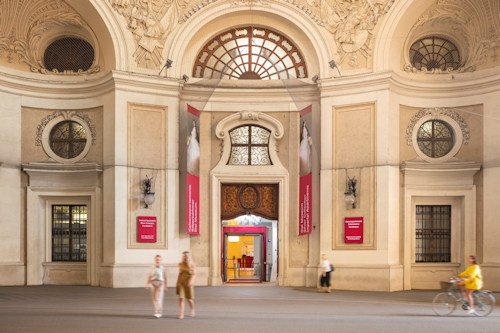
(Sisi Museum, Michaelerkuppel, entrance; © Schloß Schönbrunn Kultur- und Betriebsges.m.b.H., Severin Wurnig)
At the time of writing, basic admission costs €19.50 for the self-guided tour for an adult, with the usual reductions. Rather kindly, your ticket includes an audio guide. Vienna Pass holders get in once for free (read my review of this sightseeing pass ).
Some further tips:
- For deeper insight into what you see or a wider Hofburg experience, consider these guided options *
- Get there early and think about getting your tickets in advance online. It can all get busy: particularly the Sisi Museum which has some narrow passages in it
- It took me four hours to get round all three areas when the Silberkammer was open. But I listened to just about everything on the audio guide and read almost every written information So you can probably get round in half that time
(I may have skipped a few porcelain plates at some point, but, in my defence, they had an awful lot of them).
- Display labels and information are all in English and German. The audio guide provides interesting background information and little bonus bits of trivia
- The numbers to plug into your audio guide appear in large print with a picture of the device next to it. The smaller numbers in any display cabinets refer to index cards somewhere nearby that tell you what you’re looking at
- If you enjoy the Hofburg insights into life as an emperor or empress, then other tours of historical buildings might interest you.
- In particular, consider a similar tour over at Schönbrunn Palace. You get less porcelain and crockery but a lot more interior decoration and the added bonus of landscaped gardens to walk around afterwards
How to get to the Hofburg
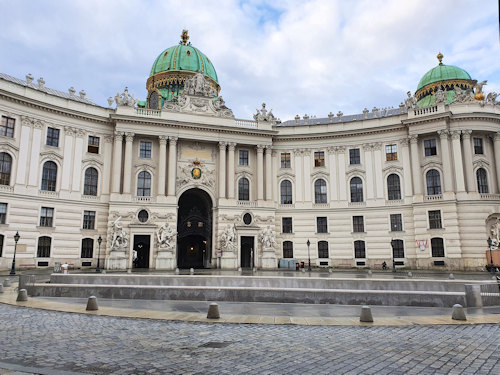
(The domed entrance on Michaelerplatz)
The Hofburg is a big place, largely free of vehicles. So you may have a short walk from all these public transport stops. But since that walk takes you through wonderful historical architecture or landscaped parks, that’s probably a good thing.
Indeed, the Hofburg is a major point on my suggested walking tour route for the city centre.
The ticket counter and starting place for the tours lie beneath the huge dome at the impressive Michaelerplatz entranceway (pictured above) at the northeastern end of the Hofburg complex.
Subway: Station Herrengasse (U3 and your best choice), Volkstheater (U2/U3) or Stephansplatz (U3/U1)
Tram: 1, 2, D or 71 to Burgring or 1, 2, D, 71, 46 and 49 to Ring/Volkstheater
Bus: 1A or 2A to Michaelerplatz (the best option) or 48A to Ring/Volkstheater
Address: Michaelerkuppel, 1010 Vienna | Website

Exploring Vienna's Imperial Hofburg Palace: A Visitor's Guide
Written by Bryan Dearsley Updated Dec 27, 2023 We may earn a commission from affiliate links ( )
Vienna's Imperial Palace, the Hofburg, was for centuries the seat of the Habsburgs, rulers of Austria until the end of WWI. A great deal of European history was written here, in particular by Empress Maria and, for a while, the German Emperor. Today, this spectacular palace is used as the official seat of the Austrian Head of State, the Federal President.
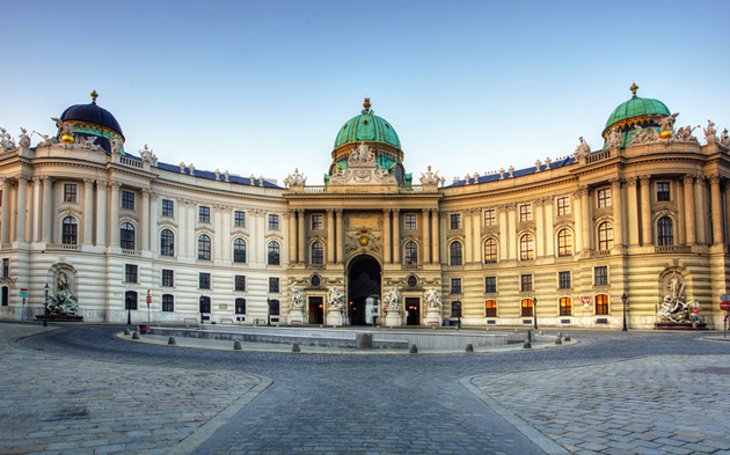
The palace complex - one of the largest in the world - is particularly interesting, as its major buildings reflect more than 700 years of architectural history. In fact, nearly every Austrian ruler since 1275 ordered additions or alterations to it, leaving a distinct architectural legacy.
As a result, the Hofburg shows many different architectural styles, from Gothic to Renaissance, Baroque to Rococo, and a smattering of Classicism thrown in for good measure. The oldest part of the complex, the Royal Chapel (Burgkapelle) dates from the 13th century and can still be visited. It's most notable as the home of the famed Vienna Boys' Choir , who can be seen in action during Sunday mass services.
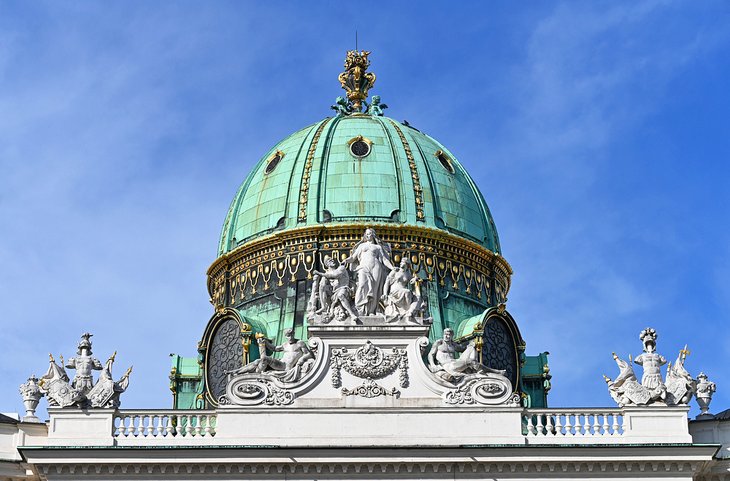
Together with its many squares and gardens, the Hofburg occupies an area of some 59 acres and is, in many ways, a "city-within-a-city" comprising 18 groups of buildings, 19 courtyards, and a staggering 2,600 rooms.
As a result, you can break your visit down into more manageable portions. Visitors in fact are given three choices when visiting this spectacular site: the Imperial Apartments, the Sisi Museum, and the Silver Collection. Each of these can be toured individually or as part of an extended visit.
The area around the Hofburg, along with some of its outlying buildings, also houses a number of other attractions. Some of the best are the Imperial Chapel (Burgkapelle), the Natural History Museum (Naturhistorisches Museum), the Austrian National Library, and the Spanish Riding School.
However you choose to tackle it, to help you plan your visit to this iconic attraction in the Austrian capital, be sure to bookmark and refer often to our visitor's guide to exploring Vienna's Imperial Hofburg Palace.
See also: Where to Stay near the Imperial Palace
The Imperial Apartments: Franz Joseph
The imperial apartments: empress elisabeth, the sisi museum, the hofburg palace silver collection, touring the hofburg palace, where to stay near the imperial palace, tips and tactics: how to make the most of your visit to vienna's hofburg palace, getting to the hofburg, what's nearby.
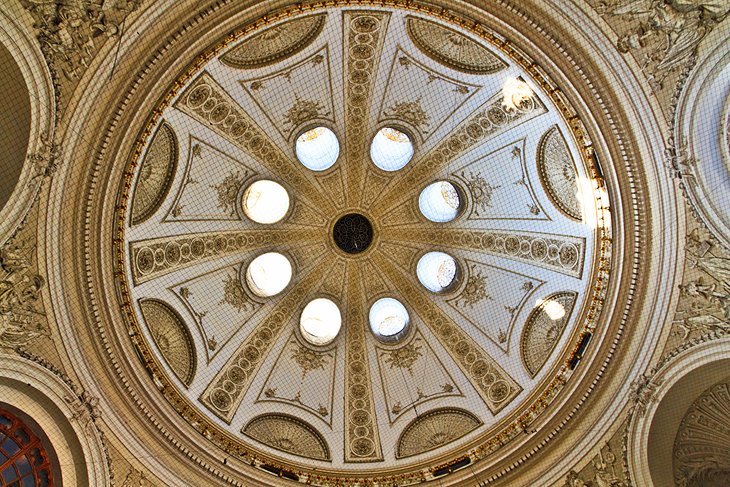
Of the rooms in the Hofburg accessible to the public, some of the most interesting can be found in the Franz Joseph Apartments . Most of these remarkably maintained rooms in fact remain unaltered since the Emperor's days. Highlights include the Dining Room, famous for its rich décor and Flemish artwork representing the heroic deeds of Hercules, and the Circle Room with its exquisite tapestries.
A fascinating model of the Hofburg and its many buildings can be viewed in the Guard Room, while in the Large Audience Chamber - the waiting room for the Emperor's weekly audiences - the Bohemian crystal candelabrum is worth seeing.
Also of interest here is a list of those in attendance on January 10th, 1910, while in the Study is a bust of Field Marshal Radetzky, one of a select group permitted to appear unannounced before the Emperor. The Field Marshal's ceremonial sword is also on display.
Empress Elisabeth's Apartments are no less impressive, and include her sumptuous Living Room. This elegant living space is widely regarded as the prettiest of the Hofburg's many rooms and served both as a living room and bedroom. Another highlight is the Large Salon, home to a fine collection of Louis XIV furniture and a number of Sèvres porcelain vases. It also houses a fine collection of Romantic landscape paintings, and a marble statue of Napoleon's sister.
Also worth a visit are Alexander's Apartments, named after Russia's Tsar Alexander I, who stayed here during the Congress of Vienna (highlights include the busts of Emperor Charles I and his consort, Empress Zita).
You can get an advance look at both Franz Joseph's and Elisabeth's apartments from the Sisi Museum's official website .
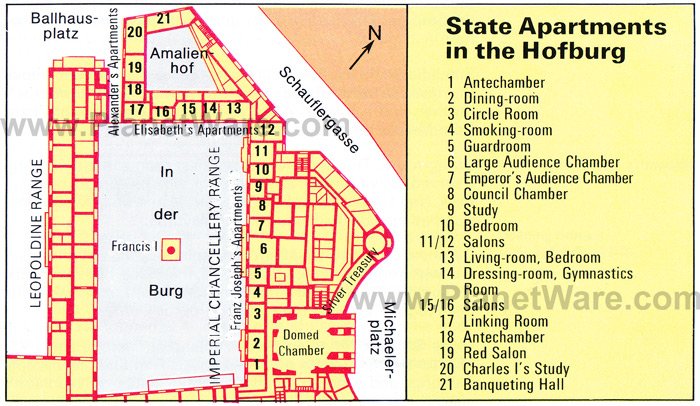
Dedicated to Empress Elisabeth (aka Sisi), the Sisi Museum offers a fascinating insight into the aristocracy of the 19th century. In the Hofburg's Stephan Apartments , highlights include more than 300 personal artifacts such as gloves, parasols, notes regarding her strict beauty regime, and the death mask made after her assassination. Also of interest here are the official records made at the time of this tragic event.
Other fascinating artifacts include a copy of the dress she wore when moving to Austria from her native Munich as a 16-year-old in 1854. There's also a copy of her coronation gown, and a replica of part of her imperial railway carriage. Also of note are a traveling medical chest and games case, along with her christening robes.
Address: Hofburg, Michaelerkuppel, 1010, Vienna, Austria
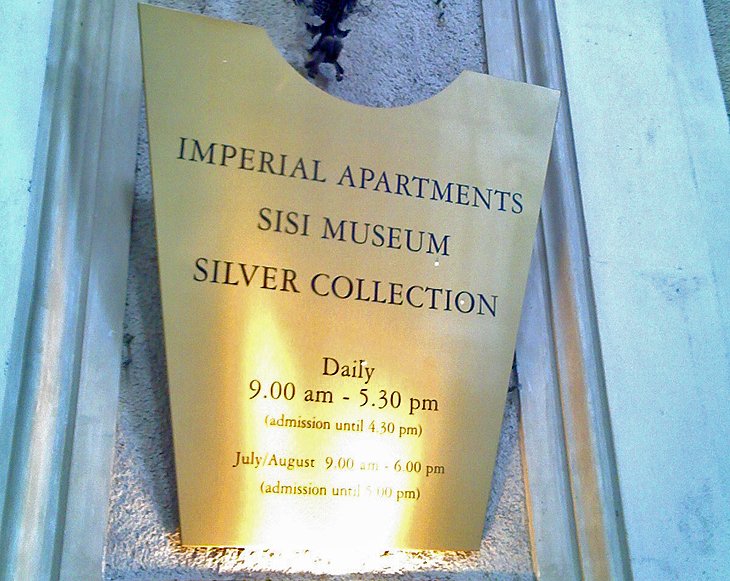
More than 7,000 items including ceremonial and everyday tableware from the Imperial Court are on display in the Silver Collection, a must-see when visiting the Hofburg. Among the many treasures in this spectacular collection are its fine 18th-century East Asian porcelain, the formal dinner services of Franz Joseph, and a silver traveling service belonging to Empress Elisabeth Christine (wife of Charles VI). Also worth seeing here is the spectacular 10-meter-long Milanese centerpiece made of gilded bronze.
Other highlights include the Meissen service from 1775, the 19th-century Viennese Empire service and, perhaps the most important part of the collection, the Ruby service used for Imperial grand occasions with its settings for 140 guests.
Also, be sure to pop into the Court Kitchen for a look behind the scenes of the Imperial banquets. On display are original copper vessels, pans, and molds, along with old kettles and the warming dishes needed to feed the court's 5,000 members.
Address: Michaelerplatz, 1010 Vienna, Austria
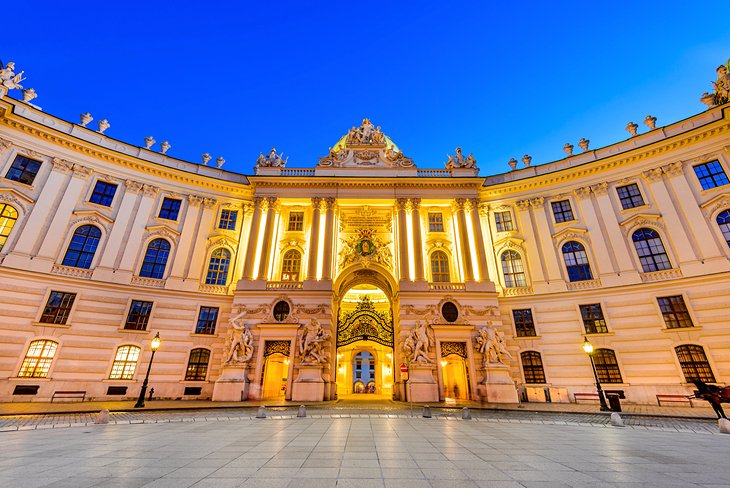
A number of excellent English language guided tours of the Hofburg Palace are available. The best of them will include the Sisi Museum and the Imperial Apartments. For those wanting to go it alone, English-language audio guides are included with your ticket. Private tours of the Imperial Apartments can also be booked for individuals and groups.
Those looking for a truly unique experience should consider one of the special evening or themed tours . These fun excursions include topics such as everyday imperial life, state banquets, and the life of Empress Sisi.
We recommend these great hotels located within easy walking distance of the Imperial Palace:
- Hotel Sans Souci Wien : This luxury boutique hotel features a stylish design, rooms with well-appointed bathrooms, plus amenities including an indoor lap pool and a spa with steam room.
- Hotel Kaiserhof Wien : A good choice of mid-range priced accommodations, Hotel Kaiserhof features old-world charm in a quiet location and offers a great breakfast buffet.
- Boutiquehotel Das Tyrol features affordable rates, comfortable beds, a spa with a sauna, plus multilingual staff.
- Kolpinghaus Wien-Zentral : This budget hotel comes with multilingual staff, free breakfast and Wi-Fi, and is pet-friendly.
- Dining: Café Hofburg serves coffees and light meals in the heart of the palace, and in warmer months offers patio service.
- Off-Season Specials: For those visiting during the quieter months of the year, special admission packages are available that include Viennese coffee and pastries at Café Hofburg, along with special combined admission to the Silver Collection, Sisi Museum, and Imperial Apartments.
- Access: The Sisi Museum and the Imperial Apartments are wheelchair accessible. Discounted tickets are available for those with disabilities along with those providing assistance.
- On Foot : The Hofburg lies within easy walking distance of Vienna's city center and its many tourist attractions.
- By Bus : The Hofburg is well served by city bus services (Routes 2A and 3A, alighting at Hofburg).
- By Tram : Vienna's tram services travel to the Hofburg regularly (Routes 1, 2, D, and J, alighting at Burgring).
- By U-Bahn (Subway) : The nearest subway station is Herrengasse (Route U3).
- By Train : Vienna is well served by major rail routes from across Europe and Austria. The nearest stations are Westbahnhof and Meidling (connections via U-Bahn are required).
- By Road: As with most major European cities, much of Vienna's city center is designated as pedestrians only. If driving is a must, park on the city's outskirts and use public transit.
- Parking: No on-site public parking is available.
- Hofburg Palace, Michaelerkuppel, 1010 Vienna, Austria
- Official site: www.sisimuseum-hofburg.at/en/
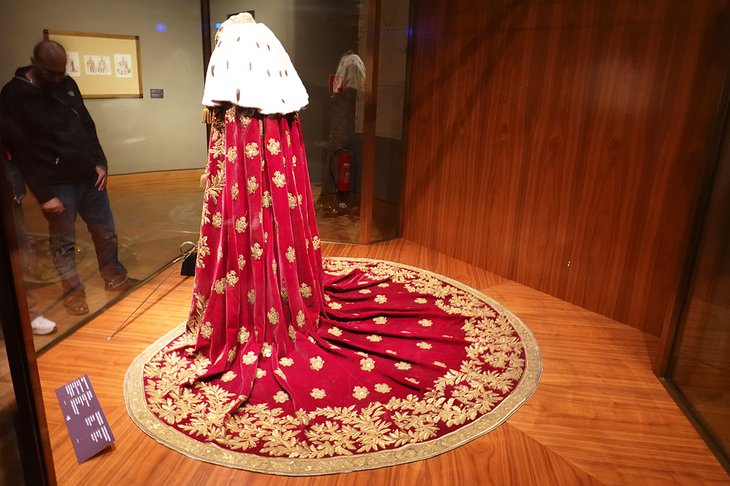
The Hofburg complex houses numerous other excellent attractions worth visiting, most of which are run independently and require separate admission. A must-see is the Imperial Chapel (Burgkapelle), constructed in 1449 with later additions in Baroque and Gothic styles. Highlights of a visit include its rich interior, along with an opportunity to see the famous Vienna Boys' Choir and the State Opera Choir singing at Sunday Mass and religious holidays (pre-booking essential).
The Collection of Arms and Armor (Hofjagd- und Rüstkammer) is another Hofburg must-see and includes medieval helmets, royal armor and ceremonial swords, richly ornamented shields, and superb 16th-century Ottoman weapons, while the Collection of Old Musical Instruments (Sammlung alter Musikinstrumente) in the New Palace (Neue Burg) contains unique Renaissance pieces such as antique clavichords, a table piano that belonged to Joseph Haydn, a grand piano presented to Beethoven, and a Viennese table piano at which Schubert composed.
The Hofburg complex also houses the Museum of Ethnology (Weltmuseum Wien) with its collection of more than 150,000 objects, including Benin bronzes dating back to the 15th century. Also worth seeing is the Mexican Collection with the headdress and feather shield of an Aztec priest.
The Imperial Treasury (Kaiserliche Schatzkammer) is also worth visiting and contains 21 rooms of Imperial regalia and relics, including coronation and chivalric insignia, badges of rank, secular and sacred treasures, and ornaments and mementos formerly owned by the Habsburgs.
More Related Articles on PlanetWare.com
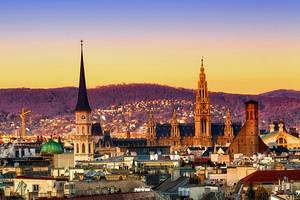
Exploring the Sites: Other must-see attractions to add to your itinerary include Schonbrunn Palace and St. Stephen's Cathedral , but for a complete list see, our guide to the top attractions in Vienna .
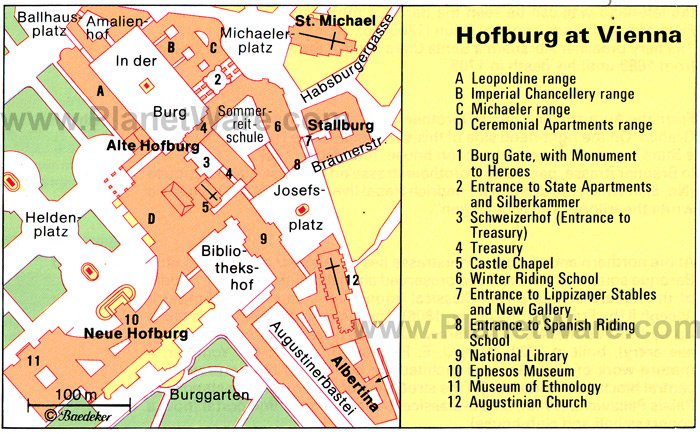
More on Austria
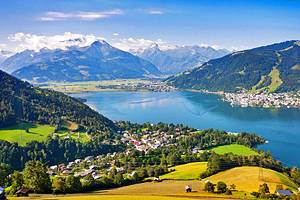

Our full collection of travel blog posts. Our Departure Board is where we (Andrew and Damon) provide useful travel advice and reviews on hotels, experiences, theme parks, food, transportation and more.
Visiting The Hofburg in Vienna: A Full FAQ Guide
Our December trip to Vienna was a great success. One of the must-see stops on our tour of the city was the Hofburg Palace. The former winter residence of the Habsburgs, now the official residence of the Austrian President, houses 3 museums, the Sisi Museum, the Imperial Apartments and the Imperial Silver Collection.
We’ll be answering in detail all of the most frequently Googled questions in this full FAQ guide.

- Getting There
- Hofburg Map
Opening Times
Ticket prices.
- Rules About Bags
- Rules About Filming/Photography
- Food and Drink
- WiFi Availability
- Rules About Pets
Getting To The Hofburg
The Hofburg Palace can be found in the heart of Vienna, within the city centre Ringstrasse (ring road). The official address is 1010 Wien, Austria.
You’ll find the entrance to the palace museums underneath Michaelerkuppel, the circular domed area between Innerer Burghof and Michaelerplatz.
Just follow the In Der Burg road north-east through the archway and you’ll see the entrance across from the entrance to the Spanish Riding School (before you go through the next archway into Michaelerplatz).

As with most of our time in Vienna, we relied a lot on the free-to-use Citymapper app for directions.
If you’re planning to take advantage of the extensive Viennese public transportation system (buses, trams, trains) consider getting a Vienna City Card ( read our review here to work out if it’s worth getting one for your trip).
Alternatively, if you’re wanting to try a more modern means of transportation, try scooting. It’s become a popular, fun, green mode of transport. Perfectly suited to a flat city like Vienna.
Use my Lime referral link to get one free unlock (usually €1).
Nearest Tram Stops on The Ringstrasse (Grand Boulevard)
There are two tram stops on the Ringstrasse around the same distance from the Hofburg.
Burgring Tram Stop: 500m or 6 minute walk south-west
Ring/Volkstheater Tram Stop: 650m or 8 minute walk west

Nearest U-Bahn/Metro Station
The closest U-Bahn/Metro stations to the Hofburg are the following:
U3 Line Stop: Herrengasse - 250m or 3 minute walk north
U2 Line Stop: Museums-Quarter - 850m or 10 minute walk south-west
Uber to and From The Hofburg
Uber has an extensive network and selection of cars in Vienna. You can use Uber Green (electric/hybrids) which I’ve found to be the same price as UberX rides but with the added environmental/green bonus on top. Uber Comfort, Uber Black and Uber Van are all available in and around Vienna too.
If you’ve never used UBER before, use our code: andrewy2730ue or sign up here to get a discount on your first journey.
Hofburg Palace Map
This map below shows the Ticket Office (1), Shop/Cafe (2), Sisi Museum (Pink), Silver Collection (Blue), Imperial Apartments (Red) and the exit on to Ballhausplatz.

The Hofburg, which includes the Silver Collection, Sisi Museum and Imperial Apartments are open daily (7 days a week) including public holidays, but the opening hours vary throughout the year. There are no restricted dates.
September to June Opening Times
Ticket Office: 9:00am to 4:30pm
Silver Collection: 9:00am to 5:00pm
Sisi Museum: 9:00am to 5:15pm
Imperial Apartments: 9:00am to 5:30pm
July To August Opening Times
Ticket Office: 9:00am to 5pm
Silver Collection: 9:00am to 5:30pm
Sisi Museum: 9:00am to 5:45pm
Imperial Apartments: 9:00am to 6:00pm
The Hofburg, like most major tourist sites in Vienna, is not free to visit. All tickets come with a free audio guide but you can opt for a guided tour with an extra charge. Also, check out the Sisi ticket below, if you’re planning a visit to Schönbrunn Palace and/or the Imperial Furniture Collection as well.
You can buy your tickets at the Hofburg entrance desk or you can buy tickets online, in advance through the Hofburg website.
Adults: €15 with audio guide (€18 for guided tour)
Vienna City Card Holders : €14 with audio guide (€17 for guided tour)
Children (6-18): €9 with audio guide (€10.50 for guided tour)
Students (19-25 with Student ID): €14 with audio guide (€17 for guided tour)
Disabled Persons (with valid ID): €14 with audio guide (€17 for guided tour). Free for those accompanying blind/vision-impaired visitors or a wheelchair user (with valid ID).
School Groups (6-18 with 10 pupils and above): €7 with audio guide (€8.50 for guided tour)
Is The Sisi Ticket Worth It?
The Sisi Ticket is a combined ticket which grants you access to the Hofburg, Schönbrunn palace and the Imperial Furniture Collection. If you plan on visiting all 3, you’ll save money by purchasing the Sisi ticket.
In the Hofburg, you’ll get to see the Silver Collection, Sisi Museum and Imperial Apartments with an audio guide. You’ll get to go on the Grand Tour of Schönbrunn Palace. This is the longer tour which encompasses 40 rooms and takes approximately 50-60 minutes.
The shorter (and cheaper) imperial tour takes you through 22 rooms and takes around 30-40 minutes (essentially it doesn’t include one wing of Schönbrunn). Plus, you’ll get access to the Imperial Furniture Collection, which also includes a tour and audio guide.
Sisi Ticket Costs:
Adults: €34
Vienna City Card Holders : €31
Children (6-18): €21
Students (19-25 with Student ID): €31
Disabled Persons (with valid ID): €31. Free for those accompanying blind/vision-impaired visitors or a wheelchair user (with valid ID).
Family Ticket (2 adults & 3 children): €71
School Groups (6-18 with 10 pupils and above): €16.50
Important: Sisi ticket prices are due to increase as of April 1st 2020. All ticket prices will increase by €2 with the exception of school group tickets, which stay the same, and the family ticket which increases by €4.
What About Taking Bags Inside The Hofburg?
You won’t be allowed to take in bulky objects or luggage (suitcases, large bags, scooters etc.) and there is no cloakroom or left-luggage service at the Hofburg. Largely due to the fact that the entrance location (under Michaelerkuppel) is different from the exit location (Ballhausplatz).
However, small backpacks and handbags are allowed. Just make sure you’re not carrying any bulky items with you when you go to visit.
Can I Film Or Take Photos In The Hofburg?
In the Sisi Museum and Imperial Apartments, the answer is a firm no. You’re not allowed to film or take photos in these sections of the Hofburg. You’d need to get an official permit if you want to do either.
There is no ban on filming or photography inside the Imperial Silver Collection museum (which is the first stop on your tour of the Hofburg).
Food And Drink
Food and drink aren’t allowed inside the display rooms, with one exception, closable water bottles (sports bottles). You are allowed to carry those with you inside the Hofburg.
You can grab food and drink at Café Hofburg, located just outside the entrance in Innerer Burghof (on the right hand side in the image below). This is a traditional Viennese coffeehouse which serves, hot and cold drinks, plus a selection of cakes and pastries.

Is WiFi Available Inside The Hofburg?
No, there is no WiFi or WLAN available.
Are Pets Allowed Inside The Hofburg?
Pets, in general, are not allowed inside the Hofburg, with the exception of accredited assistance dogs.
What To See In The Hofburg
Thanks to the linear layout of the Hofburg, taking you through each of the 3 museums one at a time, it’s likely you won’t miss anything on your tour. That being said, here’s what you can expect to see.
The history of the Hofburg. All 600 years of it. The Hofburg was home to the Hapsburgs (13th to 15th century), Holy Roman Emperors (15th to early 19th century) and Austrian Emperors (early 19th century until the end of the monarchy in 1918).

The Milan Table Centrepiece in the Imperial Silver Collection. At 30 metres long, this piece was commissioned to mark the coronation of Austrian Emperor Ferdinand I in 1838.

The Sisi Museum. This section of the Hofburg tour takes an extensive look at the life of the longest serving Empress of Austria, wife of Emperor Franz Joseph I. Empress Elisabeth, nicknamed “Sisi”. From her life as a member of the court, to her assassination by an Italian anarchist in 1898.

Thank you to the Hofburg team for inviting us to visit. As always, all opinions are my own. Are you thinking of visiting the Hofburg in Vienna? Are there any questions I didn’t answer above? Let us know in the comments section down below.
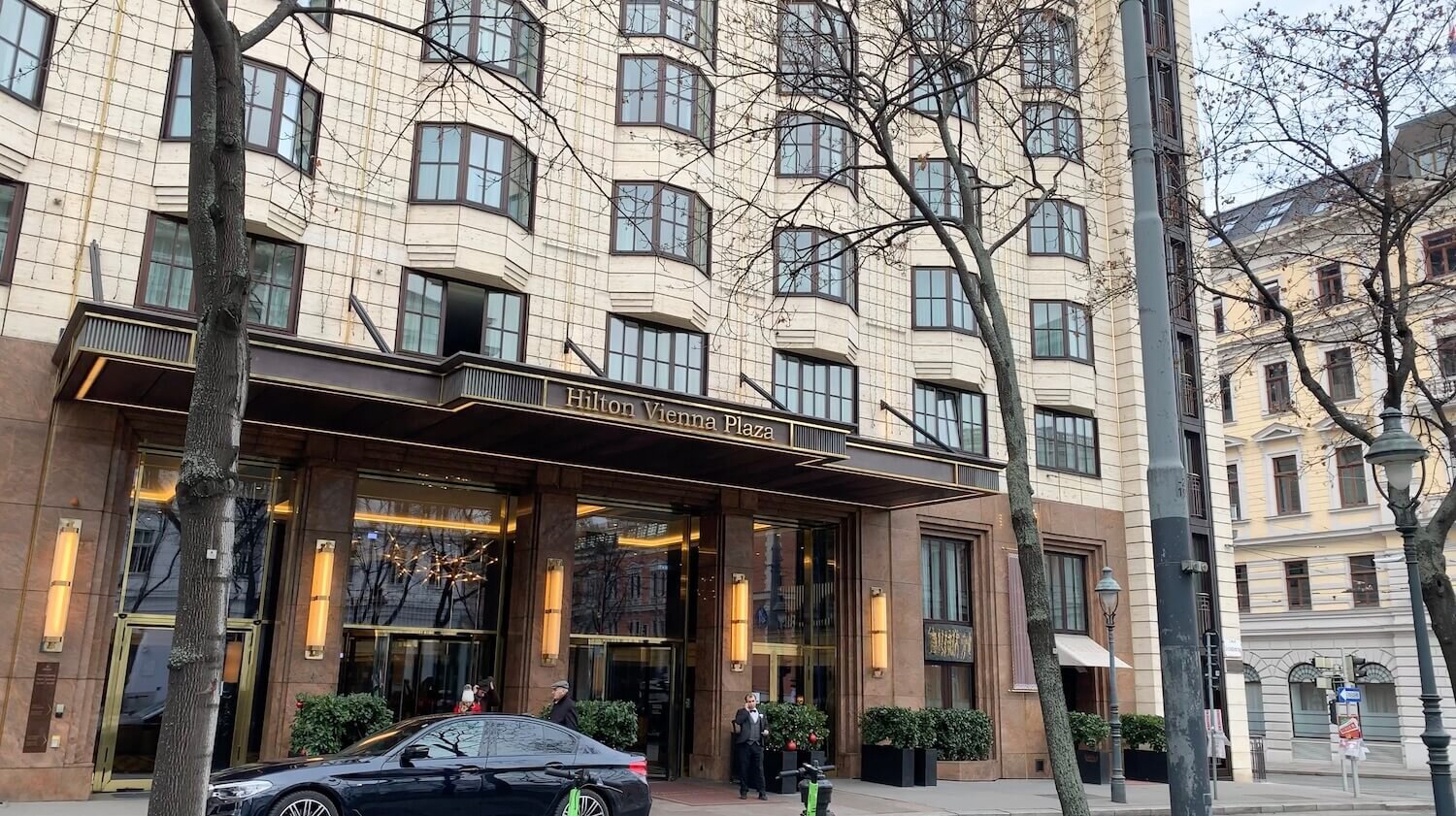
Our comprehensive guide and review to the Hilton Vienna Plaza. Staying in the top floor Penthouse Royal Suite, making full use of the executive lounge and more.
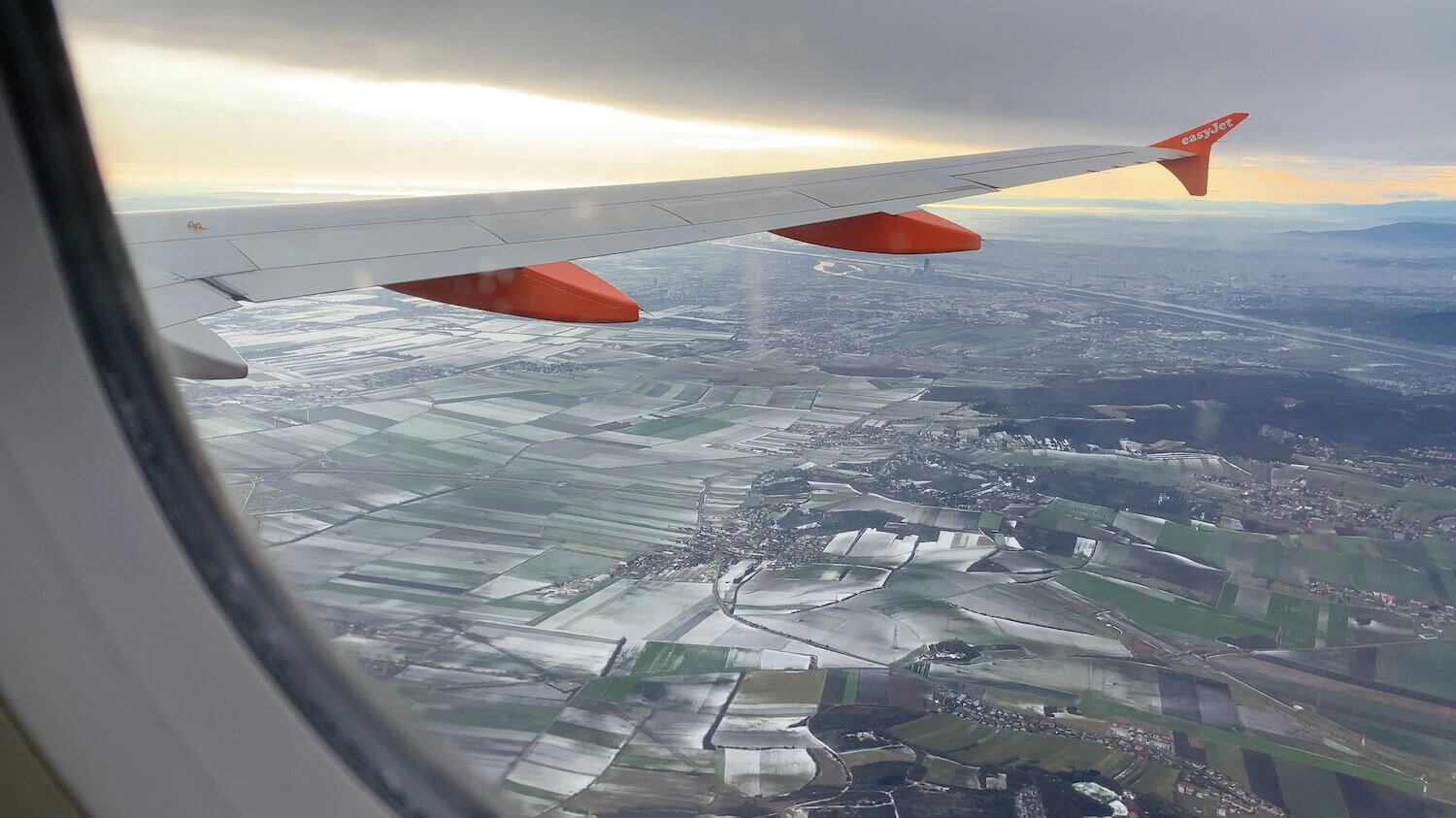
We flew with EasyJet on our recent trip to Vienna. A direct flight from Edinburgh travelling in economy. Here is our full, illustrated guide and review to the entire experience.
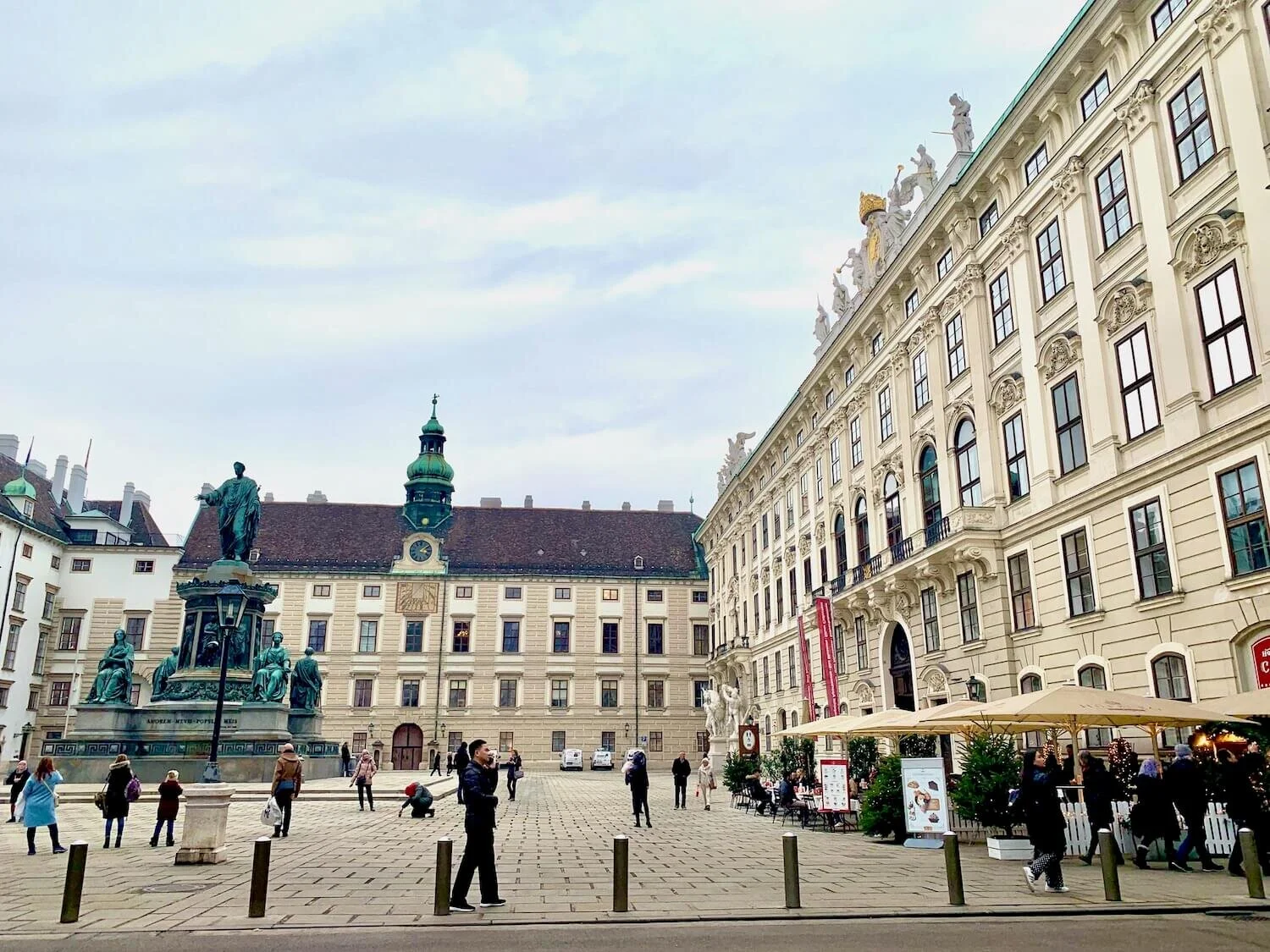
The Hofburg is home to the Sisi Museum, Imperial Apartments and Imperial Silver Collection. In this guide, we’ll be answering all of your most frequently Googled questions about a visit to the palace.
Our Departure Board
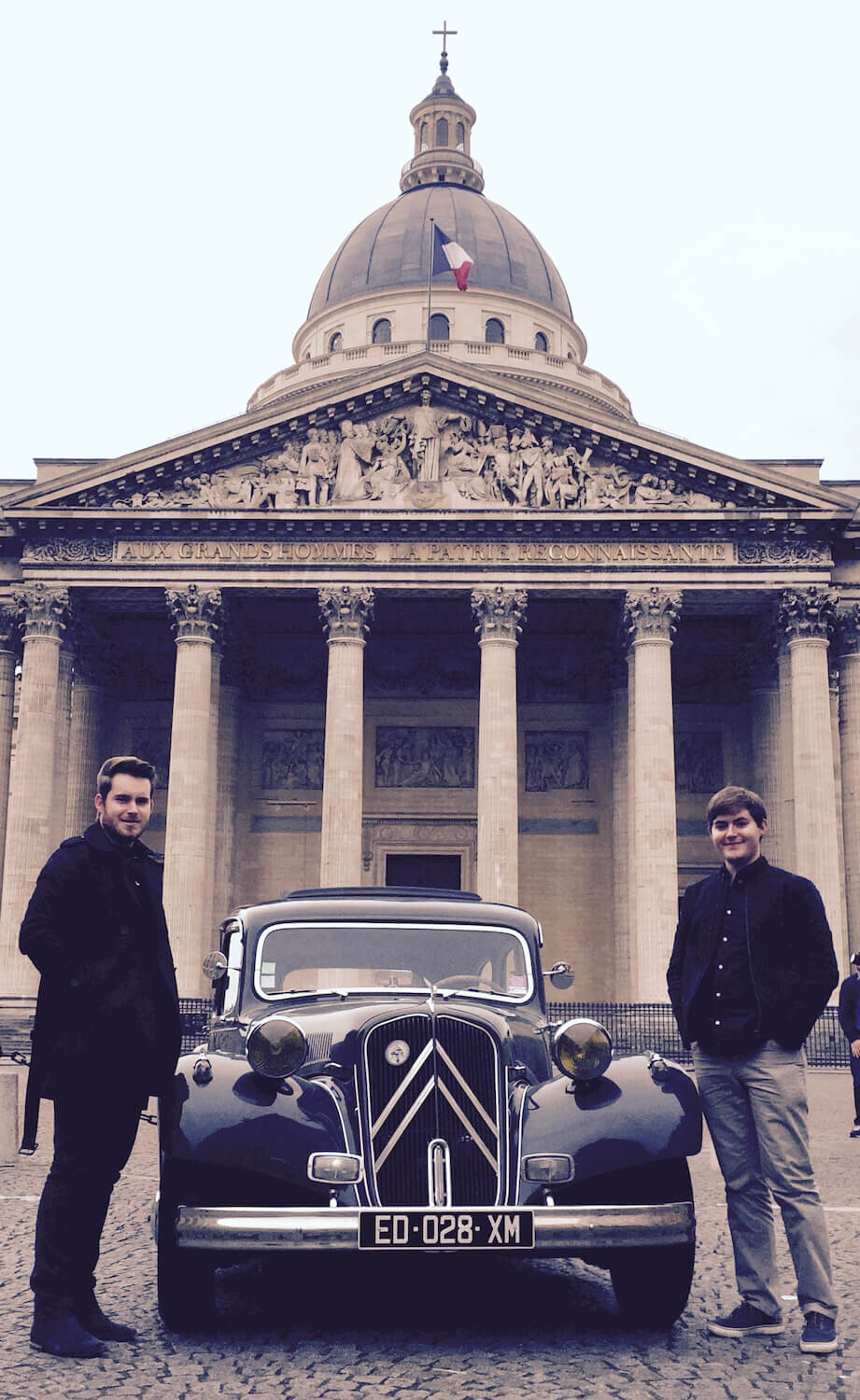
Hi there, we’re Andrew and Damon, Disney aficionados, Hilton Diamond members and founders of Our Departure Board.
We have the ambitious goal of providing you with the most honest, fair and comprehensive travel guides and reviews on the internet.
Support Our Work
If you obtain value from our blog, please consider booking or buying with one of our affiliate partners at no extra cost to you.

- Netherlands
This site uses affiliate links. We only link to products or services we have used or experienced ourselves.
We are also a participant in the Amazon Services LLC Associates Program, an affiliate advertising program designed to provide a means for sites to earn advertising fees by advertising and linking to Amazon.com .

Get In Touch: [email protected]
Disclaimer Page and Policies
Capital Matters | Deal Frontier | World Tip Calculator
© 2019-2024 Our Departure Board

All About Vienna
Travel guides, attractions and tips
The Ultimate Visitor’s Guide to Hofburg: Witnessing the Heartbeat of Austrian Royalty

ADDRESS & CONTACT
Hofburg Wien 1010 Wien
48.2076838, 16.3661951
Official Website
OPENING HOURS
10:00-17:00
The Hofburg is the former Habsburg dynasty rulers‘ main imperial palace and today serves as the Austrian President’s official residence and a workplace. Located in the middle of Vienna , it was constructed in the 13th century and subsequently extended several times.
The name translates as “Castle of the Court,” which, when originally built during the Middle Ages, indicates its roots. The palace, originally planned as the seat of the Dukes of Austria in the 13th century, expanded over the decades as they became ever stronger and more powerful.
Today, it also hosts Organization for Security and Co-operation in Europe (OSCE).
Table of Contents
Quick facts
Originally built as a fortified palace, The Hofburg was being expanded through centuries and now it is a palace complex with 18 wings, 19 courtyards and 2,600 rooms totaling over 240,000 m² and with almost 5,000 people who work and live there.

Most visited parts of Hofburg are Sisi Museum , Imperial Apartments and Silver Collection . The palace is also famous for hosting excellent classical music concerts.
Welcome to the majestic world of Hofburg, an extraordinary palace that echoes the resplendent history of Austrian royalty. Nestled in the heart of Vienna, this enchanting landmark has witnessed centuries unfold with grace and grandeur.
Prepare to be transported back in time as we unlock the secrets behind its opulent halls and intricately designed gardens. Whether you’re a history enthusiast or simply captivated by regal allure, join us on an unforgettable journey through The Ultimate Visitor’s Guide to Hofburg: Witnessing the Heartbeat of Austrian Royalty.
Embrace your inner aristocrat as we delve into this captivating tale filled with hidden treasures, remarkable anecdotes, and architectural marvels that will leave you breathless. Are you ready to immerse yourself in a world where time stands still? Let’s embark on this royal adventure together!
Introduction to Hofburg and its significance in Austrian history
Hofburg Palace, also known as the Imperial Palace, has been the epicenter of Austrian history for over 700 years. Located in the heart of Vienna, this magnificent palace complex has been home to some of the most influential rulers in European history.
The beginnings of Hofburg can be traced back to the 13th century when it was originally a medieval castle constructed for defense purposes. However, it was under the Habsburg dynasty that it transformed into one of Europe’s grandest imperial palaces. Over the centuries, numerous additions and renovations were made to expand and beautify this royal residence.

One of the main reasons behind Hofburg’s significance is its close association with the Habsburg family, who ruled Austria for more than six centuries. This sprawling complex served as their primary residence until 1918 when Emperor Charles I abdicated his throne at the end of World War I.
As you step foot inside Hofburg, you’ll find yourself surrounded by a wealth of architectural styles ranging from Gothic to Baroque and Rococo to Neoclassical. Each building within this vast compound exudes grandeur and gives visitors a glimpse into Austria’s rich cultural heritage.
Apart from being a royal residence, Hofburg also played an essential role in shaping Austrian politics and culture. It has witnessed many significant events such as royal weddings, coronations, state funerals, and even political meetings that have had a profound impact on Austria ‘s history.
Today, the Hofburg Palace complex serves as a museum and houses a variety of museums, galleries, and other cultural institutions. Visitors can explore the Imperial Apartments, the Sisi Museum, the Silver Collection, and the Imperial Treasury to get a better understanding of Austria’s past.
In conclusion, Hofburg is not just a royal residence but also a symbol of Austrian identity and pride. It stands as a testament to centuries of imperial rule and continues to attract visitors from all over the world who marvel at its grandeur and historical significance.
A brief history of Hofburg and the Habsburg dynasty
Hofburg, also known as the Imperial Palace, is a sprawling complex located in the heart of Vienna, Austria. It has been the home of the powerful Habsburg dynasty for over six centuries, serving as a center of political and cultural power for the Austrian Empire.
The Habsburg dynasty was one of the most influential royal families in European history, with roots dating back to 1273 when Rudolf I became the first Habsburg ruler. However, it was not until 1438 that they gained control over Austria and made Vienna their capital city.

One of the most significant periods in Hofburg’s history was during Emperor Charles VI’s reign in the late 17th century. He commissioned renowned architects such as Johann Bernhard Fischer von Erlach to transform Hofburg into a grand imperial residence fit for Europe’s leading monarchs.
Under Empress Maria Theresa’s rule in the mid-18th century, Hofburg reached its peak splendor. She oversaw extensive renovations and added new wings and rooms to accommodate her large family and court. Many areas were adorned with lavish decorations and opulent furnishings, showcasing her wealth and power.
The early 19th century saw Napoleon Bonaparte conquer Austria and occupy Hofburg briefly before being defeated in 1815. After his defeat, the Habsburg dynasty regained control and continued to use Hofburg as their primary residence.
In 1918, following World War I, the Austro-Hungarian Empire collapsed, and Austria became a republic. The last monarch of the Habsburg dynasty, Emperor Charles I, was forced to abdicate, and Hofburg was turned into a museum.
Today, Hofburg remains one of Vienna’s top tourist attractions, with parts of the complex still used for official state ceremonies and events. It is also home to several museums and houses many valuable collections of art and historical artifacts from the Habsburg era.
The Habsburg dynasty may no longer rule Austria, but their legacy lives on through the grandeur of Hofburg and its rich history.
Highlights of the Hofburg Palace complex, including:
The Hofburg Palace complex is a stunning and expansive architectural wonder that has played a crucial role in the history of Austria. Over the years, it has been home to generations of Habsburg rulers and served as the epicenter of political power in the region. Today, this magnificent palace is one of Vienna’s top tourist destinations, attracting millions of visitors each year.

1. Imperial Apartments: Step into the lavish lifestyle of Austrian royalty with a tour of the Imperial Apartments. These opulent living quarters were once home to Emperor Franz Joseph and Empress Elisabeth (better known as Sisi) and have been preserved in their original state. Admire the grandeur and intricate details of each room as you learn about the daily lives and routines of these influential rulers.
2. Sisi Museum: For those fascinated by Empress Elisabeth, a visit to the Sisi Museum is a must. This museum offers an intimate look into her life, from her childhood to her tragic death. See personal items such as her dresses, jewelry, and even her beauty secrets that reveal more about this enigmatic figure.
3. The Silver Collection: As one of Europe’s most extensive collections of ceremonial silverware, this exhibit showcases exquisite pieces used by Austrian emperors for official occasions such as banquets and receptions. Marvel at intricate table settings, ornate centerpieces, and impressive serving dishes that reflect the wealth and prestige of the Habsburg dynasty.
4. Imperial Treasury: The Hofburg Palace’s Imperial Treasury is home to an impressive collection of jewels and artifacts that have been collected by the Habsburgs over centuries. Among them, you’ll find the Crown of the Holy Roman Empire, the largest cut emerald in the world, and other precious items that were once owned by European monarchs.
5. National Library: The magnificent State Hall of the Austrian National Library is a sight to behold with its grand marble columns, frescoed ceiling, and rows upon rows of bookshelves. This stunning baroque library holds over 200,000 books including rare manuscripts and ancient texts.
6. Spanish Riding School : For those interested in equestrian arts, a visit to the Spanish Riding School within the Hofburg complex is a must. Watch as riders perform breathtaking displays of horsemanship in this historic institution that has been training Lipizzaner horses for over 450 years.
7. Heroes’ Square: Located at the front entrance of the Hofburg Palace complex, Heroes’ Square is a vast open space lined with imperial buildings and statues dedicated to Austria’s military history. It also serves as a popular spot for events
Imperial Apartments
The Imperial Apartments are one of the most iconic and grandiose parts of Hofburg, often referred to as the “heart” of Austrian royalty. These opulent living spaces were once occupied by some of the most influential rulers in Europe, including Emperor Franz Joseph and Empress Elisabeth (also known as Sisi). Today, they serve as a fascinating glimpse into the lavish lifestyle and rich history of the Habsburg dynasty.
Located on the first floor of Hofburg’s main building, visitors can access the Imperial Apartments through a separate entrance on Michaelerplatz. As you enter through the majestic double doors, you will be transported back in time to an era of luxury and extravagance.
The apartments consist of over 20 rooms and span across two wings – Leopoldine Wing and Amalia Wing. Each room is beautifully decorated with intricate details, luxurious furnishings, and priceless works of art. Walking through these rooms feels like stepping into a royal palace with its soaring ceilings, crystal chandeliers, and elaborate frescoes adorning the walls.
One highlight of the Imperial Apartments is undoubtedly The Great Audience Hall or “Grosse Audienzsaal” in German. This impressive hall was used for official ceremonies such as court receptions and imperial audiences. Its grandeur is unmatched with its marble floors, golden decorations, and portraits of prominent members of the Habsburg family.
Another must-see room is The Sisi Museum located within Elisabeth’s former apartments. This museum offers a unique insight into the life of Empress Elisabeth, featuring personal items such as her dresses, jewelry, and beauty products. The rooms are also decorated in a more feminine and romantic style compared to the rest of the apartments.
Overall, a visit to the Imperial Apartments is a must for anyone interested in European history, art, or architecture. It’s an opportunity to step back in time and experience the lavish lifestyle of Austria’s royal family. Audio guides are available in multiple languages for an additional fee, and guided tours are offered on select days.
Sisi Museum
The Sisi Museum, located within the Hofburg Palace complex, is a must-visit for anyone interested in the life and legacy of Empress Elisabeth of Austria, also known as Sisi. This unique museum offers a glimpse into the private world of one of Austria’s most iconic figures and showcases her personal items, including clothing, jewelry, and other possessions.

One highlight of the Sisi Museum is undoubtedly the display of over 300 pieces from Empress Elisabeth’s wardrobe. These include elaborate gowns adorned with intricate lacework and jewels, as well as delicate undergarments and accessories such as shoes and gloves. The attention to detail in these garments is truly remarkable and gives visitors a sense of how fashion played an important role in Sisi’s life.
Aside from her wardrobe, visitors can also admire some of Sisi’s prized possessions in the museum’s collection. These include rare portraits, sculptures, letters, and other memorabilia that offer more insight into her personality and interests. One notable item on display is a miniature portrait painted by Franz Xaver Winterhalter that captures Sisi at the height of her beauty.
In addition to the personal items and artifacts, the Sisi Museum also features interactive displays and multimedia installations. These provide an engaging and immersive experience, allowing visitors to learn more about Sisi’s life, including her travels, hobbies, and relationships with other members of the Habsburg family.
Overall, the Sisi Museum is a must-visit for anyone who wants to learn more about Empress Elisabeth and her impact on Austrian history. With its stunning displays and informative exhibits, this museum offers a unique perspective on one of the most fascinating figures in European royalty.
Silver Collection
The Silver Collection is one of the most impressive and extensive collections within the Hofburg Palace, showcasing the opulence and grandeur of the Austrian monarchy. This collection includes various items made from silver, such as dining sets, decorative objects, and personal items belonging to the royal family.

One of the highlights of this collection is the Imperial Tableware, which was used for state banquets in honor of important guests and dignitaries. Made from precious metals and adorned with elaborate designs, these sets were used to showcase the wealth and power of Austria’s rulers. Visitors can marvel at these exquisite pieces while imagining themselves as esteemed dinner guests in a lavish banquet hall.
Another fascinating aspect of the Silver Collection is its display of personal items belonging to Emperor Franz Joseph I and Empress Elisabeth (also known as Sisi). These include intricately carved snuffboxes, ornate fans, jewelry boxes, and even personal grooming tools made from silver. These items offer an intimate glimpse into the lives of Austria’s royalty and their refined tastes.
In addition to these grand displays, there are also smaller but equally significant objects exhibited in this collection. For example, visitors can see delicate silver cups that were used for drinking coffee or tea during private meetings between members of the royal family. These items may seem small, but they offer a unique insight into the daily lives and customs of Austria’s monarchy.
The Silver Collection is not only a testament to the luxurious lifestyle of Austria’s rulers, but it also serves as a reminder of the country’s rich cultural heritage. Each item in this collection tells a story and offers a glimpse into the grandeur and opulence of Austria’s past. It is truly a must-see for anyone visiting the Hofburg Palace.
Spanish Riding School
The Spanish Riding School, also known as the Spanische Hofreitschule in German, is a world-renowned institution that has been at the heart of Austrian culture and tradition for over 450 years. Located within the Hofburg complex, this historic school is a must-visit for anyone interested in experiencing the elegance and grace of classical horsemanship.

Founded in 1572 by Archduke Charles II of Inner Austria, the Spanish Riding School was originally created to train horses for war. However, over time it evolved into a school dedicated to preserving and promoting classical equitation techniques. The name “Spanish” comes from the fact that many of the founding horses were of Spanish Andalusian breed.
Architecture
The Spanish Riding School is housed in an exquisite Baroque building called the Winter Riding School or Winterreitschule. Designed by architect Joseph Emanuel Fischer von Erlach, this grand structure features stunning frescoes on its ceiling and walls depicting scenes from Greek mythology. The main arena where performances take place is also a sight to behold with its magnificent chandeliers and elegant balconies.
Performances
The highlight of any visit to the Spanish Riding School is witnessing one of their famous performances. Known as “Airs Above the Ground”, these shows feature highly trained Lipizzaner stallions performing intricate movements such as levade (a raised position on hind legs), capriole (a leap followed by a kick) and courbette (multiple jumps on hind legs ). The performances are a true display of the harmony between horse and rider, and are accompanied by classical Viennese music.
The Spanish Riding School is open to visitors throughout the year, and offers a variety of tours and performances. The most popular option is the morning exercise, where visitors can observe the daily training sessions of the horses. Guided tours of the Winter Riding School are also available, providing insight into the history and traditions of the school.
For those looking for a more immersive experience, there is also the opportunity to attend a performance or even take riding lessons at the school. However, these options require advance booking and may be more expensive.
Whether you are a horse lover or simply appreciate beautiful architecture and culture, a visit to the Spanish Riding School is sure to be an unforgettable experience.
Tips for visiting Hofburg
Hofburg is a must-see destination for anyone visiting Vienna, as it offers a unique glimpse into the history and grandeur of Austrian royalty. However, with its vast size and numerous attractions, planning your visit to Hofburg can be overwhelming. To make the most of your experience at this magnificent palace complex, here are some helpful tips:
1. Plan your visit in advance: Hofburg is a popular tourist attraction, especially during peak season. To avoid long queues and ensure a smooth visit, it is advisable to book your tickets in advance. You can book online or purchase them at the ticket office on-site.
2. Wear comfortable shoes: The palace complex covers a large area with many different buildings and attractions to explore. This means you will be doing quite a bit of walking, so make sure to wear comfortable shoes to avoid getting tired too quickly.
3. Take advantage of guided tours: While exploring Hofburg on your own can be an exciting adventure, taking part in one of the guided tours offers valuable insights and information about the history and significance of each building within the complex.
4. Visit early or late in the day: If you want to avoid crowds and have a more peaceful experience at Hofburg, consider visiting early in the morning or later in the evening when most tourists have left for other attractions.
5. Don’t miss out on key highlights: With so much to see at Hofburg, it’s easy to get overwhelmed and potentially miss out on some of its top highlights . Be sure to prioritize your must-see buildings and attractions, such as the Imperial Apartments, Sisi Museum, and Spanish Riding School.
6. Don’t forget to explore the surrounding area: Hofburg is located in the heart of Vienna’s historic city center, which is full of other popular attractions and landmarks. Make sure to leave some time to explore the surrounding area and take in the beauty of this stunning city.
7. Check for special events or exhibitions: Throughout the year, Hofburg hosts various events and exhibitions that offer a unique experience for visitors. Be sure to check their website beforehand to see if there are any special events happening during your visit.
8. Consider purchasing a combination ticket: If you plan on visiting other attractions in Vienna, you may want to consider purchasing a combination ticket that includes entry to Hofburg along with other popular sites such as Schönbrunn Palace or Belvedere Palace.
9. Visit the palace chapel: The Chapel of Hofburg Palace is a beautiful example of Baroque architecture and features stunning frescoes by famous artists such as Peter Paul Rubens. Make sure to include it in your visit.
10. Take your time: With so much history and beauty within its walls, it’s easy to rush through Hofburg. However, to truly appreciate this magnificent palace complex, take your time and soak in all its splendor.
Best time to visit
The best time to visit Hofburg is subjective and can vary depending on personal interests and preferences. However, there are certain times of the year that may be more ideal for experiencing the rich history and grandeur of this royal palace.
If you want to avoid large crowds and long queues, it is recommended to visit Hofburg during the shoulder seasons of spring (March-May) or fall (September-November). During these months, the weather is pleasant with mild temperatures and fewer tourists compared to peak season. This allows for a more comfortable and relaxed exploration of the palace.

Summer (June-August) is considered peak tourist season in Vienna, so expect larger crowds at Hofburg during this time. However, if you don’t mind battling some crowds, this could still be an excellent time to visit as many outdoor events take place within the palace’s vast gardens during summer. These include concerts, film screenings, theater performances, and even open-air opera shows.
Another factor to consider when planning your visit is timing your trip around special exhibitions or events happening at Hofburg. Throughout the year, various temporary exhibitions are held at the palace, showcasing different aspects of its history and culture. These exhibitions often have limited run times, so it’s best to check the palace’s official website for upcoming events before finalizing your travel dates.
In conclusion, the best time to visit Hofburg ultimately depends on your personal preferences and interests. Whether you want to avoid crowds, experience Christmas festivities, or catch a special exhibition, there is no shortage of options when it comes to planning your trip to this grand imperial palace.
Ticket prices and purchasing options
One of the first things to consider when planning a visit to Hofburg, the former imperial palace of Austria, is ticket prices and purchasing options. As a popular tourist destination, it is important to plan ahead and understand the different ticket options available in order to make the most out of your visit.
Ticket Prices
Hofburg offers various ticket options depending on which areas of the palace you wish to explore. The prices also vary depending on whether you are an adult, student or senior citizen. It is worth noting that children under 6 years of age can enter for free.
The Imperial Apartments: This ticket gives you access to one of Hofburg’s main attractions – the Imperial Apartments. These were once home to Emperor Franz Joseph I and Empress Elisabeth (Sisi) and still contain their original furnishings and decorations. Tickets for adults cost €15, while students/seniors can purchase them at a discounted price of €12.
The Sisi Museum: Located within the Imperial Apartments, this museum focuses on Empress Elisabeth’s life and legacy. It includes personal items such as her dresses, jewellery and letters. A separate ticket for this museum costs €13 for adults and €10 for students/seniors.
Silver Collection: For those interested in royal treasures, this collection showcases exquisite items from tableware to armoury used by Austrian emperors throughout history. Adult tickets cost €11 while students/seniors pay only €9.
Combination Tickets: If you wish to explore multiple areas of the palace, combination tickets are available at discounted prices. These include:
– The Imperial Tour (Imperial Apartments + Sisi Museum): €22 for adults and €17 for students/seniors. – The Grand Tour (Imperial Apartments + Sisi Museum + Silver Collection): €25 for adults and €20 for students/seniors.
Guided Tours: Hofburg also offers guided tours in English, German, Italian, French and Spanish. These tours are included in the ticket price and no advance booking is required. They take place at specific times throughout the day, so it is important to check the schedule beforehand.
Purchasing Options: Tickets can be purchased online through Hofburg’s official website or on-site at the ticket office. It is recommended to purchase tickets online in advance to avoid long queues at the palace. You can either print your tickets or show them on your mobile device upon arrival.
Additionally, if you plan on visiting other attractions in Vienna , consider purchasing a city pass such as the Vienna Pass or Vienna City Card which include entry to Hofburg and other top attractions along with public transportation options.
In conclusion, understanding ticket prices and purchasing options for Hofburg can help you plan your visit efficiently and make the most out of your experience at this beautiful imperial palace.
Guided tours vs self-guided exploration
When planning a trip to Hofburg, one of the most important decisions you will have to make is whether you want to explore the palace through a guided tour or on your own. Both options have their benefits and drawbacks, and ultimately it will depend on your personal preferences and travel style. In this section, we will discuss the differences between guided tours and self-guided exploration at Hofburg, helping you make an informed decision for your visit.
Guided Tours
Guided tours are a popular choice among visitors to Hofburg because they offer an in-depth and informative experience. These tours are led by knowledgeable guides who are well-versed in the history, architecture, and stories of the palace. They usually last around 1-2 hours and follow a set route through the main highlights of Hofburg.
One of the biggest advantages of taking a guided tour is that you get access to areas that are not open to self-guided visitors. This includes private apartments, hidden courtyards, and other off-the-beaten-path areas that hold significant historical significance. Your guide will also be able to answer any questions you may have and provide interesting anecdotes about the royal family who once resided here.
Another benefit of guided tours is that they allow for a more structured experience. With a set itinerary and time frame, you can be sure to cover all the must-see spots without getting lost or feeling overwhelmed. This is especially helpful if you have limited time or prefer a more organized approach while exploring.
However , guided tours also have some drawbacks. They can be more expensive than self-guided exploration and may not fit into everyone’s budget. Additionally, the pace of the tour is set by the guide, so you may not have as much time to linger at certain spots or take photos.
Self-Guided Exploration
Self-guided exploration at Hofburg gives you the freedom to explore the palace at your own pace and on your own terms. You can take as much time as you want in each room and focus on areas that interest you the most. This option is ideal for those who prefer a more relaxed and independent experience while traveling.
With a self-guided tour, you can also save money on admission fees as there is no additional cost for a guide. You can use this extra cash to treat yourself to a nice souvenir or meal after your visit.
However, exploring Hofburg on your own may not offer as much insight into the history and significance of each room compared to a guided tour. You may also miss out on some hidden gems that are only accessible with a guide.
In conclusion, both guided tours and self-guided exploration have their benefits when visiting Hofburg. If you are looking for a more informative and structured experience, then a guided tour may be the best option for you. However, if you prefer a more independent and leisurely approach to exploring, then self-guided exploration may be the better choice. Ultimately, it will come down to your personal preferences and budget.
Must-see attractions
Hofburg Palace, the former imperial residence of the Habsburg dynasty and current official residence of the President of Austria, is a must-visit destination for anyone interested in history, architecture, or royal splendor. With over 700 years of rich history and countless stories to uncover, there are many must-see attractions within this grand palace complex that will leave visitors in awe.
1. Imperial Apartments – The luxurious Imperial Apartments were once home to Emperor Franz Joseph I and his beloved wife Empress Elisabeth (Sisi). These beautifully decorated rooms offer a glimpse into the lavish lifestyle of the Austrian royalty with their opulent furnishings, intricate tapestries, and stunning artwork.
2. Sisi Museum – For those fascinated by Empress Elisabeth’s tragic yet intriguing life story, the Sisi Museum is a must-see attraction. Located in the Imperial Apartments, this museum showcases personal items and belongings of Sisi such as her dresses, jewelry, and accessories. Visitors can also learn about her unconventional beauty routines and explore her private chambers.
3. Silver Collection – The impressive Silver Collection displays exquisite tableware used for state banquets during the Habsburg era. This collection includes over 7,000 pieces made from precious metals such as gold and silver with intricate engravings and designs that reflect the wealth and grandeur of the Austrian empire.
4. Hofburg Treasury – Home to one of Europe’s most significant collections of treasures, including crown jewels and imperial regalia dating back to the 10th century, the Hofburg Treasury is a must-visit for history and art lovers. Highlights include the Imperial Crown of Austria, which was used for coronations of Habsburg emperors, and the Holy Lance, said to be the spear that pierced Jesus’ side during his crucifixion.
5. Spanish Riding School – Located within the Hofburg Palace complex, the Spanish Riding School is a world-renowned institution where visitors can watch dazzling performances by Lipizzaner horses trained in classical dressage. This unique equestrian tradition has been preserved since 1572 and is a must-see experience for anyone visiting Vienna.
6. Michaelerkirche – Standing at over 700 years old, Michaelerkirche (St. Michael’s Church) is one of Vienna’s oldest churches and a stunning example of Gothic architecture. Visitors can admire its intricate stained glass windows, frescoes, and Baroque organ while learning about its rich history.
7. Imperial Crypt – The final resting place of many members of the Habsburg dynasty, the Imperial Crypt offers a fascinating glimpse into Viennese funeral customs and traditions dating back to the 17th century. Visitors can see the grand tombs of famous rulers such as Emperor Franz Joseph I and Empress Elisabeth.
8. Austrian National Library – Located in the Hofburg Palace, the Austrian National Library is a must-visit for bibliophiles and history buffs alike. This grand library houses over 7 million items, including priceless manuscripts, maps, and artwork, making it one of the most significant cultural institutions in Europe.
9. Leopold Museum – For art lovers, the Leopold Museum is a must-see destination within the Hofburg Palace complex. It houses an impressive collection of Viennese Art Nouveau and Expressionism, including works by Gustav Klimt and Egon Schiele.
10. Imperial Butterfly House – Located in the beautiful gardens of the Hofburg Palace, this tropical butterfly house is home to hundreds of exotic butterflies from all around the world. Visitors can stroll through a lush rainforest-like environment while admiring these colorful creatures up close.
Other notable attractions within walking distance of Hofburg Palace include St. Stephen’s Cathedral, Vienna State Opera House, and Rathaus (Vienna City Hall). With so many incredible sights to see within and around Hofburg Palace, it’s no wonder that it is considered a must-visit destination in Vienna for travelers from all around the world.
FEATURES & SERVICES
Price Range
person and it depends on the tour/museum/attraction within the complex
Built/Opened
13th century
Credit Cards
LOCATION ON MAP
Leave a reply cancel reply.
You must be logged in to post a comment.
Privacy Overview
Recommend article
Please complete all the mandatory fields marked with an * .
Recommendation successfully sent
Thank you for recommending our article.
The data and email addresses you provide will not be saved or used for other purposes.
- Email is a mandatory field.
- Please enter a valid email address.
- Email address valid
- Name is a mandatory field.
Subject: Recommendation from www.vienna.info
- Error: Please wait a moment, verification is still in progress.
- Error: Please try again. If the error continues to occur, it means we cannot identify you as a human being. You will not be able to send the form for security reasons.
- Share page Share on X Share on Facebook Share on LinkedIn recommend
You are here:
- Imperial Sights
Hofburg and Heldenplatz
Splendor and glory in the heart of the inner city: Marvel at the private apartments and stunning staterooms of the former imperial family, and discover the many museums and collections of the Imperial Palace.
For more than seven centuries, the empire of the Habsburgs was ruled from here. Even after the monarchy, it remains the official seat of the Austrian head of state – the federal president. From the 13th century onwards, the Habsburgs expanded this huge palace in stages to a total floor area of over 300,000 m 2 . Vienna's Imperial Palace is thus one of the biggest integrated palace complexes in the world.
Historically developed complex
The Gothic Hofburg Chapel, where the Vienna Boys' Choir performs during High Mass every Sunday, is a lasting reminder of the original medieval castle. The oldest part still in existence is the Swiss Wing with the imposing red-and-black Swiss Gate . Directly connected to it is the Amalienburg and the Leopold Wing , which today houses the official seat of the Austrian federal president. The open space between them bears the resounding name "In der Burg" (In the Castle). Further towards the city center, the Imperial Palace ends with St. Michael's Wing and its bronze dome. The complex continues along the Burggarten until it ends shortly before the Vienna State Opera . The final phase of construction, together with many Ringstrasse buildings, produced the most eye-catching section: The semicircular Neue Burg on Heldenplatz .
Art and culture on every corner
Today, some of Vienna's most visited museums and collections are housed in the Imperial Palace – mainly with an imperial background, of course. In the Sisi Museum , everything revolves around the world-famous Empress Elisabeth: The story of the real Sisi is told here, in contrast to the cult film series "Sissi". The former official and residential rooms of the Habsburgs can be viewed in the Imperial Apartments . The Imperial Treasury and the Imperial Silver Collection show valuable insignia (including the legendary crown of the Holy Roman Empire) and extraordinary table services of the Habsburgs.
The focus is on animals for the guided tours and performances of the Spanish Riding School , where the world-famous Lipizzaners and their riders carry out precision riding maneuvers and tricks. At the southern tip stands the Albertina with its masterpieces of classical Modernism and one of the world's most important graphic art collections. Another highlight is the Ceremonial Room of the Austrian National Library . It is the oldest Baroque library in Europe and among the world's most beautiful.
The extensive offering of museums is rounded off by the Weltmuseum Wien , the House of Austrian History , the Ephesos Museum , the Papyrus Museum , the Collection of Arms and Armour , and the Austrian Film Museum . Much more culture in one spot than this is rare in the world. And up to 300 events a year are held in the Hofburg Congress Center against an imperial backdrop.
With the Vienna City Card , you'll enjoy discounts for many of the cultural offerings in Vienna's Imperial Palace:
Buy your Vienna City Card now
Heldenplatz: Tourist hotspot and recreational area
Historic Heldenplatz, once planned as an extensive imperial forum (but never implemented), is dominated by the monumental equestrian statues of Prince Eugene and Archduke Karl . This spot affords the best view of the Neue Burg and the Leopold Wing. The meadow is not only used by tourists as a recreational area: Many Viennese come here in fine weather for a picnic or to practice trendy sports like spikeball or yoga. In the immediate vicinity, there's a whole bunch of parks and green areas to relax in – the Volksgarten , the Burggarten , and Maria-Theresien Platz .
Imperial Palace (Hofburg)
- https://www.hofburg.com
- +43 1 587 36 66
- [email protected]
Hofburg Chapel in the Imperial Palace
- http://www.hofmusikkapelle.gv.at
- +43 1 533 99 27
- [email protected]
Vienna City Card
Benefits of the Vienna City Card : -20%
Additional information on the offer:
The reduced ticket fees for the sunday masses are available via Hompage, E-Mail or at the box office.
Opening times
- Mo, 10:00 - 14:00
- Tu, 10:00 - 14:00
- Fr, 11:00 - 13:00
At these times, the Hofburg Chapel is open for viewing with free admission. Closed on public holidays.
Opening hours High Mass (ticket required): every Sunday from mid-September to the end of June the following year, as well as on Dec. 25. Mass starts at 9:15 a.m., admission starts at 8:00 a.m.
Accessibility
- 20 Steps (Double swinging doors )
Wheelchair places (with access by elevator) can be booked via the office of the Chapel of the Imperial Palace: [email protected] or Fax: +43 1 533 99 27-75.
2 x 3 steps inside the building, no ramps.
Heldenplatz
- http://www.khm.at
- +43 1 525 24 0
- [email protected]
- We - Su, 10:00 - 18:00
- no steps on left next to main entrance via wheelchair ramp
- Ramp 300 cm wide
- 5 Parking spaces for people with disabilities at Heldenplatz
- Door 65 cm wide
- Wheelchair accessible restroom available.
Wheelchair rental possible (reserve one day in advance).
Notification by telephone approx. 15 minutes before arrival at the front desk suggested (Tel. +43 1 52 524-7010), automatic gate and stairlift, operation with "Euro Key", then 5 steps to the ticket counter. Elevator available at ticket counter level (door width: 65 cm, cabin depth: 120 cm, cabin width: 140 cm). The collection of ancient instruments and the collections of arms and armor are only accessible via this elevator, the Ephesos Museum can only be reached from this level via steps (total 60 steps).
Sisi Museum
- http://www.sisimuseum-hofburg.at
- +43 1 533 75 70
- [email protected]
Entrance via Batthyanytor/Michaelerkuppel
Benefits of the Vienna City Card : -8%
Standard ticket price: 19,50€, reduced ticket price: 18,00€ / Sisi Ticket (Schönbrunn palace, Sisi Museum & Imperial Furniture Museum): 45,00€ instead of 49,00€ / Tickets on www.imperialtickets.com and on site
- daily, 09:00 - 17:30
(Last entry: 16:30 h)
- 125 cm wide and 129 cm low , Door 79 cm wide
- Seeing eye dogs allowed
Admission free for a person accompanying a blind visitor or a visitor in a wheelchair, provided that the accompanying person is included in the ID.
Barrier-free access to the exhibition rooms on the 1st floor by elevator.
Imperial Apartments (Kaiserappartements)
Entrance via Entrance via Batthyanytor/Michaelerkuppel
- September to June Daily 10 a.m. to 5:30 p.m.
- July to August Daily 10 a.m. to 6 p.m.
- Guided tour for children Sa - Su, 10:30 - 14:30
- Guided tour for children on holidays, 10:30 - 14:30
The Imperial Apartments are located on the 1st floor and are accessible by elevator.
Number of steps to the first floor (Imperial Apartments): 72
Imperial Treasury Vienna (Kaiserliche Schatzkammer Wien)
- http://www.kaiserliche-schatzkammer.at
- [email protected]
Benefits of the Vienna City Card : -6%
Standard ticket price: 16€ / reduced ticket price: 15€
- Visitors under 19: Free admission
- Mo, 09:00 - 17:30
- We, 09:00 - 17:30
- Th, 09:00 - 17:30
- Fr, 09:00 - 17:30
- Sa, 09:00 - 17:30
- Su, 09:00 - 17:30
- no steps (Double swinging doors 200 cm wide)
- Parking spaces for people with disabilities Public parking spaces for people with disabilities on Heldenplatz
- Door 80 cm wide
Wheelchair rental (reserve at least one day ahead)
Exhibition rooms: 20 steps and elevator.
Imperial Silver Collection (Silberkammer) Currently closed!
Currently closed.
Access to the exhibition rooms: 1st floor can be reached barrier-free by elevator
Spanish Riding School (Spanische Hofreitschule)
- http://www.srs.at
- +43 1 533 90 31 (Infohotline)
- [email protected]
Benefits of the Vienna City Card : -11%
Special Offer:
5 % discount in the store on presentation of the VCC
Discount is valid on the training. Reduced ticket only available on site. Highseason: April - October and December Seated: Standard ticket price: 20 € (Savings: 2 €) Standing place: Standard ticket price: 18 € (Savings: 2 €) Off season: January - March and November Seated: Standard ticket price: 19 € (Savings: 2 €) Standing place: Standard ticket price: 17 € (Savings: 2 €)
- Tu - Su, 09:00 - 16:00
- Parking spaces for people with disabilities in the Inner Courtyard
Request for wheelchair spaces at morning exercises, tours or performances (prices and availability) must be made by email: [email protected].
- http://www.albertina.at/
- +43 1 534 83 0
- [email protected]
Benefits of the Vienna City Card : -5%
Standard ticket price: 18,90€ / Savings: 1€ off the daily valid sales price at the museum cash desk (special offers excluded)
- Mo, 10:00 - 18:00
- Tu, 10:00 - 18:00
- We, 10:00 - 21:00
- Th, 10:00 - 18:00
- Fr, 10:00 - 21:00
- Sa, 10:00 - 18:00
- Su, 10:00 - 18:00
- on holidays, 10:00 - 18:00
- no steps (Double swinging doors 190 cm wide)
- Door 150 cm wide
Wheelchair rental (prior arrangement necessary: Tel. +43 1 534 83–540). Guided tours in sign language available (prior arrangement necessary: Tel. +43 1 534 83–540). Guided tours for blind people available as well as for people with slight to moderate dementia and their escorts (prior arrangement necessary: Tel. +43 1 534 83–540). Please inform Art Mediation department about wheelchair uses in advance. Reduced admission for persons with special needs
Access to all exhibition rooms, to the restaurant / café and to the Shop: no steps. All rooms are wheelchair-accessible.
Wheelchair-accessible restrooms on levels 1 and -1, restroom on level 1: door width: 90 cm, room dimensions: 180 x 110 cm.
Austrian National Library (Österreichische Nationalbibliothek)
- http://www.onb.ac.at
- +43 1 534 10
- [email protected]
Standard ticket price: 10€ / Reduced ticket price: 8€
- We, 10:00 - 18:00
- Th, 10:00 - 21:00
- Fr, 10:00 - 18:00
- Door 90 cm wide
Guided tours for visitors with disabilities and special needs on prior arrangement.
Main entrance on first floor and access to Grand Hall on second floor: entrance Josefsplatz.
Weltmuseum Wien (World Museum Vienna)
- http://www.weltmuseumwien.at
- +43 1 534 30-5052
- [email protected]
Standard ticket price: 16€
- Tu, 10:00 - 21:00
- no steps (Automatic sliding doors ) accessible by platform lift.
- 5 Parking spaces for people with disabilities on Heldenplatz
- Door 92 cm wide
Tactile tours for the blind and visually impaired provided upon request.
Automatic gate (width: 130 cm) operated with "Euro-Key". Elevator to the special exhibition areas on the first floor as well as to the exhibition areas on the mezzanine. The event area is also wheelchair-accessible on request and accompanied by a staff member (contact via intercom at the entrance to the WMW-Forum and at the ticket counter). Both the cook café & bistro and the shopping are in the hall of columns can be accessed without steps by means of an elevator. Wheelchair-accessible restroom on the upper first floor and mezzanine.
House of Austrian History (Haus der Geschichte Österreich)
- https://www.hdgoe.at/
- +43 1 53 41 08 05
- [email protected]
Benefits of the Vienna City Card : -17%
Standard ticket price: 9€ Savings: 1,50€
- no steps no steps
Discounts with disability ID.
The door at the top of the left-hand ramp can be opened with a Eurokey or by using the intercom. Access to all other levels by elevator.
Ephesus Museum (Ephesos-Museum)
- http://www.khm.at/
- +43 1 525 24 4902
- [email protected]
- no steps Entrance Haus der Geschichte Österreichs (House of Austrian History)
Tours in sign language and in easy-to-understand language on request. Further information: [email protected] or Tel. +43-1-525 24-5202
Papyrus Museum
- +43 1 534 10 420/ 511
Benefits of the Vienna City Card : -10%
Standard ticket price: 5€ / Reduced ticket price: 4,50€
- Tu - Su, 10:00 - 18:00
Open daily from June to September
- no steps At the central gate of the New Hofburg via left ramp
- Ramp 280 cm wide
- Parking spaces for people with disabilities at Heldenplatz
Lobby: 7 steps up - hoist used to transport people (width: 96 cm, depth: 78 cm), service desk: 5 steps down - hoist used to transport people (width: 90 cm, depth: 132 cm), entrance to Papyrus Museum: 20 steps down, elevator available (width: 80 cm, depth: 90 cm), then 9 further steps down. Right door wing can be opened with special key or prior notification by interphone and Tel. +43 1 534 10-511.
Collection of Arms and Armor (Hofjagd- und Rüstkammer)
- +43 1 525 24 4502
- [email protected]
- Tu - We, 10:00 - 18:00
- Fr - Su, 10:00 - 18:00
- no steps entrance at World Museum Vienna (Weltmuseum Wien) by platform lift.
Wheelchair rental possible (please reserve one day in advance). Touching tours on request for visually impaired and blind people. Tours in sign language and easy-to-understand language. Further information: [email protected] or Tel. +43-1-525 24-5202
The collections of arms and armor is also accessible with an elevator.
Austrian Film Museum (Österreichisches Filmmuseum)
- http://www.filmmuseum.at/
- +43 1 533 70 54 0
- [email protected]
- Mo - We, 10:00 - 18:00
- Fr, 10:00 - 13:00
The opening hours refer to the office, library and film-related collection at the Hanuschgasse 3 location.
The cinema is open on average daily from 5 p.m. to 11 p.m.
- no steps (Swinging doors )
- Parking spaces for people with disabilities Parking spaces for visitors with disabilities in the immediate vicinity (Albertinaplatz 2, at "Café Mozart”).
- 2 Wheelchair spaces available (cinema)
Inductive hearing system in the cinema.
Access to cinema and café: no steps. Office and library: accessible via elevator.
Volksgarten
- https://www.bundesgaerten.at/hofburggaerten.html
- +43 1 813 59 500 (Bundesgärten Wien)
- +43 1 813 59 500 (Tel. Bundesgärten Wien)
Maria-Theresien-Platz
Rate this article, feedback to the vienna.info editorial team, thank you very much for your feedback.
Thank you very much for your feedback on our item.
1 error has occurred. errors have occurred.
- Salutation is a mandatory field.
- Message is a mandatory field.
Fancy more?
Hofburg vienna, unesco's world cultural heritage, on the trail of emperor franz joseph in vienna, globe and esperanto museum, collection of arms and armor, imperial silver collection, the imperial apartments, collection of historic musical instruments, spanish riding school, hofmusikkapelle at hofburg chapel, filter results.
Hofburg, Vienna: 4 best tips for visiting the famous palace
Hofburg ( Vienna ) is the former winter residence of the Habsburg imperial dynasty, considered today the largest secular palace in the world. The attraction lies on an area of at least 240 thousand m² and includes 18 outbuildings, 19 courtyards and 2,600 apartments, which cover an entire area in the center of Vienna. More than 5 thousand people continue to work and live in the palace building.
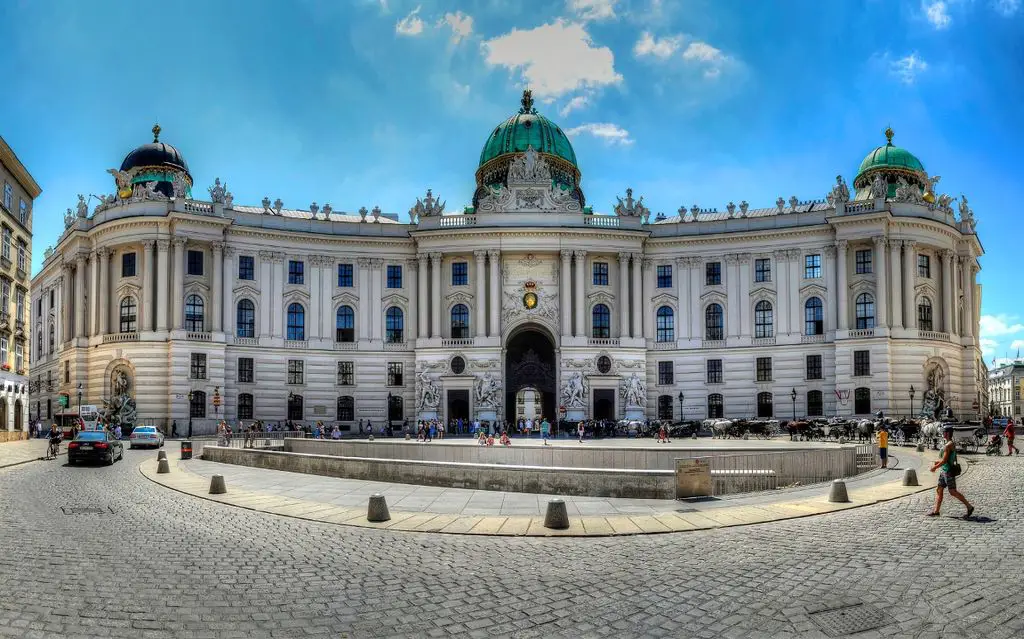
Vienna Hofburg has up to 30 separate attractions, including squares and monuments, castles and apartments, historical museums and priceless collections. The palace complex is so large-scale that it is hardly possible to study all its external and internal objects in one visit. Today, in the castle, every tourist has the opportunity to purchase an excursion, during which the Imperial Apartments, the Sisi Museum and the Imperial Silver Collection will be presented. We will tell you in detail about the walk around the palace below, and to get an idea of the sights, let’s briefly plunge into its history.
Historical reference
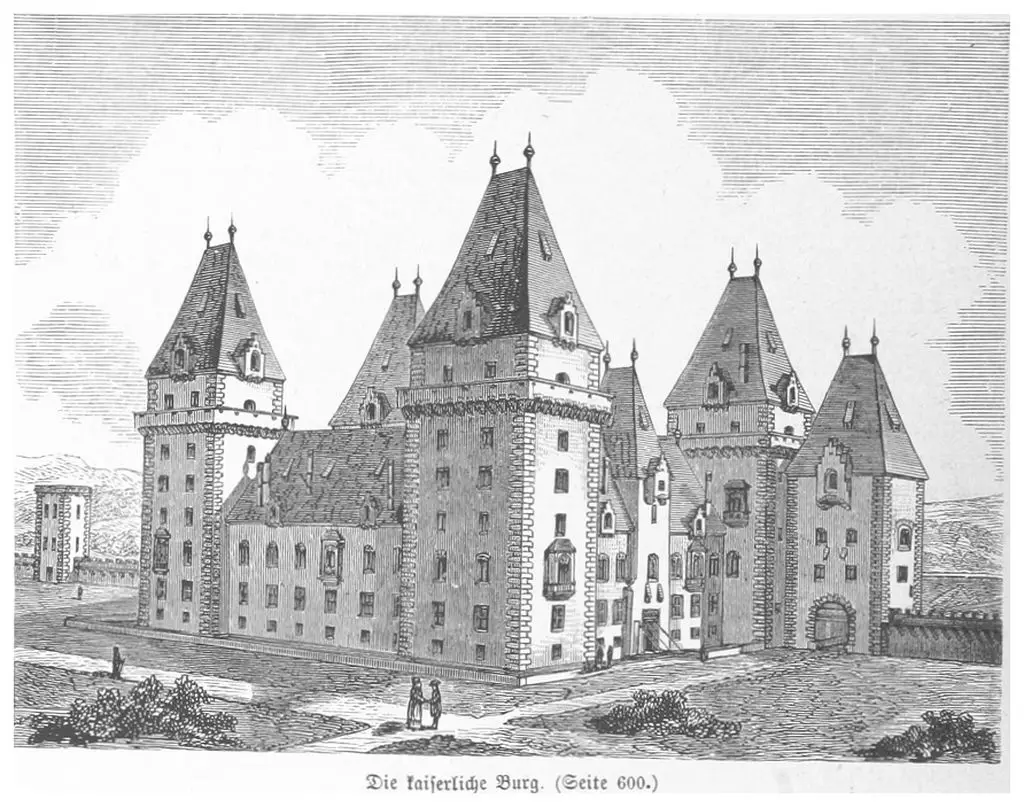
For more than 6 centuries, the Hofburg Palace in Vienna served as the winter residence of the Austrian rulers and was the center where the history of not only Austria, but all of Europe was made. Until the 13th century, a medieval fortress towered here, which subsequently began to expand the ruling emperors. Of course, the Habsburg royal dynasty, which ruled the Austrian state from the beginning of the 13th century until 1918, when the monarchy crashed, made the greatest contribution to the prosperity of the palace.
Related entries:
- Tourist’s guide to Sigmund Freud Museum in Vienna
- Top 10 Sultanahmet Istanbul Hotels – where to stay
- Top 9 most interesting Alanya attractions in Turkey
- Salzburg Cathedral: 6 Useful Travel Tips
The oldest building of the Hofburg was Alte Burg – a centuries-old stronghold, later received a new name – the Swiss wing (Schweizer). In the middle of the 16th century, the famous Swiss Gate was erected in the residence: treasures from the time of the Holy Roman Empire are still stored in this wing.
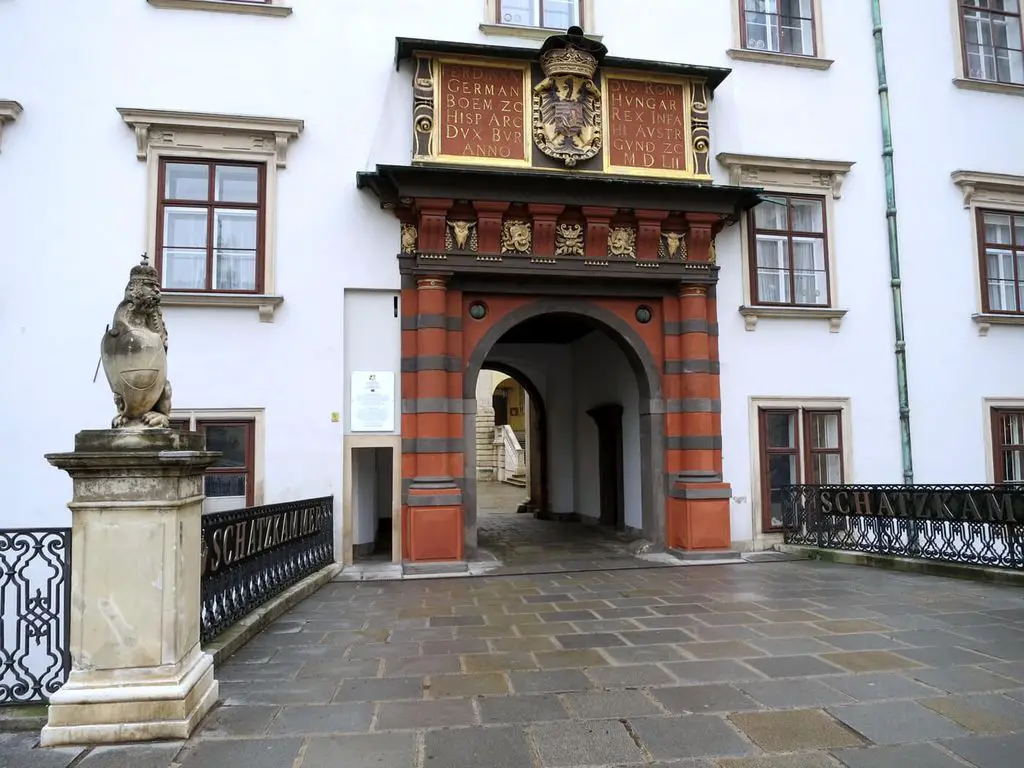
In the 16th century, another separate structure became part of the palace – the Amalia wing, which received this name thanks to Wilhelmina Amalia, who lived here after the death of her husband, Emperor Joseph I. The last royal person to occupy these chambers was Empress Elizabeth: today these premises are located in open access for all guests of Vienna. In the 17th century, Emperor Leopold I decided to link Schweitzer and Amalia’s residence with a new building (Leopoldin’s wing). Today, this building is used as the office of the Austrian president, and tourists cannot get inside.
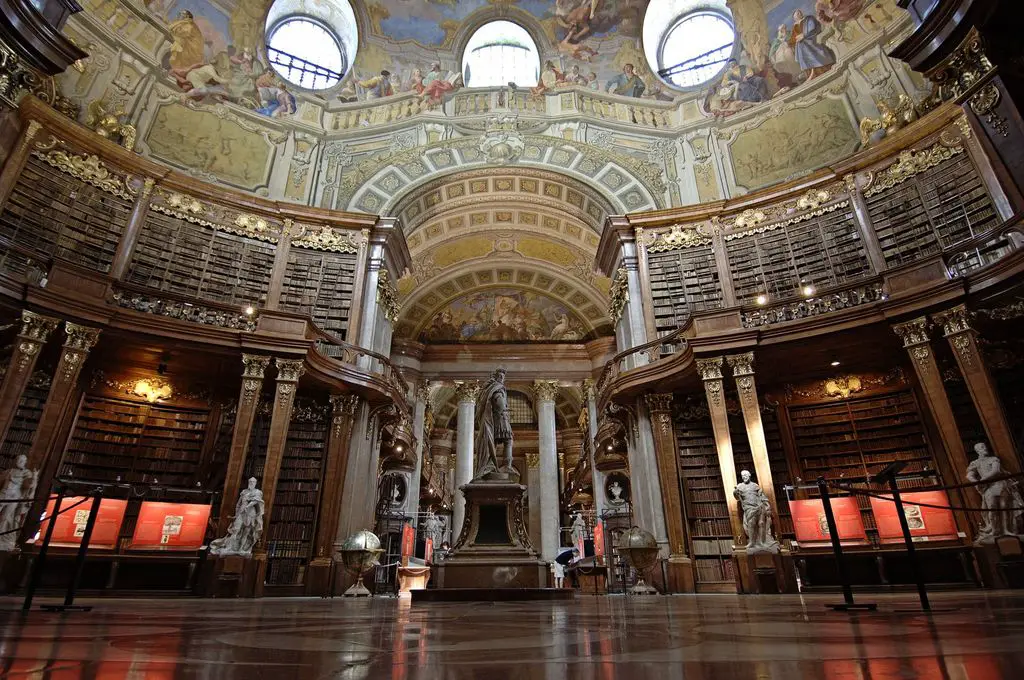
In general, for the 18-19 centuries. many notable structures were erected at the Hofburg in Vienna, such as the Austrian National Library, the Imperial Chancellery and the wing of St. Michael. In the same period, a pompous Hall of Ceremonies appeared, which to this day serves as a venue for balls in the Hofburg. At the beginning of the 20th century, shortly before the collapse of the monarchy, the New Hofburg was rebuilt with a monumental facade and a unique architectural bend, which now houses part of the National Library, as well as a number of collections and museums.
What to see inside the palace
Today, travelers have a unique opportunity to travel back to the time of the Habsburgs and get acquainted with the life of prominent family members. Inside the Hofburg, visitors are invited to inspect three remarkable objects at once. All of them are in the wing of the Imperial Chancellery and conveniently follow one after another. What can be seen in the walls of this part of the Hofburg in Vienna?
Sisi Museum
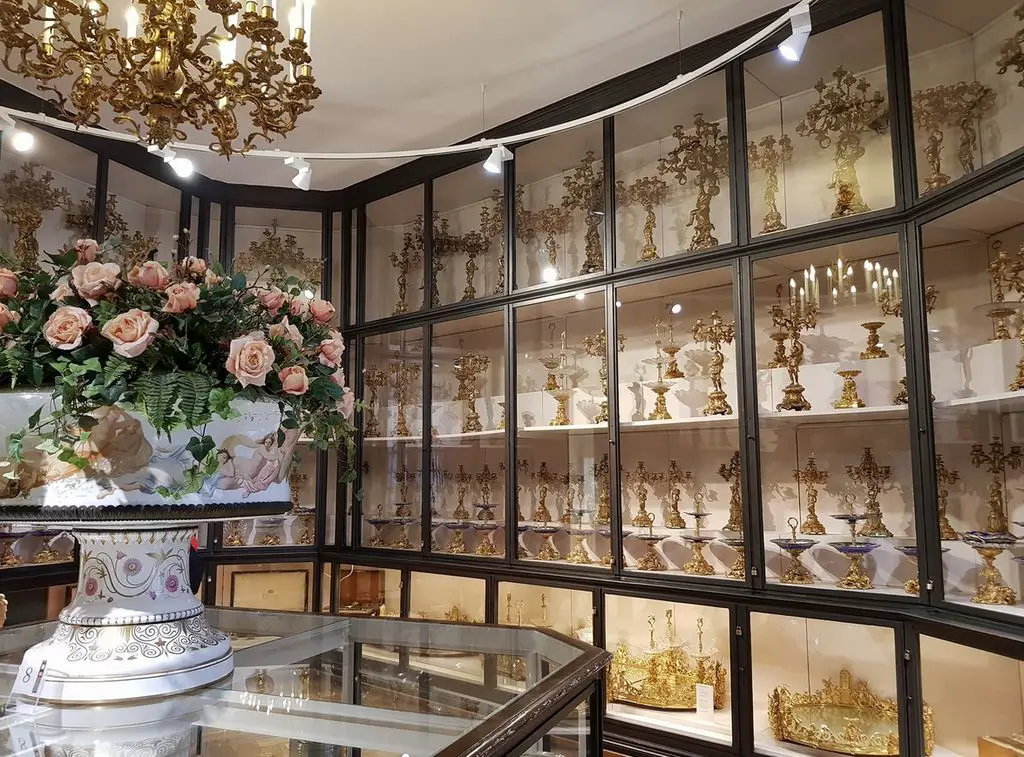
The Sisi Museum is dedicated to the life and work of Empress Elizabeth of Bavaria, the wife of Emperor Franz Joseph I. For decades, she was considered the most charming and attractive queen in Europe. Sisi’s life (this is what the empress was called in the family circle) was full of tragic events: an autocratic mother-in-law, fearing to lose power over her son, controlled every step of the young daughter-in-law and limited her communication with children. Elizabeth often became depressed and exhausted, but fate dealt the greatest blow to her when her son, Crown Prince Rudolph, committed suicide. The empress died at the age of 60, and her death was no less dramatic: while walking around Geneva, the empress was attacked by the anarchist and plunged a sharpener into her heart.
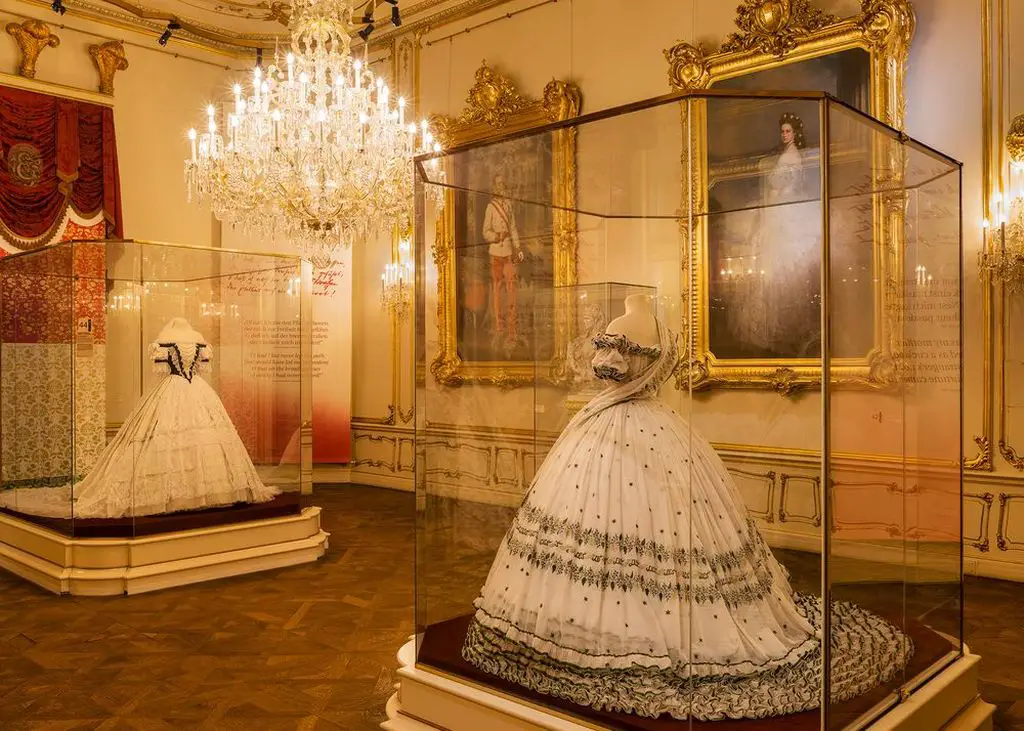
Today, the Hofburg Palace in Vienna offers everyone to visit the Sisi Museum, where more than 300 personal items of the Empress are collected. Among them you will find various accessories (umbrellas, gloves, etc.), cosmetics, a first-aid kit and even a genuine death certificate. The collection also features Elizabeth’s outfits: a dress tailored especially for coronation in Hungary is of particular interest. Here you can see both the black cloak that covered the empress after the murder, and her mourning jewelry. In general, the transformation of the queen from a cheerful and cheerful young girl into a depressed and unsociable woman is clearly visible in the exhibits.
Imperial Apartments
Since the Hofburg in Austria in Vienna was the main winter castle of the Habsburgs, each family member and his retinue provided their own apartments. Today, some of these rooms are transformed into museums, but most of the rooms are used for the offices of statesmen. Access to tourists in these parts of the palace is closed. But the wing of the Imperial Chancellery, which housed the apartments of the last ruler and his family, is open to the public.
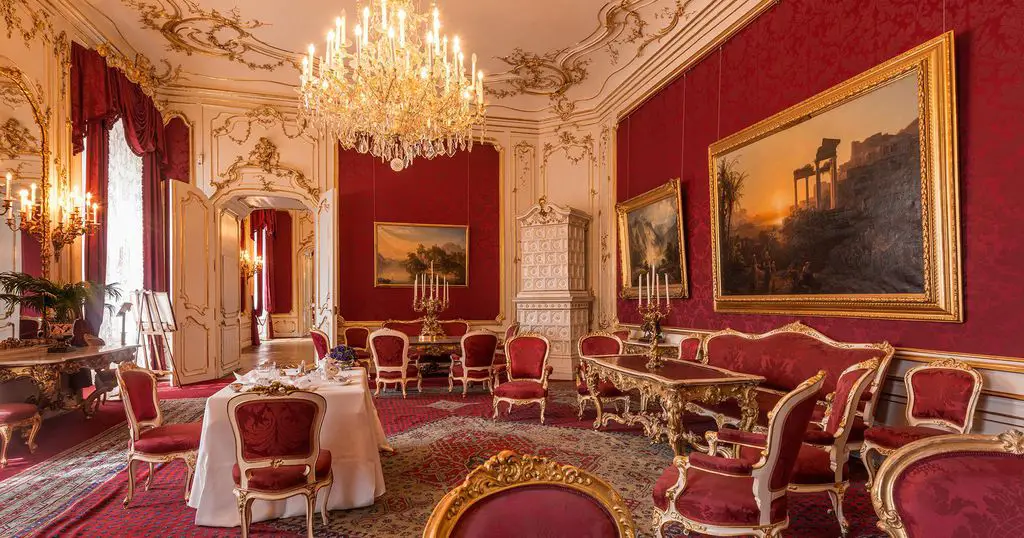
Most of the furniture presented on the premises dates from the second half of the 19th century. But ceramic stoves, which can be seen in many rooms of the palace, were installed in the 18th century. Until the 20th century, lighting in the Imperial Apartments was provided by thousands of candles placed on chandeliers made of Czech crystal (after they had electricity).
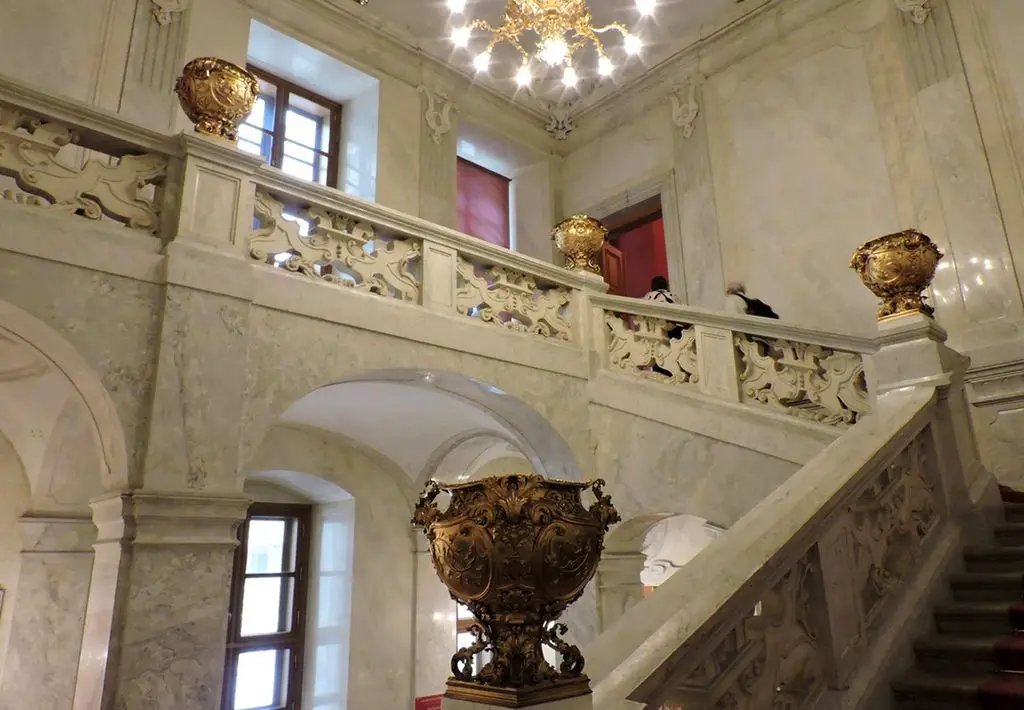
The apartment is accessed by a luxurious marble staircase, decorated with carved railings and gold goblets. Next you will be greeted by an audience waiting room, the interiors of which are decorated with paintings by the artist Johann Kraft. Well, then you find yourself in the reception room itself.
Audience hall
It was here that Emperor Franz Joseph received visitors who came to the sovereign, some for pardon, and some with thanks. As a rule, the audience lasted only a few minutes, which allowed to speak with the maximum possible number of petitioners, which amounted to more than 100 people daily. In total, during his reign, Franz Joseph received at least 260 thousand visitors.
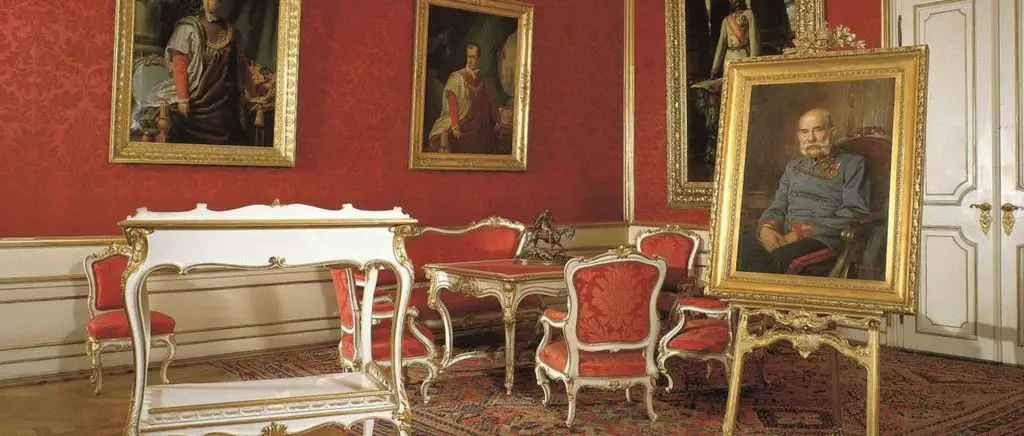
The decoration of the room is presented mainly in red shades with gilded motifs. The room is decorated with numerous paintings depicting both Franz Joseph himself and his predecessors. And the ceilings and walls are decorated with patterns of gold stucco.
Conference room
Another noteworthy room where meetings were held led by the emperor. Its interior is dominated by white and turquoise colors, as well as gilding. Several paintings flaunt the walls, among which a portrait of Franz Joseph at the age of twenty deserves attention. And right below him is a bust of his mother, Archduke Sofia.
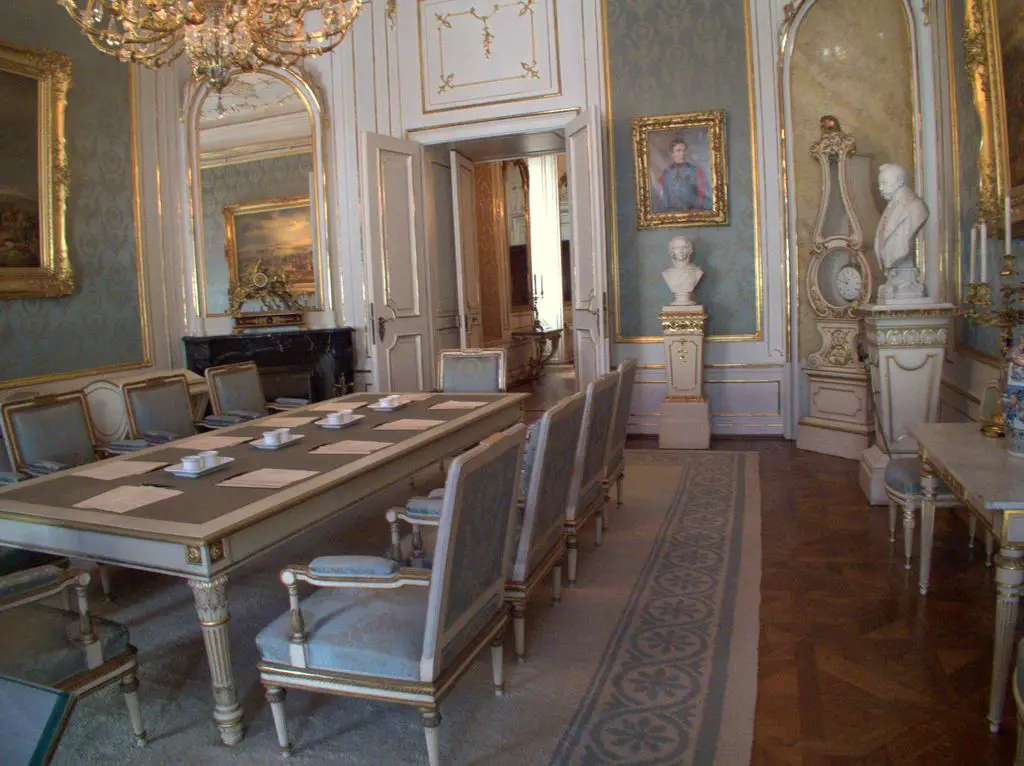
Cabinet and bedroom of the emperor
The office served Franz Joseph as a workplace and a living room, so here you can see several family photo cards. Above the fireplace is a portrait of Alexander II, the Russian emperor, who personally was friends with the Austrian sovereign and supported him in the fight against Hungarian uprisings. The ruler’s bedroom is distinguished by a very modest setting: a small bed, a chair for prayers, a chest of drawers and a night table. In addition, here you can see several photos and art portraits of his wife Elizabeth and mother Sofia.
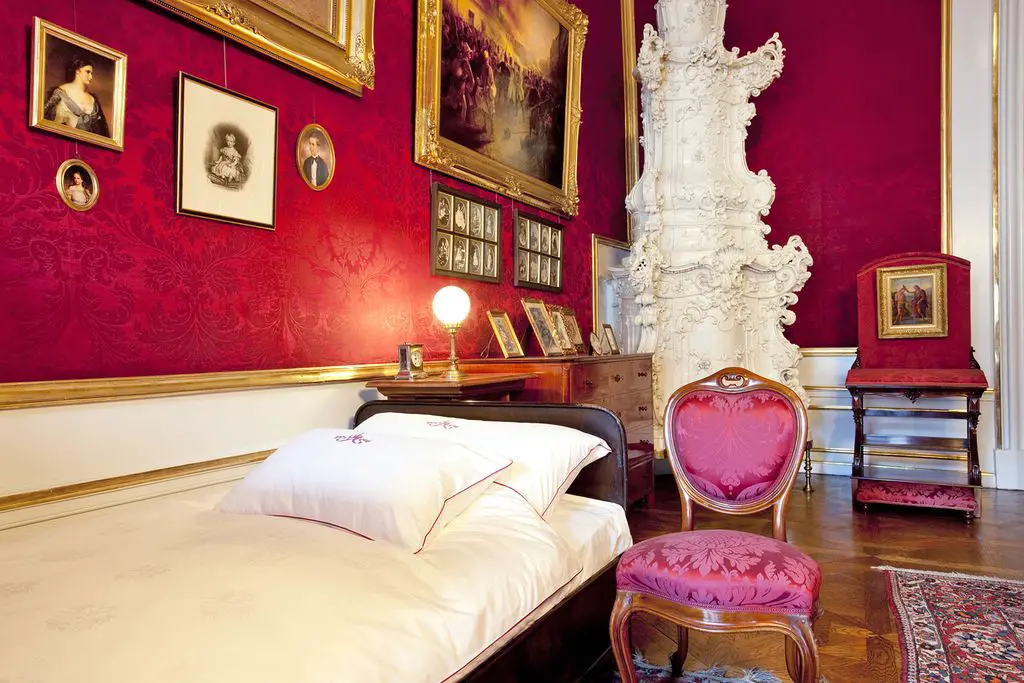
Find out RATES or book any accommodation using this form
Large lounge
The spacious room, buried in burgundy and gilded decoration, served as a meeting place for family members. Of greatest interest here is a canvas depicting Franz Joseph, written in honor of his 50th anniversary. The portrait of Crown Prince Rudolph, created shortly before his suicide, also adorns the room.
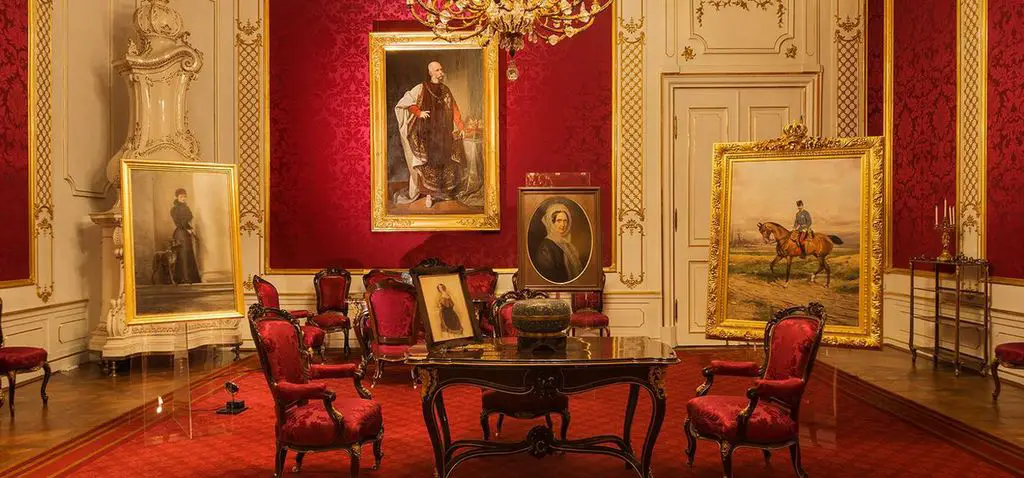
Chambers of Elizabeth
In the Hofburg photo in Vienna you can see many rooms related to the activities of the Austrian sovereign. But when visiting the Imperial Apartments, it is also worth paying attention to the premises where Elizabeth once lived. First of all, this is the Grand Salon of the Empress, where Sisi gave an audience. Of interest is her dressing room, decorated with wallpaper with tropical landscapes. The Empress’s restroom, where the original decor has been preserved, will show you how the royal people took baths.
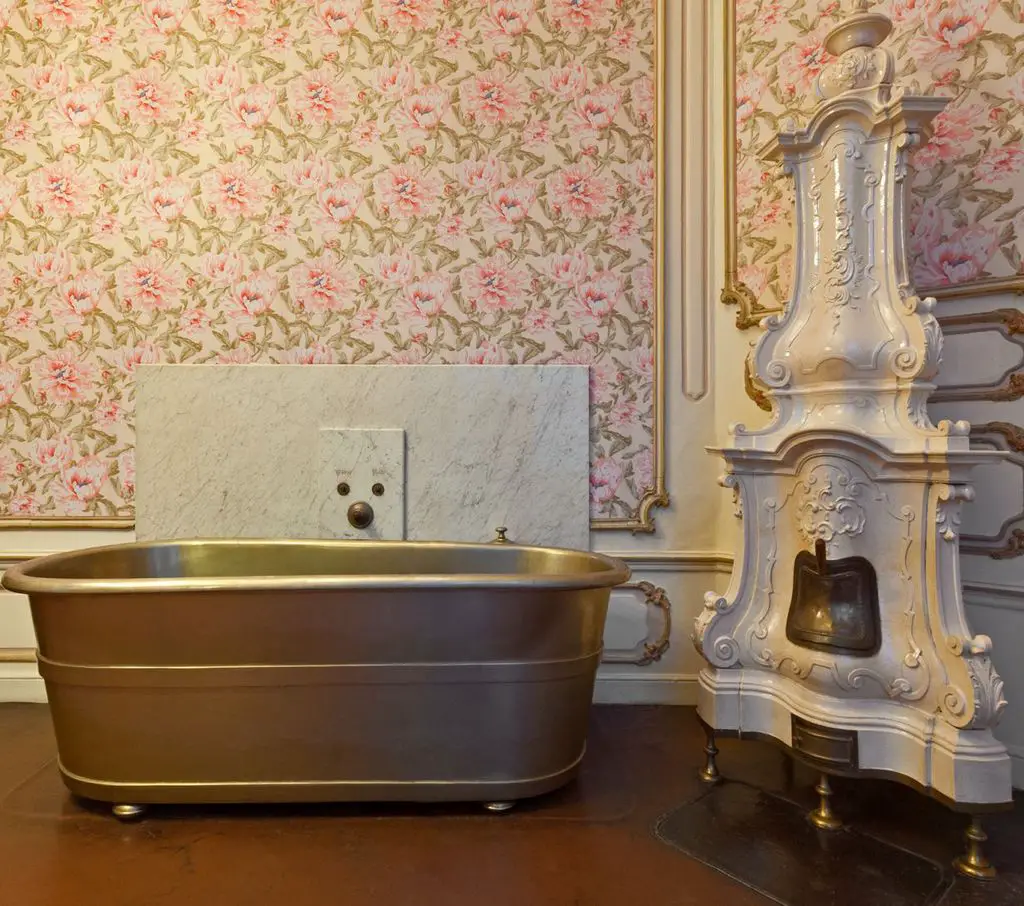
Chambers of Alexander I
In Hofburg you can see the apartments of the Russian emperor Alexander I, who lived in the palace in 1815, when the Vienna Congress was held here. Especially luxurious is the Red Salon, decorated with elaborate French tapestries.
Imperial Silver Collection
Although after the fall of the monarchy, most of the treasures of the palace in Vienna were sold out by the new authorities, nevertheless they managed to preserve a lot of valuable household items of the imperial family, which today are transformed into museum exhibits. The collection includes porcelain, glass and silver dishes, once used for serving the table of Austrian sovereigns.
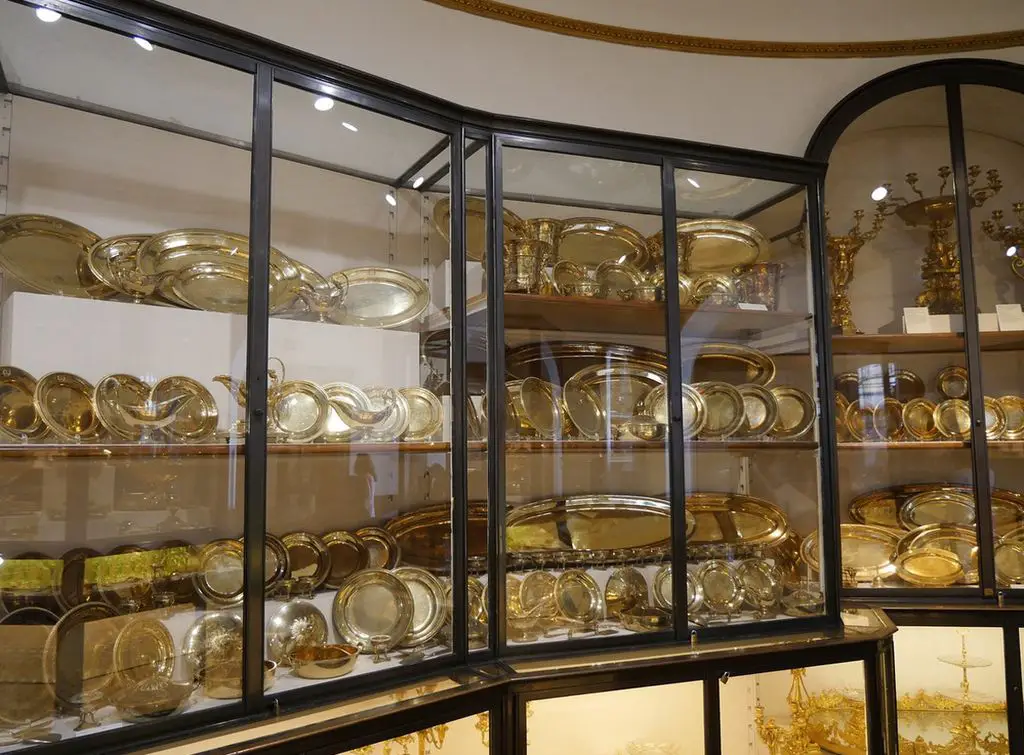
The most skillful ensemble in the collection can be safely called the Central Milan table – a masterpiece of gold with allegorical figures dedicated to Italy. The Minton dessert service, which consists of 116 details, is striking: it is not just a kitchen accessory, but a real work of art. The collection includes many plates with floral patterns, porcelain sets from various European countries and beautiful silver utensils. It is noteworthy that all this dishes was purchased by the imperial persons themselves or came to them as a gift.
How to get there
If you still do not know how to get to Hofburg, then we inform you that it is quite easy to do this using public transport. There are bus and tram stops near the palace, and metro stations are nearby.
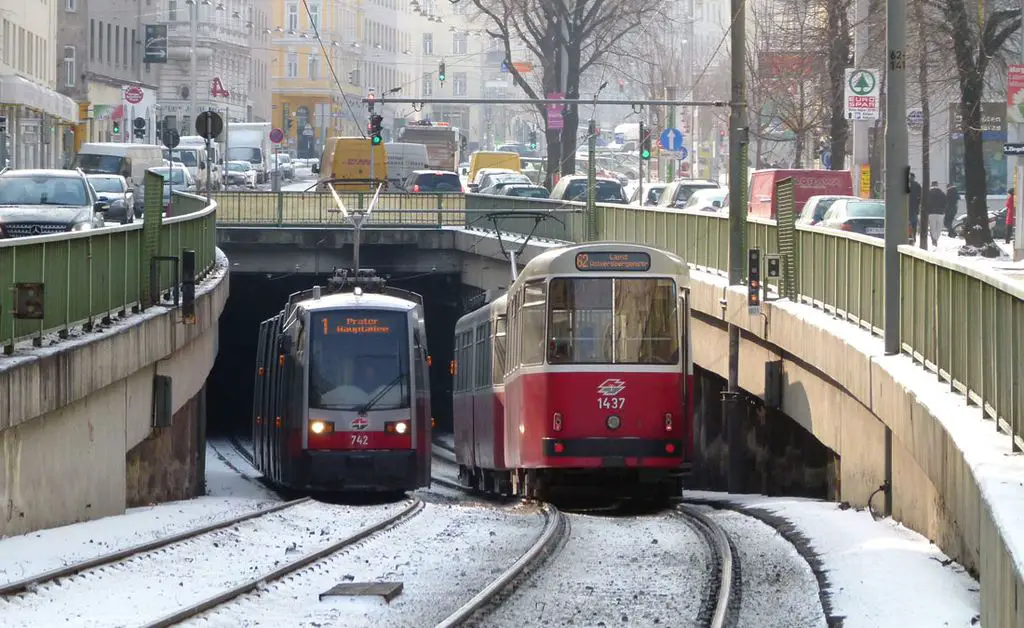
To reach the place by metro, use the U3 line and land at the Herrengasse station. You can also take the train following U1 and get off at the Stephansplatz stop.
In the immediate vicinity of Hofburg, trams 1, 2 and D stop at the Burgring station. Bus 57A also arrives. The palace can also be reached by buses 2 A and 3 A, having landed at the Hofburg stop.
Compare Housing Prices Using This Form
Practical information
- Address: Michaelerkuppel, 1010 Vienna, Austria.
- Official website: www.hofburg-wien.at
- Opening hours: from June to September from 09:00 to 18:00, from October to May from 09:00 to 17:30.
Cost of visiting
* The Sisi ticket is valid for a year and provides an opportunity to visit not only the above-mentioned objects, but also the Schönbrunn Palace, as well as the Furniture Museum in Vienna.
Prices are for January 2019.
Useful Tips
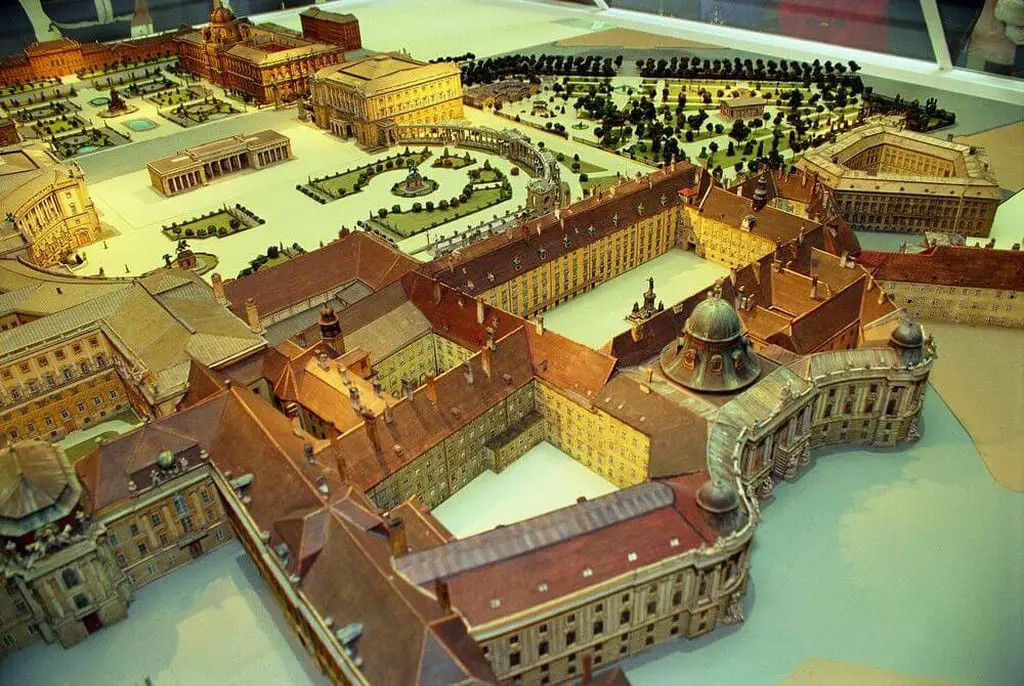
- The Hofburg in Vienna is really massive, so try to set aside at least 3 hours to visit the palace complex.
- If you plan to visit several sights in Vienna (by the way, we recommend that you look into the Hofburg library), then Vienna pass can save you money. Firstly, it opens the entrance to more than 60 places, and secondly, with it you can use Vienna’s public transport for free. The cost of a pass for 1 day is 59 €, for two – 89 €, for three – 119 €, for six – 154 €.
- If you want your walk around the palace to be as informative as possible, do not be stingy and buy a guided tour.
When visiting the Hofburg Palace (Vienna), remember that you can only take pictures in the halls of the Imperial Silver Collection. This is strictly prohibited in the apartments and the Sisi Museum.
Leave a Comment
Save my name, email, and website in this browser for the next time I comment.
LIFESTYLE & TRAVEL BLOG IN VIENNA
The hofburg imperial palace complex in vienna, austria.
Last Updated on March 30, 2024 by gregor
The Hofburg Imperial Palace in Vienna, Austria is one of the most beautiful and well-preserved architectural landmarks in Europe. The Hofburg Palace was built in the 13th century and has since been the home of some of the most powerful rulers in Austrian history, home to the Habsburg Monarchy. Today, the Hofburg Palace is a popular tourist destination, as it houses several museums, art galleries, and historical exhibits.
So what’s the Hofburg Palace?
The Hofburg was the primary residence of the Austrian Empire’s rulers, and today it houses several museums and other attractions. Among these are the Sisi Museum , dedicated to Empress Elisabeth (commonly known as “Sisi”), and the Spanish Riding School, where visitors can watch performances by the world-famous Lipizzaner stallions.
Plan your Trip to Vienna?
- 🏨 Find the perfect accommodation on Booking.com
- 🎡 Book the Best Guided Tour on GetYourGuide
- 😍 Get more emotions from your trip with Tripadvisor
- 🚘 Rent a car on Rentalcars
- ✈️ Buy the cheapest flight tickets with WayAway
- 🚂 🚌 ✈️ Best prices for Train, Buses, Cars, Ferries, and flights Omio
What can you visit in Hofburg Palace?
The Hofburg is a palace in Vienna, Austria that was once the home of the Austrian imperial family. Today, the Hofburg is a complex of buildings that house several museums, including the Imperial Apartments, the silver collection, and the Spanish riding school. Visitors to the Hofburg can also take guided tours of the palace complex or watch a performance by the world-famous Vienna Boys’ Choir.
Book your Tickets here:
How do i get to hofburg.
Visiting the Hofburg Imperial Palace, a top attraction in Vienna, Austria, is straightforward, especially when you know the best ways to get there:
- Public Transportation : This is the most efficient method to reach the Hofburg Palace. It’s conveniently located within a short walking distance from key subway and tram stops. If you’re arriving from the airport, the train to Landstrasse/Wien Mitte station brings you close to the palace.
- Driving : While driving to the palace is an option, finding parking can be a challenge due to limited and pricey parking spaces. Nearby public parking garages fill up fast. A practical alternative is to park at one of Vienna’s Park & Ride facilities and use public transport to get to the palace.
Using these tips, accessing the Hofburg Imperial Palace can be hassle-free, allowing you more time to enjoy your visit.
VIENNA’S PUBLIC TRANSPORTATION SYSTEM – GETTING AROUND IN VIENNA
Hofburg Palace: Our most recommended tours and activities
If you’re looking for the best tours and activities at Hofburg Palace, you’ve come to the right place! Here are our top three recommendations:
1. Tour the imperial apartments and learn about the Habsburgs’ lavish lifestyle.
2. Visit the Sisi Museum to see the personal belongings of Empress Elisabeth of Austria.
3. Visit the Silver Collection (Silberkammer) with its Imperial porcelain, crockery, cutlery, cooking utensils, and (astonishing) table decor
The Imperial Apartments: Franz Joseph
Emperor Franz Joseph, I was the Emperor of Austria and King of Hungary, ruling from 1848 until he died in 1916. He was a popular monarch and is known for his many reforms that helped modernize Austria. The Hofburg Imperial Palace was his primary residence, and the Imperial Apartments were where he lived with his family.
The apartments are located on the second floor of the palace and consist of a series of interconnected rooms. They are lavishly decorated, with opulent furniture and tapestries. Many of the rooms have views of the cityscape or gardens.
The apartments were originally built for Emperor Charles VI in 1720 but were renovated during Franz Joseph’s reign. Today, they are open to the public as a museum, giving visitors a glimpse into the life of one of Austria’s most famous rulers.
The Imperial Apartments: Empress Elisabeth (Sisi Museum)
The rooms in which Empress Elisabeth lived are on the second floor of the west wing. They consist of a suite of reception rooms, bedrooms, and private chambers. The apartments are lavishly furnished and decorated with tapestries, paintings, and sculptures. Empress Elisabeth spent a great deal of time in her chambers, where she wrote poetry and worked on her embroidery.
Read my complete visitor’s guide of the Sisi Museum here (Plus the Best Tips for your visit):
THE EMPRESS SISI MUSEUM IN THE HOFBURG IN VIENNA
The Hofburg Palace Silver Collection
One of the highlights of the palace is its silver collection, which consists of over 3,000 pieces of silverware that were used by the Austrian royal family. The collection includes a wide variety of items, from everyday utensils to ceremonial objects.
The silver collection is housed in the palace’s Schatzkammer (treasure room), which is also home to other valuable artifacts, such as crown jewels and ancient weapons. Visitors can see the Schatzkammer by taking a guided tour of the Hofburg Palace.
Tips and Tactics: How to Make the Most of Your Visit to Vienna’s Hofburg Palace
To ensure you fully enjoy your trip, consider these practical tips:
- Buy Tickets Early : Secure your ticket before your visit to bypass the long lines, heading directly to the security check.
- Check Out Palace Events : The palace often hosts events like concerts and balls. Planning your visit around these events can add a unique layer to your experience.
- Opt for a Guided Tour : A guided tour is invaluable for discovering the palace’s must-see spots, such as the Imperial Apartments and Silver Collection.
- Dedicate Enough Time : The palace spans over 2 million square feet, so give yourself ample time to wander and explore.
- Dress Smartly : Remember to dress in a manner that respects the palace’s grandeur and history.
Your Vienna Pass advantage
With your Vienna Pass, you’ll enjoy free entry to the Hofburg Palace, as well as many other amazing attractions in Vienna. Plus, with the Vienna Pass app, you can easily navigate your way around the palace and make the most of your visit.
So don’t wait any longer, get your Vienna Pass today and start exploring all that this incredible city has to offer!
Book your Pass here:
Plan your visit to hofburg palace.
The Hofburg Palace is comprised of numerous buildings and courtyards, so it can be overwhelming at first. Start your visit by exploring the Imperial Apartments, which give you a sense of what life was like for the royal family. Next, head to the Sisi Museum to learn about Empress Elisabeth, one of the most famous members of the Habsburg dynasty. Finally, don’t miss a chance to see the Crown Jewels in the Treasury.
If you’re interested in art, be sure to visit one (or all!)
Best Time To Visit Hofburg Palace
Deciding on the best time to visit Vienna, including the Hofburg Imperial Palace, involves a few key considerations:
- Palace Opening Days : The Hofburg Palace is closed on Mondays. To ensure you don’t miss out, plan your visit for any other day of the week.
- Vienna’s Weather : The city’s weather changes with the seasons. For warmer temperatures and longer days, consider visiting between May and September. Those who prefer cooler weather and don’t mind shorter days might find October to April more to their liking.
- Tourist Seasons : Vienna experiences its peak tourist season from May to September. During these months, the city, including major attractions like the Hofburg Palace, can get quite busy.
Keeping these points in mind can help you choose the optimal time for your trip to Vienna, balancing weather preferences and crowd levels for the best possible experience.
How long does it take to visit the Hofburg Palace?
Well, that depends on how much time you want to spend at each individual attraction within the palace complex. For example, if you only want to visit the imperial apartments and the Sisi Museum, then you can probably get through the entire complex in about 2-3 hours. However, if you also want to see the Spanish Riding School or take a tour of the National Library, then you should plan on spending at least 4-5 hours at Hofburg.
In short, there is no right or wrong answer when it comes to how long it takes to visit Hofburg.
Tours and Tickets to Experience Hofburg Imperial Palace (Hofburg Wien)
Visitors can tour the palace and its grounds, which include the imperial apartments, staterooms, and museums. Tickets can be purchased online or at the palace ticket office.
Book your Ticket here:
How much does it cost to go to hofburg.
The cost of admission to Hofburg varies depending on what you wish to see and do while you are there. For example, a ticket to tour the Imperial Apartments costs €15.00 for adults, while a ticket that also includes a visit to the Sisi Museum costs €21.00 for adults. You can also purchase a combination ticket that includes admission to both the Imperial Apartments and the Sisi Museum, as well as a guided tour of the gardens, for €27.00. *)
*) prices may vary
Hofburg Palace Opening Times
The Hofburg Palace is open to the public every day from 9 a.m. to 5 p.m. The last admission is at 4 p.m. The palace is closed on January 1, Easter Sunday, May 1, and Pentecost Sunday, December 25 and 26.
Touring the Hofburg Palace
The Hofburg Palace is the former imperial palace in Vienna, Austria. It was the primary residence of the Austrian emperors from the 13th century until the end of World War I in 1918. The palace complex consists of 18 buildings and 2 courtyards, and it covers almost 60 acres in the city center of Vienna.
The Hofburg Palace is currently used for official ceremonies and events by the Austrian government, and it is also home to a number of museums, including the Sisi Museum and the Imperial Apartments. Visitors to the Hofburg Palace can tour the imperial apartments, see where Empress Sisi lived, and learn about her life and reign. The palace complex also includes a banquet hall, where guests can experience a meal fit for an emperor or empress.
Where to Stay near the Imperial Palace
The Hofburg Imperial Palace is one of Vienna’s top attractions. Located in the city center, the palace is a must-see for any traveler to Vienna. While there are many hotels in the area, these are the top hotels near Hofburg Imperial Palace.
Hotel Sacher is located just a few steps from Hofburg Imperial Palace. The hotel is known for its luxurious accommodations and excellent service. Travelers can enjoy views of the palace from their room or take a short walk to visit the palace grounds.
The Ritz-Carlton Vienna is another top hotel near Hofburg Imperial Palace. This luxury hotel offers guests 5-star accommodations and unmatched views of the city. Guests can also enjoy access to a fitness center and spa during their stay.

History of the Hofburg Vienna
The Hofburg in Vienna is one of the most important architectural ensembles in Austria. It was the imperial palace of the Habsburgs from the 13th century until 1918 and has been home to some of the most important political figures in Austrian history. The complex consists of 19 courtyards and over 2,600 rooms, making it one of the largest palaces in the world.
The Hofburg has been expanded and remodeled over the centuries, incorporating a variety of architectural styles including Gothic, Renaissance, Baroque, and Neoclassical. Today, the palace is home to several museums and cultural institutions, as well as the official residence of the President of Austria.
Redoutensaal at the Hofburg
The Hofburg Imperial Palace in Vienna, Austria is home to the Redoutensaal, a concert and ballroom venue that is one of the most popular tourist attractions in the city. The Redoutensaal was built in 1807 by Emperor Francis I as a space for public events and entertainment. Today, the hall is used for a variety of events such as concerts, balls, and conferences.
The Redoutensaal is a beautiful space with ornate chandeliers and a stunning view of the Hofburg Gardens. If you are visiting Vienna, be sure to add the Redoutensaal to your list of must-see sights!
Festsaal at the Hofburg
The most impressive space in the palace is the Festsaal, or Festival Hall.
The Festsaal is a grand room with a high ceiling supported by massive Corinthian columns. The walls are covered in red velvet and hung with portraits of past Austrian monarchs. Crystal chandeliers light the room, which is used for balls, concerts, and other events.
Zeremoniensaal at the Hofburg
The Hofburg Palace in Vienna, Austria is home to the magnificent Zeremoniensaal. This room was once used for grand imperial ceremonies and is now open to the public for tours.
The Zeremoniensaal is decorated with lavish chandeliers and stunning paintings. Visitors can imagine what it must have been like to attend an imperial ceremony in this regal room.
Today, the Zeremoniensaal is used for special events such as balls, concerts, and conferences. It is a popular tourist destination and a must-see when visiting the Hofburg Palace.
Hofburg Imperial Palace on Map
The Hofburg Imperial Palace is located in the center of Vienna, Austria. It is one of the most important cultural sites in the country. The palace was built in the 13th century and has been the home of Austrian rulers for centuries. Today, the palace is a popular tourist destination. Visitors can tour the many rooms and corridors of the palace, and see some of the most important art collections in Austria.
Sisi Museum Digital
The Hofburg Imperial Palace in Vienna, Austria is now home to the Sisi Museum , a new digital museum that tells the story of Empress Elisabeth of Austria. The museum uses cutting-edge technology to bring the Empress’s story to life, using interactive displays and audio-visual presentations to transport visitors back in time.
Tours & tickets near Hofburg – Imperial Palace
The Hofburg Imperial Palace is one of the most popular tourist attractions in Vienna, and there are a number of tours and tickets available to help visitors explore the palace and its grounds. The Imperial Tour is a guided tour that takes visitors through the palace’s public rooms, while the Secret History Tour gives visitors a behind-the-scenes look at some of the palace’s more private areas. There are also a number of self-guided tours available, as well as tickets for the imperial gardens and the Hofburg Theatre.
Is the Hofburg Palace worth visiting?
Many visitors to Vienna come to see the Hofburg Palace, but is it really worth visiting? YES!
There is no denying that the Hofburg Palace is a beautiful complex of buildings. The architecture is stunning, and there are many interesting things to see inside the palace. However, some visitors find the palace to be too big and overwhelming. There are also many other things to see and do in Vienna, so some visitors may not think that the Hofburg Palace is worth their time.
In the end, whether or not the Hofburg Palace is worth visiting depends on what you are interested in and what you want to get out of your visit to Vienna.
What museums are at Hofburg?
Hofburg Imperial Palace is a historic building in Vienna, Austria. It was the principal imperial palace of the Habsburg dynasty rulers and today serves as the official residence and workplace of the President of Austria.
The palace complex consists of 18 wings and 2 courtyards and covers almost 13 acres (53,000 m²). The Hofburg area includes the imperial chapel, the former imperial stables, museums, parks, gardens, and other structures.
The Hofburg has been expanded over the centuries to include several museums. These museums include the Austrian National Library , which is one of the world’s largest libraries; the Museum of Natural History ; the Sisi Museum , which is dedicated to Empress Elisabeth “Sisi” of Austria; and the Imperial Treasury Museum.
In addition to these museums, there are also many art galleries located within Hofburg Palace.
More imperial Locations in Vienna
But the Hofburg Palace in Vienna, Austria is not the only imperial location in the city. There are many other places that were once part of the Austro-Hungarian Empire that is now open to the public. These locations include:
The Belvedere Palace: This palace was built in the early 18th century as a summer residence for Prince Eugene of Savoy. It is now home to a museum with a collection of Austrian art from the Middle Ages to the present day.
The Vienna Opera House: This building was completed in 1869 and was originally known as the Vienna Court Opera House. It was destroyed by fire in 1945 but was rebuilt and reopened in 1955. Today, it is one of the most popular opera houses in the world.
MOST BEAUTIFUL PALACES IN VIENNA – THE MUST-VISIT PALACES IN VIENNA
Related Blog Post
VIENNA BELVEDERE PALACES AND BELVEDERE MUSEUMS, ULTIMATE VISITOR GUIDE
IMPERIAL TREASURY VIENNA, SIGHTSEEING INFO AND TIPS (KAISERLICHE SCHATZKAMMER WIEN)
SPANISH RIDING SCHOOL IN VIENNA – SIGHTSEEING INFO AND TIPS
25 Best Museums in Vienna, Austria, Guide 2024
11 best luxury boutique hotels in vienna to stay.
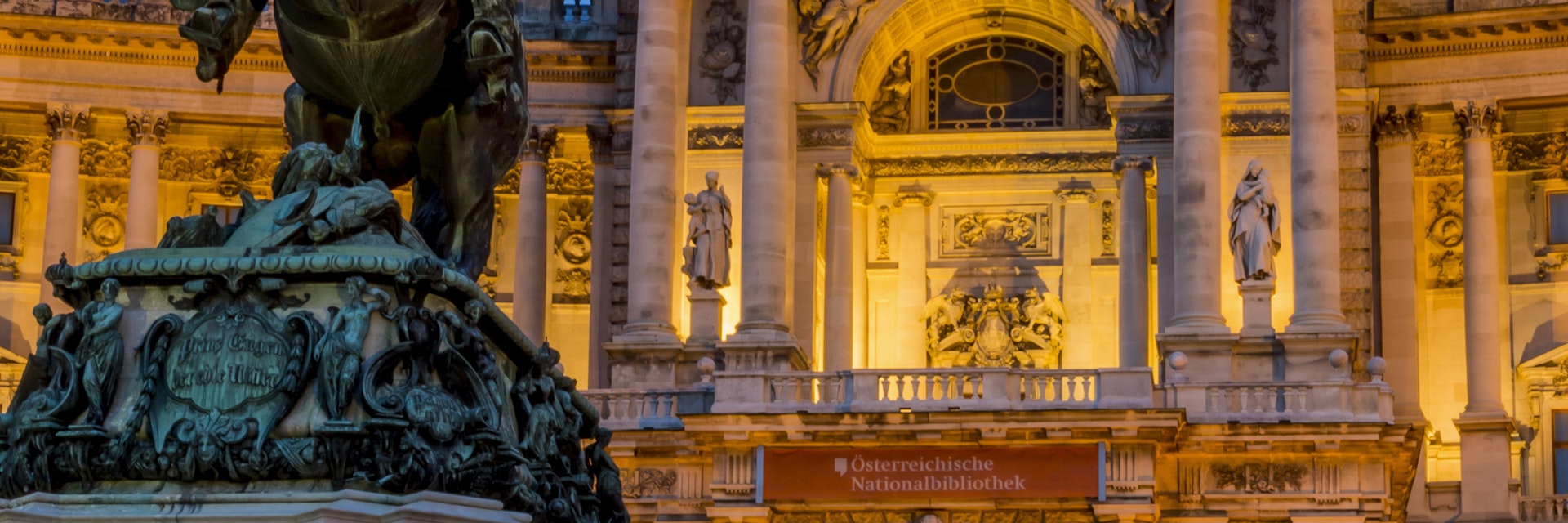
Getty Images/Westend61
Top choice in Vienna
Nothing symbolises Austria's resplendent cultural heritage more than its Hofburg, home base of the Habsburgs from 1273 to 1918. The oldest section is the 13th-century Schweizerhof (Swiss Courtyard), named after the Swiss guards who protected its precincts. The Renaissance Swiss Gate dates from 1553. The courtyard adjoins a larger courtyard, In der Burg , with a monument to Emperor Franz II adorning its centre. The palace now houses the Austrian president's offices, the preserved Kaiserappartements and a raft of museums.
The Hofburg owes its size and architectural diversity to plain old one-upmanship; new sections were added by the new rulers, including the early baroque Leopold Wing , the 16th-century Amalia Wing , the 18th-century Imperial Chancery Wing and the Gothic Burgkapelle (Royal Chapel).
01, Michaelerkuppel
Get In Touch
01-533 75 70
https://www.hofburg-wien.at
Lonely Planet's must-see attractions
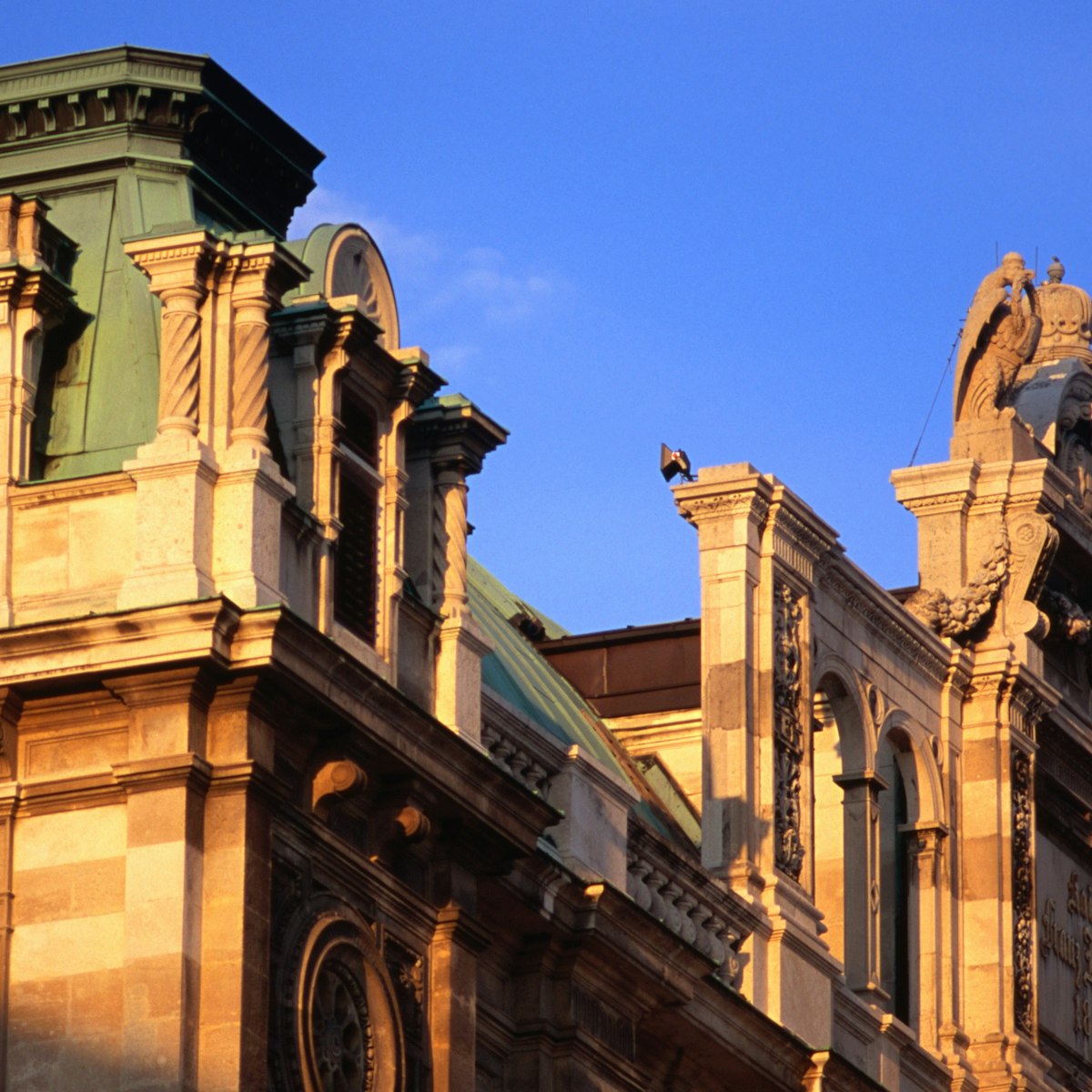
Vienna's foremost opera and ballet venue, the neo-Renaissance Staatsoper, is one of the finest concert halls in the world. Even if you can't get tickets…
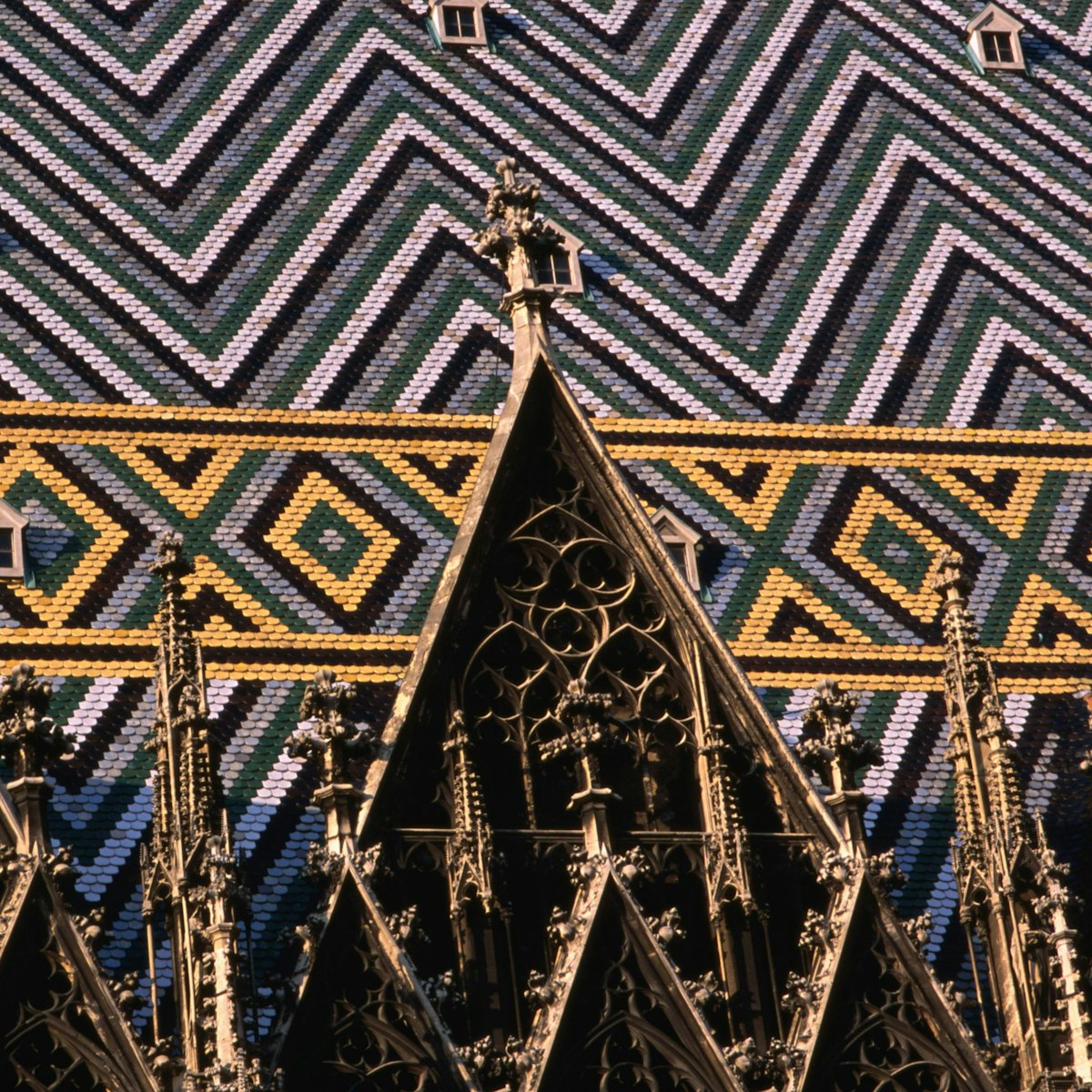
Stephansdom
Vienna’s Gothic masterpiece Stephansdom – or Steffl (Little Stephan), as it’s ironically nicknamed – is Vienna's pride and joy. A church has stood here…
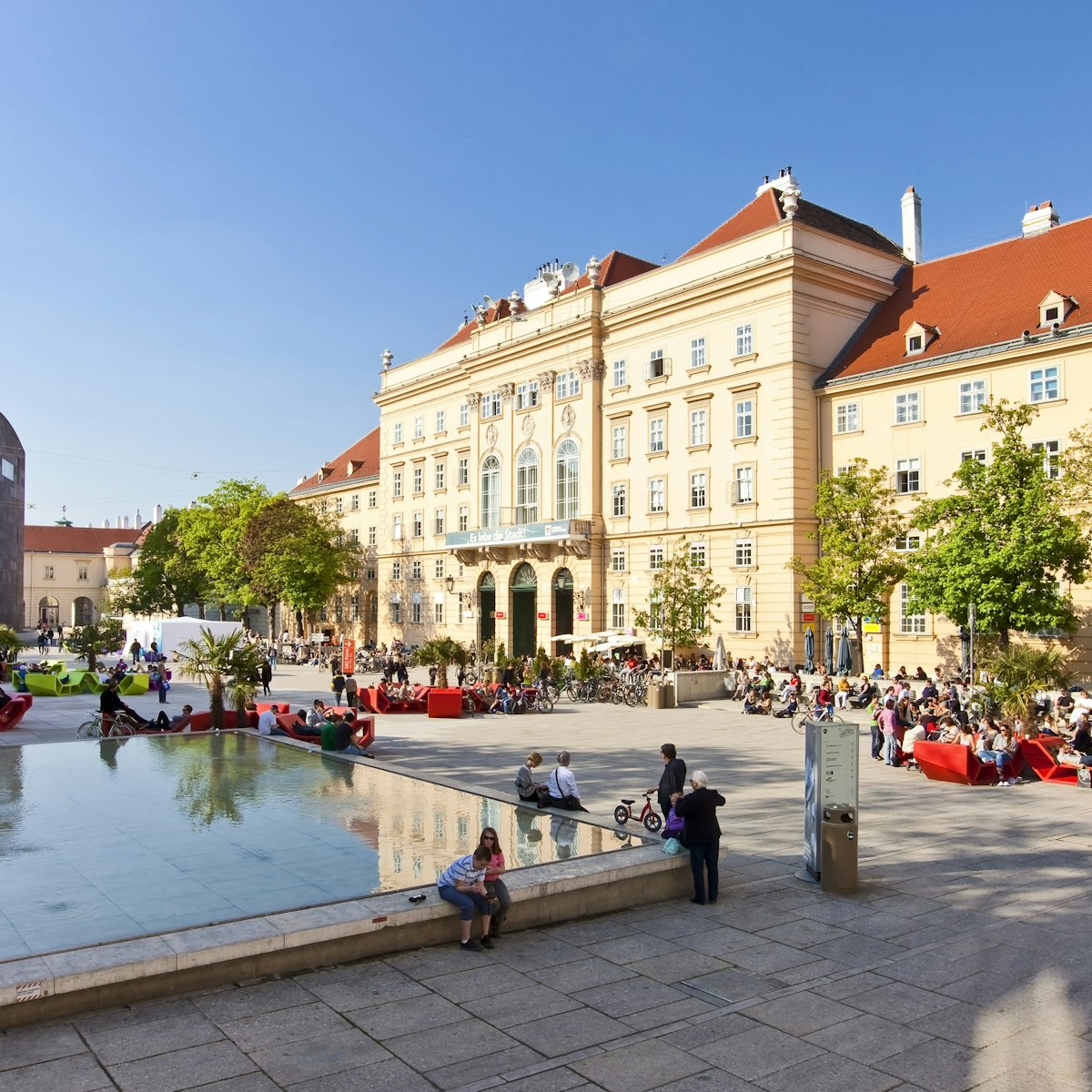
MuseumsQuartier
The MuseumsQuartier is a remarkable ensemble of museums, cafes, restaurants and bars inside former imperial stables designed by Fischer von Erlach. This…
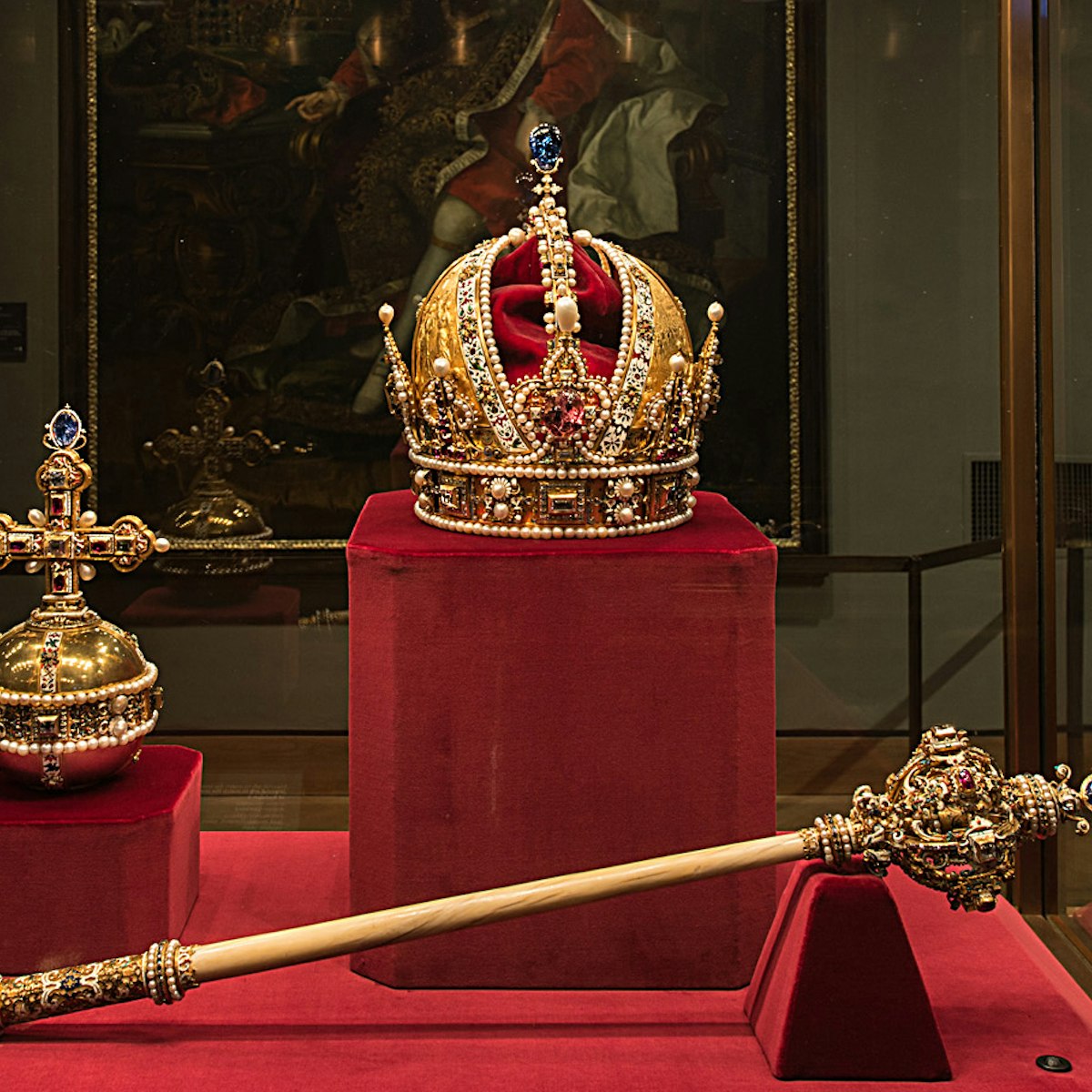
Kaiserliche Schatzkammer
The Hofburg's Kaiserliche Schatzkammer contains secular and ecclesiastical treasures (including devotional images and altars, particularly from the…
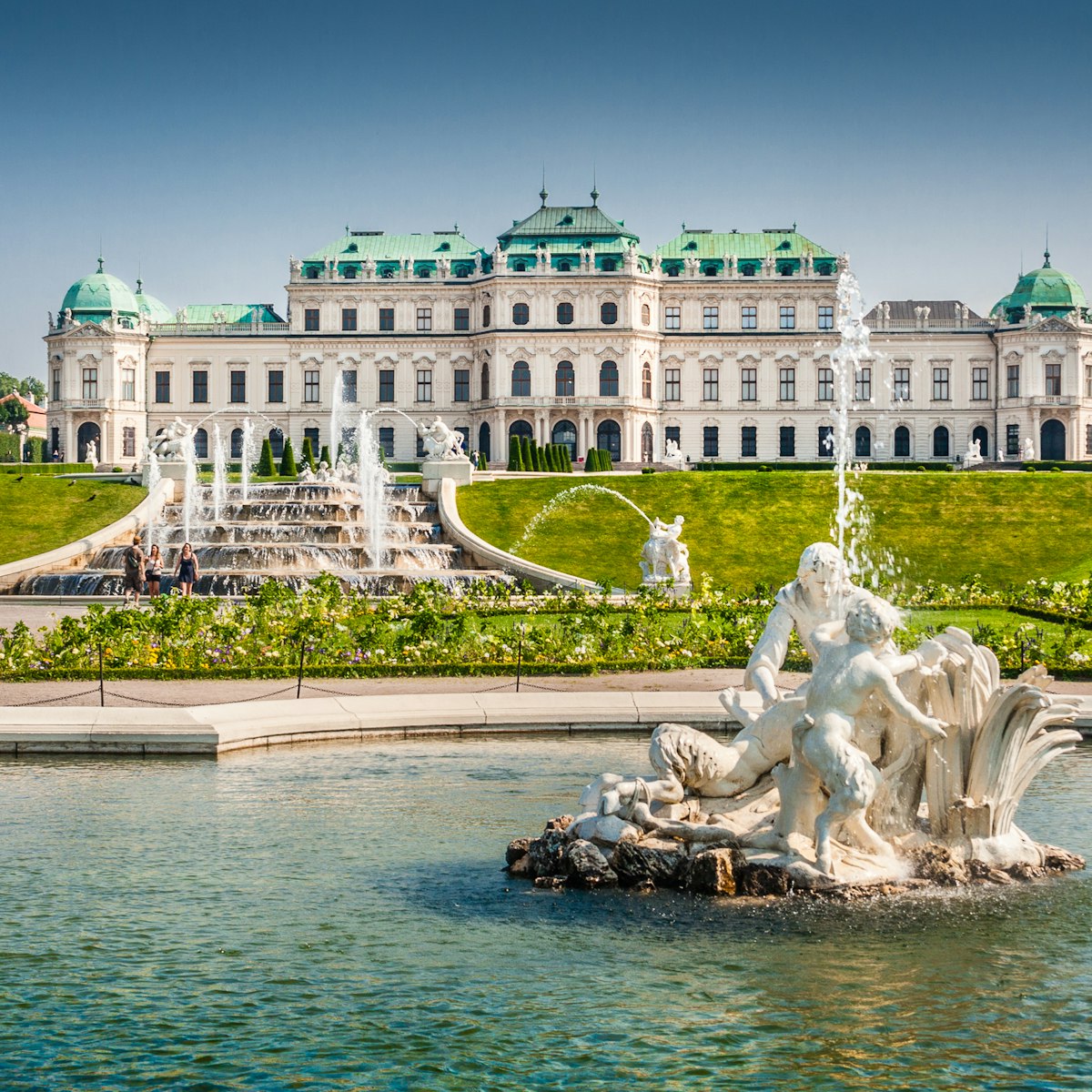
Schloss Belvedere
A masterpiece of total art, Schloss Belvedere is one of the world’s finest baroque palaces. Designed by Johann Lukas von Hildebrandt (1668–1745), it was…
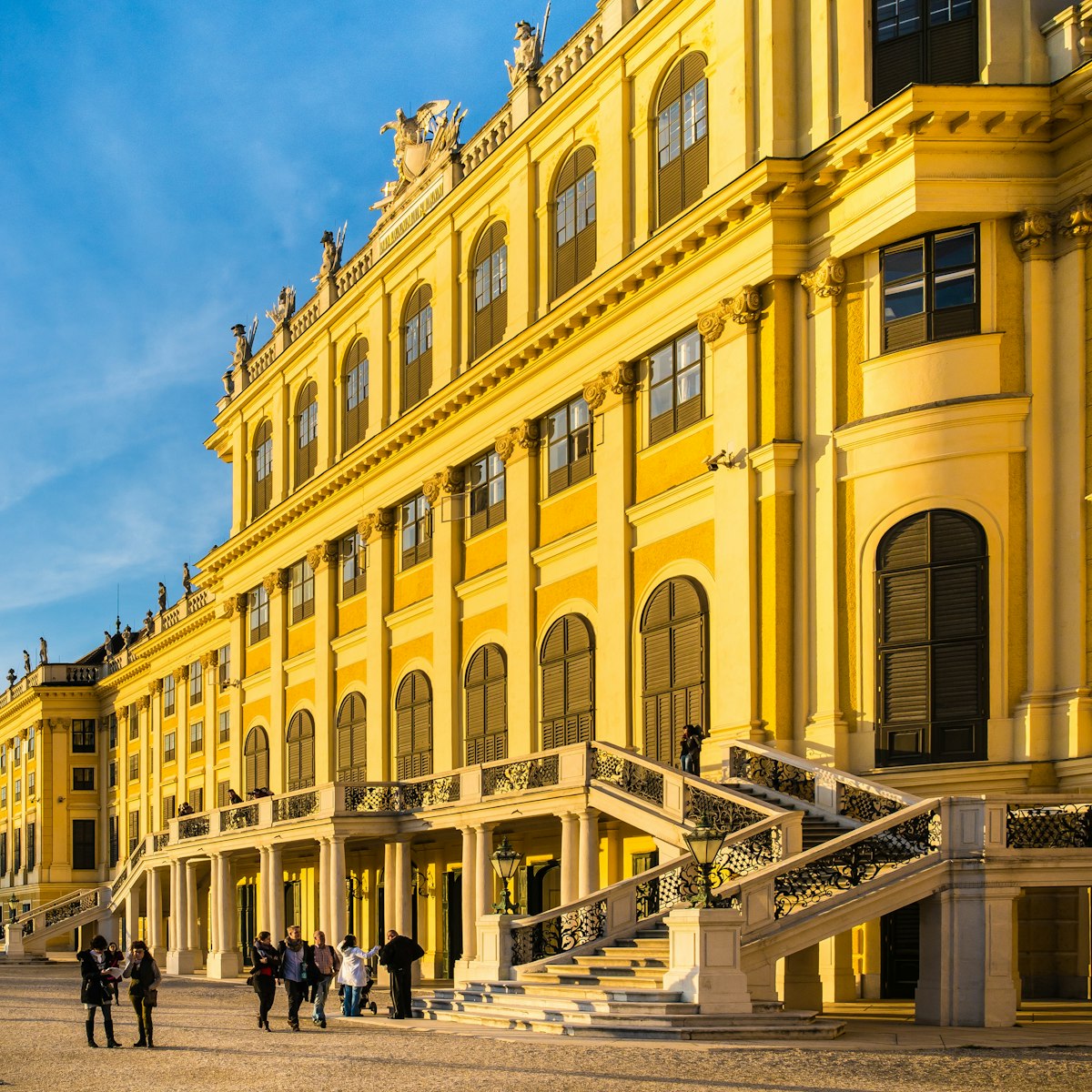
Schloss Schönbrunn
The Habsburgs' opulent summer palace is now a Unesco World Heritage site. Of its 1441 rooms, 40 are open to the public; the Imperial Tour takes you into…
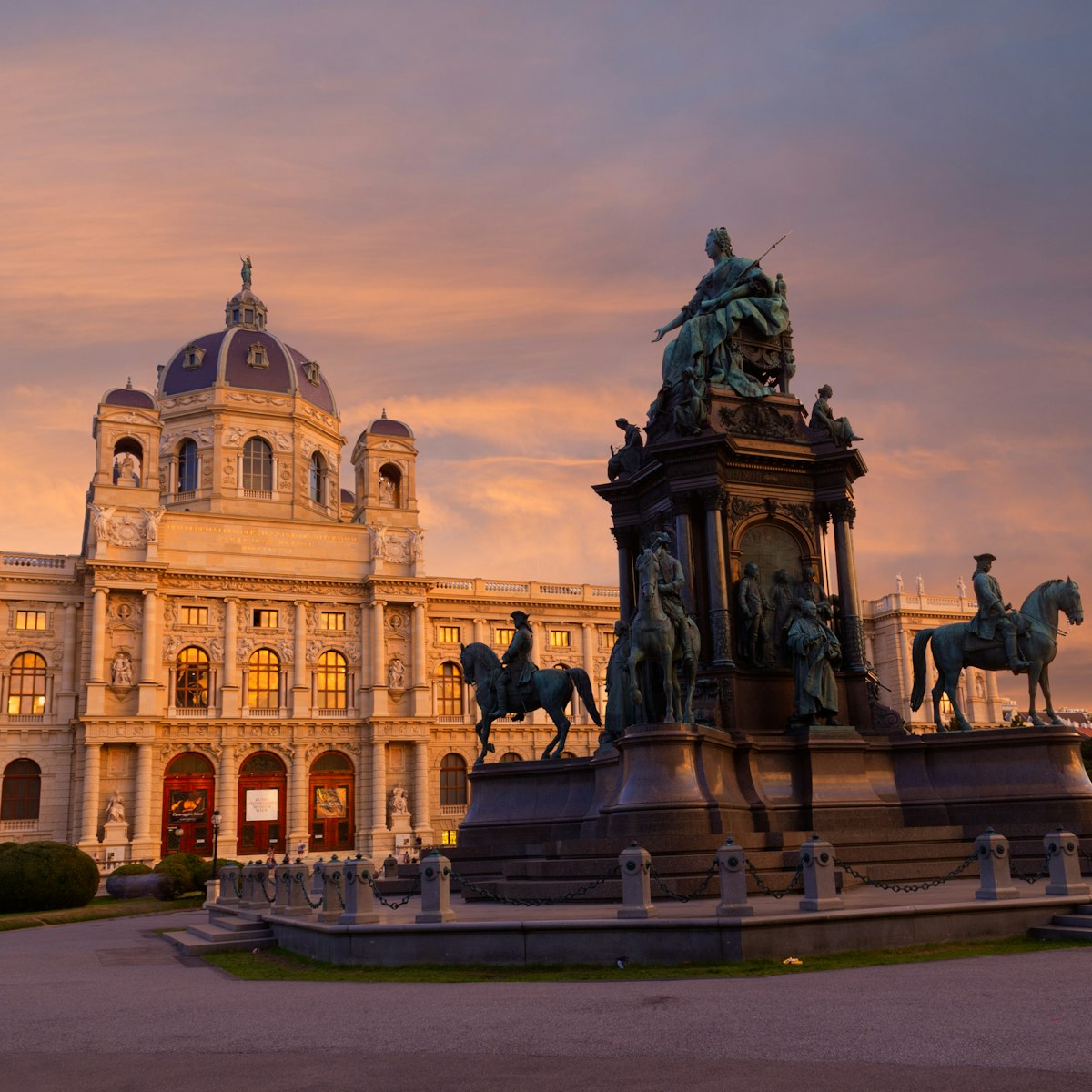
Kunsthistorisches Museum Vienna
A highlight of any trip to Vienna is a visit to the Kunsthistorisches Museum Vienna, brimming with works by Europe’s finest painters, sculptors and…

Kaiserappartements
The Kaiserappartements, once the official living quarters of Franz Josef I and Empress Elisabeth, are dazzling in their chandelier-lit opulence. The Sisi…
Nearby Vienna attractions
1 . Silberkammer
The largest silver service of the Silberkammer at the Kaiserappartements can cater to 140 dinner guests. Multilingual audio guides are included in the…
2 . Sisi Museum
Inside the Kaiserappartements, the Sisi Museum is devoted to Austria’s Empress Elisabeth, affectionately known as Sisi. A partial reconstruction of her…
3 . Kaiserappartements
4 . Burgkapelle
The Burgkapelle originally dates from the 13th century and received a Gothic makeover from 1447 to 1449, but much of this disappeared during the baroque…
5 . Kaiserliche Schatzkammer
6 . Michaelerplatz Roman Ruins
Ringed by gorgeous architecture, Michaelerplatz is centred on Roman ruins that are reputed to have been a brothel for soldiers. This cobblestoned circular…
7 . Loos Haus
Designed by Adolf Loos, this modernist gem put Franz Josef’s nose seriously out of joint when it was completed in 1911. Its intentionally simple facade…
8 . Nationalbibliothek Prunksaal
Austria’s flagship library, the Nationalbibliothek, contains an astounding collection of literature, maps, globes of the world and other cultural relics;…

Guide To Vienna’s Hofburg Palace Complex
The Hofburg Palace was the nucleus of the Habsburg court in Vienna. It functioned not only as a residence, but also as the epicenter of imperial power, administration, and culture.
This magnificent palace complex was where the imperial family lived, worked, and ruled over vast territories of Europe for centuries.
But what makes up the Hofburg Palace today? It’s a collection of former imperial buildings, many of which are among Vienna’s top attractions.
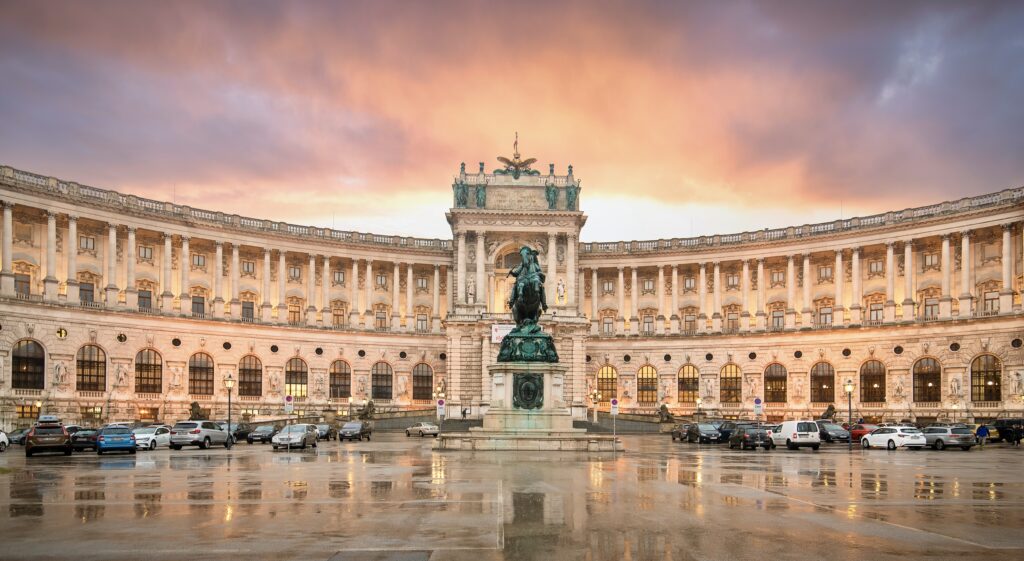
You can visit:
- Palace (imperial apartments, Sisi Museum, and the silver collection)
- Spanish Riding School
- Imperial Treasury
- Imperial Court Chapel
- National Library
- Albertina Museum
There is no general admission ticket for all the sites. There are just individual tickets and combinations ticket.
You can also invest in the Vienna Pass for skip the line access to these attractions, which I highly recommend for convenience and cost savings.
In this guide to the Hofburg Palace, I’ll tell you everything to see.
>>> Click here to book a guided imperial history tour
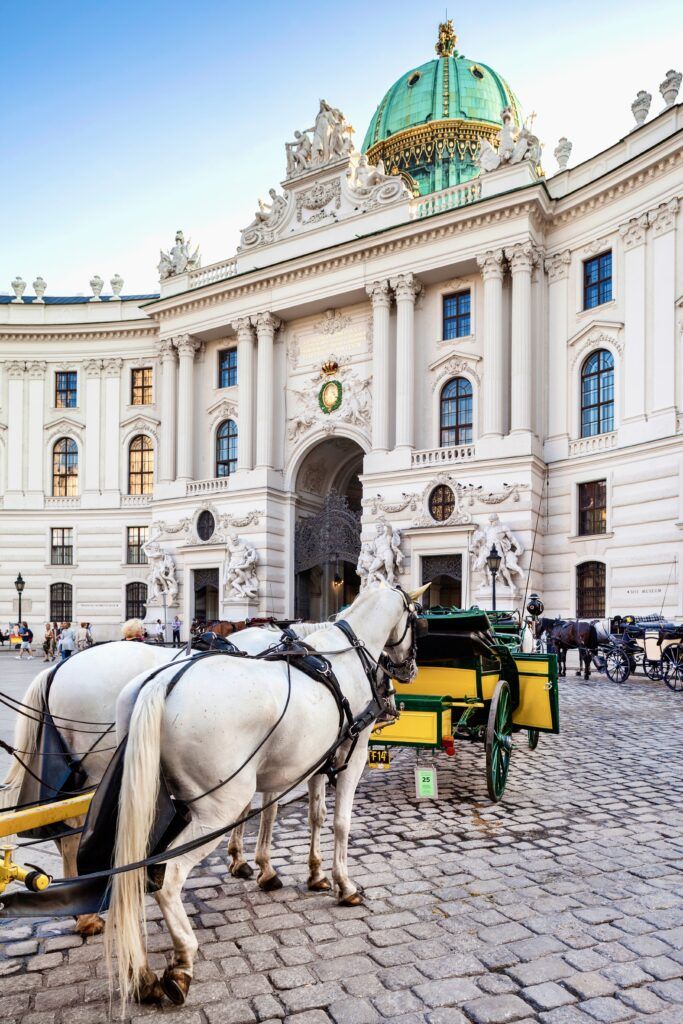
Guide To The Hofburg Palace: What To See
What you general think of as the residential Hofburg Palace has 3 parts: the imperial apartments, the Sisi Museum, and the silver collection.
Imperial Apartments
The Neo-Rococo imperial apartments you’ll see on a visit feature over-the-top ornametation from the era. There’s a lot of gold and red, and it’s all rather severe. The rooms were built for Emperor Franz Joseph and Empress Sisi.
They were an odd pair. Both were workaholics. But Sisi’s tenacity came in the form of getting up early to exercise and focus on her figure and hair.
She’s pitched as a misunderstood empress these days. But she likely was a bit of a narcissist who simply hated court life. For that, I can’t blame her.
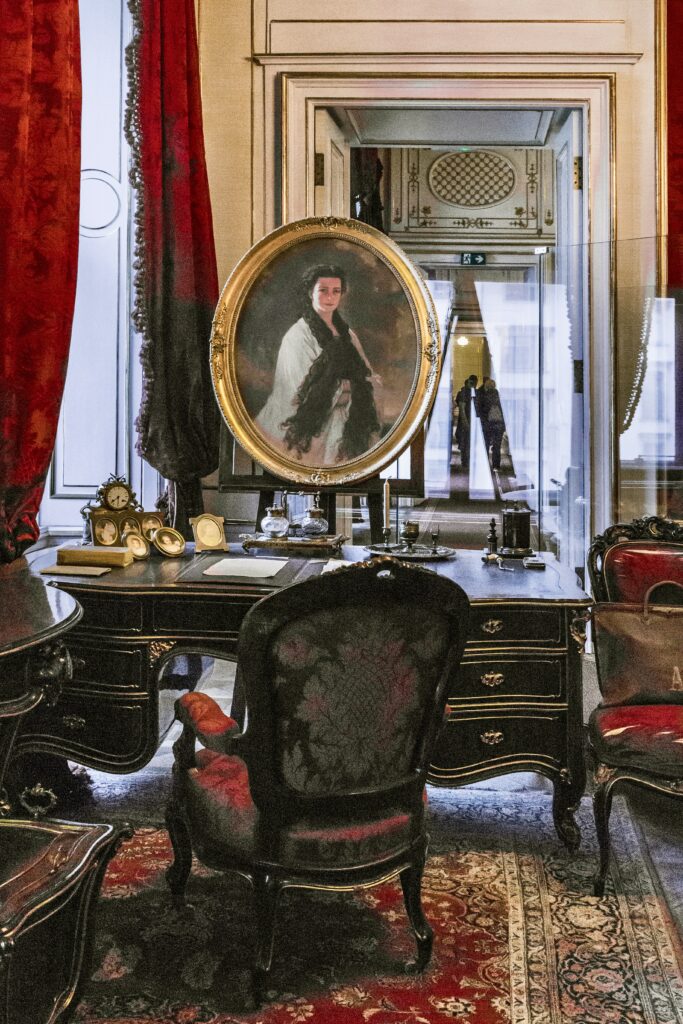
France Joseph’s apartments consist of:
- audience waiting room
- audience chamber
- conference room
- large salon
- small salon
The highlight of Franz’ rooms is his study. There you can see where he toiled day and night. It has some of his favorite portraits of Sisi, including the famous one by Francis Xavier Winterhalter.
In Sisi’s rooms, you can see:
- drawing room & bedroom
- dressing room & exercise room
- Bergl rooms (admire the blue-green landscape murals)
Sisi Museum
The Sisi Museum is a small and intimate space within Hofburg Palace. It’s dedicated to the fascinating life of Empress Elisabeth, consort of Emperor Franz Joseph.
The Sisi Museum made its debut in 2004. It’s a chic and somewhat cult-like atmosphere, dedicated to the devoted fans of Empress Elisabeth.
This unique museum sheds light on the “misunderstood” princess, whose tragic life shares parallels with that of modern-day Princess Diana.
On a visit, you’ll see her personal possessions and effects, ball gowns, portraits, traveling items, hair and beauty items, and other memorabilia.
>>> Click here to pre-book a skip the line ticket
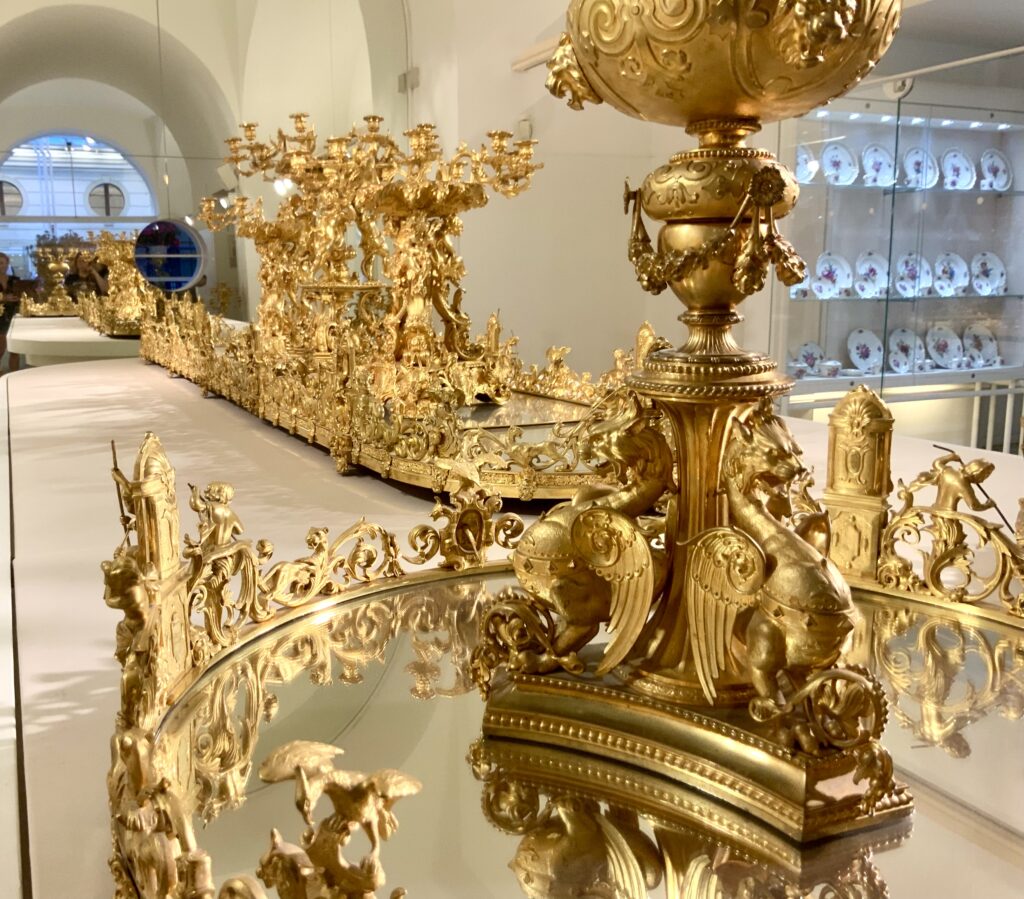
Silver Collection
The Silver Collection is housed in Michael’s Wing.
The most magnificent piece is Grand Vermeil Service, made in Milan and Paris 1808. The word “vermeil” refers to a specific type of gilding process used in silverware. The Hapsburgs used it for state dinners.
Between 1821-24, the Hapsburgs created an interesting Romantic/Neo-Gothic service. It features portraits of the Hapsburgs and their castles.
You’ll also see all brands of porcelain (Sevres, Herend, and Minton), silverware, and ceremonial objects.
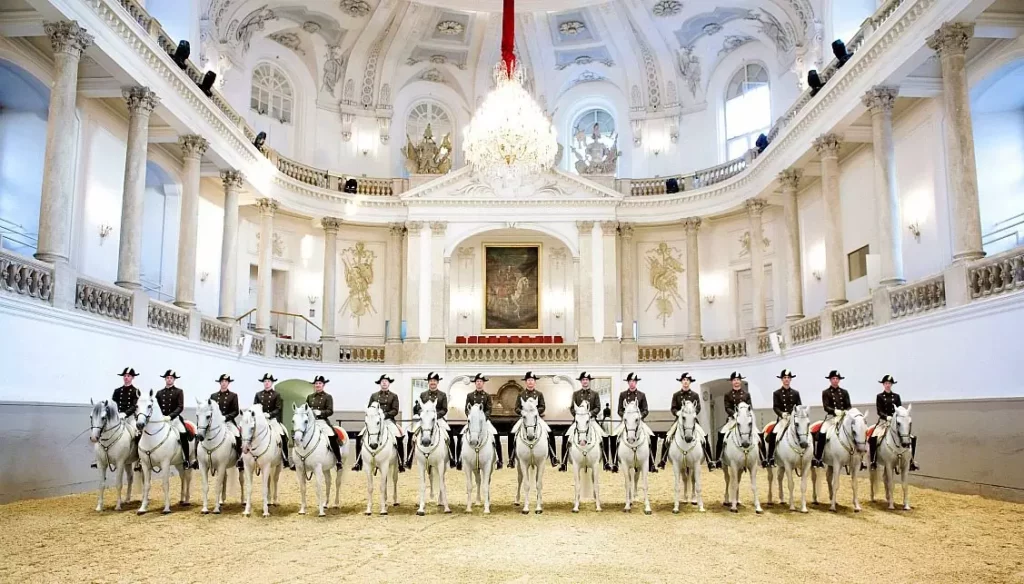
2. Spanish Riding School
The Spanish Riding School is the only place in the world where the Renaissance tradition of training and riding has been maintained and preserved.
It takes 4-6 years to train the white Lippizaner horses in haute ecole dressage. They eventually learn moves liked the pirouettes, the piaffe, and the traversal — all referred to as “airs above ground.”
There are no text books or written instructions. The tradition is handed down by the riders themselves.
Their traditional dress consists of a black, two cornered hat with gold trim, a tailcoat, pleated white buckskin trousers, black boot, and white suede gloves.
This is a wildly popular attraction in Vienna. When I attended a performance, it was packed and people were actually talking to the horses.
There are several ticket options:
- ticket to watch the horses train
- ticket for a performance
- special ticket for a shorter show
- guided tour of the riding school
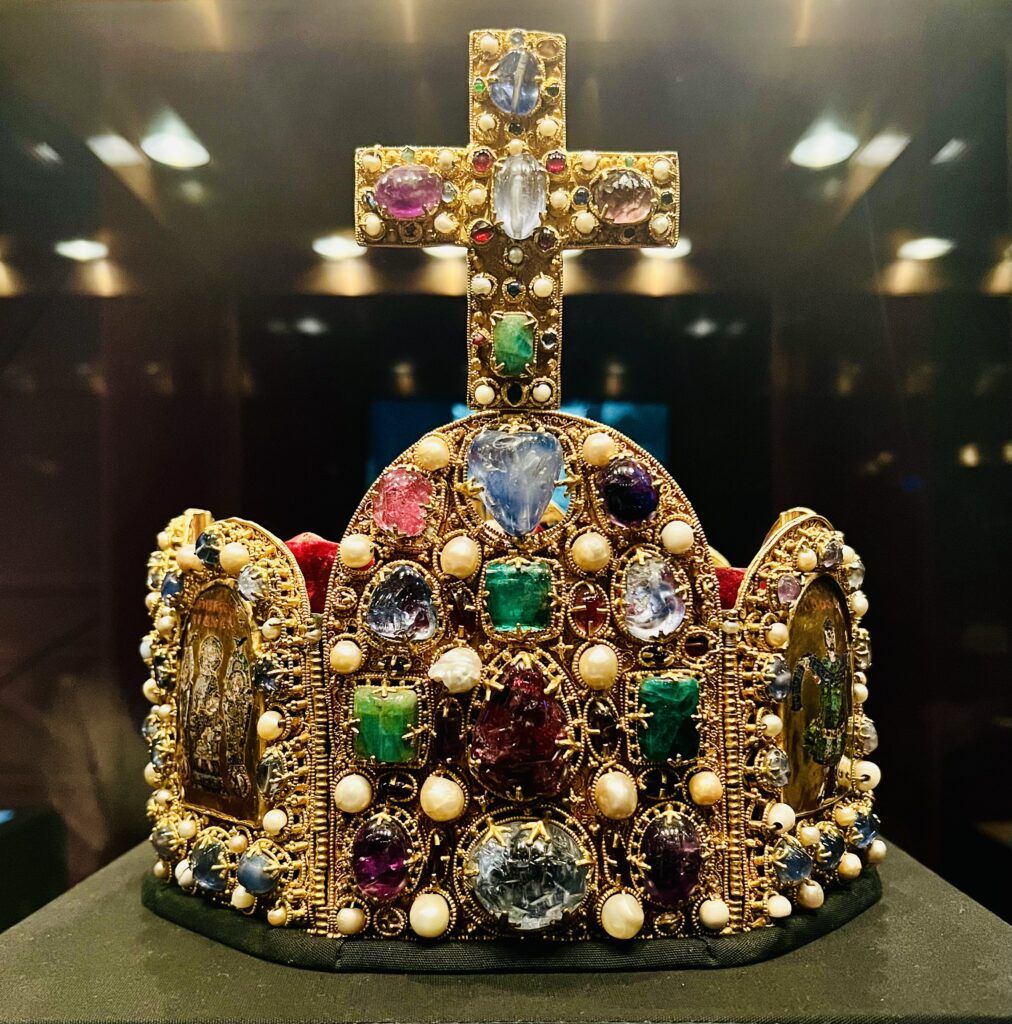
3. Imperial Treasury
This is one of the world’s most important treasuries. It’s chock full of knock-your-eyes-out bling.
It’s akin to seeing the Crown Jewels in the Tower of London. Only it’s better — you can actually take photos!
The royal collection includes fancy jewels, imperial regalia, crowns, scepters, and other priceless artifacts. The museum also houses an extensive collection of religious relics, featuring items like the Holy Lance and the Holy Grail.
The most prized item is the glittering 11th century jeweled crown worn by the Holy Roman Emperors. For more information, you can check out my guide to the Imperial Treasury .
>> Click here to pre-book a ticket
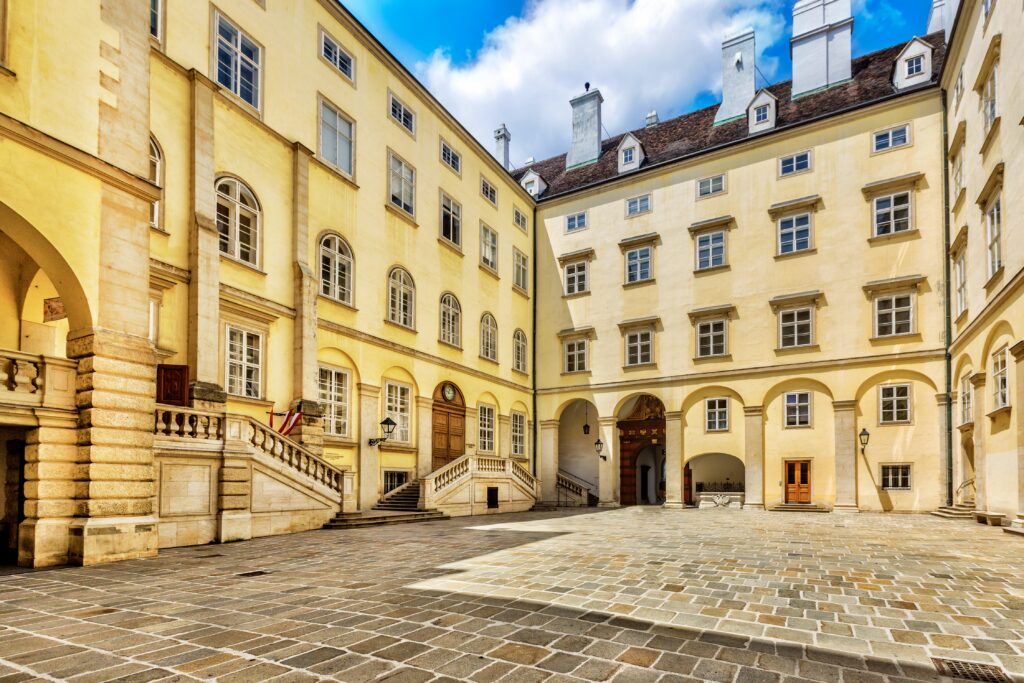
4. Imperial Court Chapel
The Burgkapelle is the oldest surviving part of the Hofburg. it was built in 1447 and is largely untouched since then.
Today, this Gothic structure is home to the Court Music Orchestra and the Vienna Boys’ Choir.
The choir was established during the reign of Maximillian I to sing at religious ceremonies and court events. When the monarchy collapsed in 1918, the choir began touring internationally.
The choir performs masses by Mozart, Schubert, and Haydn every Sunday at 9:15 am from mid-September to June.
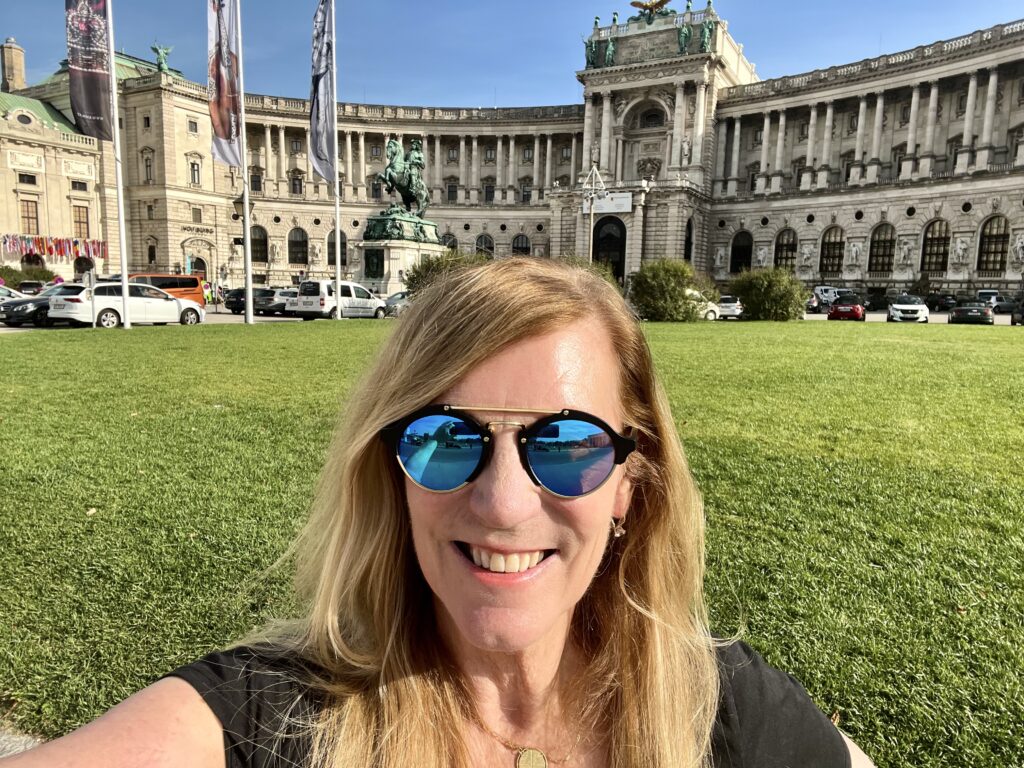
5. Neue Burg
Constructed in the late 19th century, the Neue Burg means “New Castle.” it boasts several styles, including Neo-Renaissance and Baroque Revival. Hitler infamously used the balcony to announce his annexation of Austria.
This part of the palace is home to several museums:
Ephesus Museum
The Ephesus Museum is an archaeological museum that’s an annex of the Greco-Roman antiquities on display in the Kuntshistorisches Museum .
The museum displays archaeological treasures and artifacts from the ancient Roman city of Ephesus, now in modern day Turkey.
Among other things, you’ll find marble and bronze statues, a remarkable frieze of the Parthian Monument, and a sculpture of Artemis of Ephesus.
Here’s my complete guide to the Ephesus Museum .
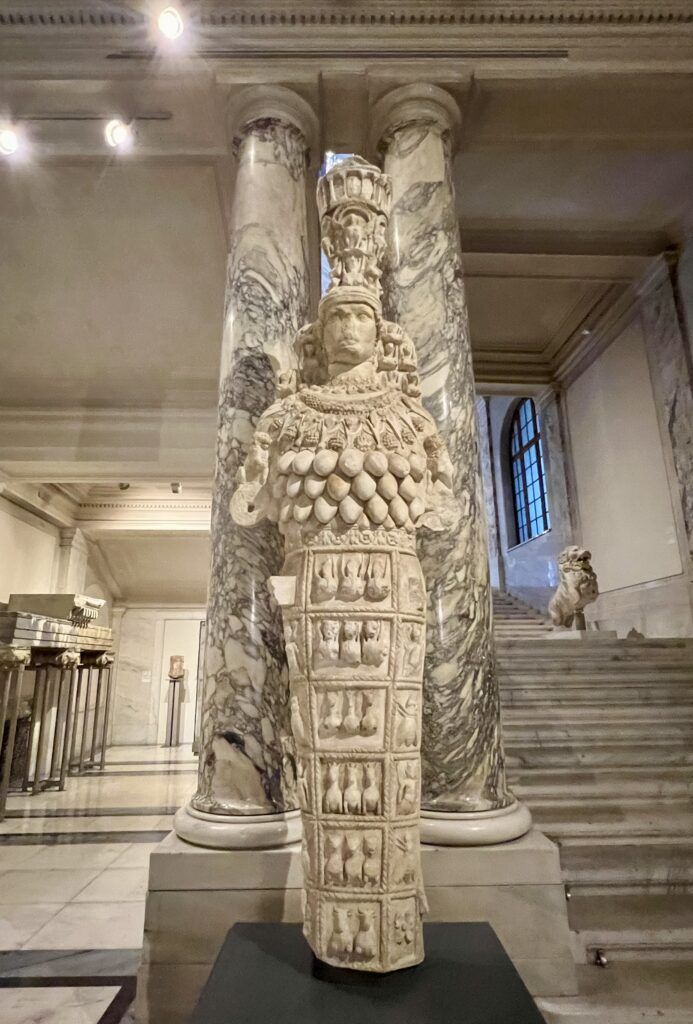
Museum of Ethnology
This is a renowned museum dedicated to the study and exhibition of ethnographic artifacts from cultures around the world.
It’s one of the largest ethnological museums in Europe and is part of the Kunsthistorisches complex.
The museum’s extensive collection includes ethnographic and anthropological objects, artworks, textiles, tools, and artifacts from various cultures and regions.
Its most famous object is an Aztec headdress made out of 450 tail feathers of the quetzal bird.
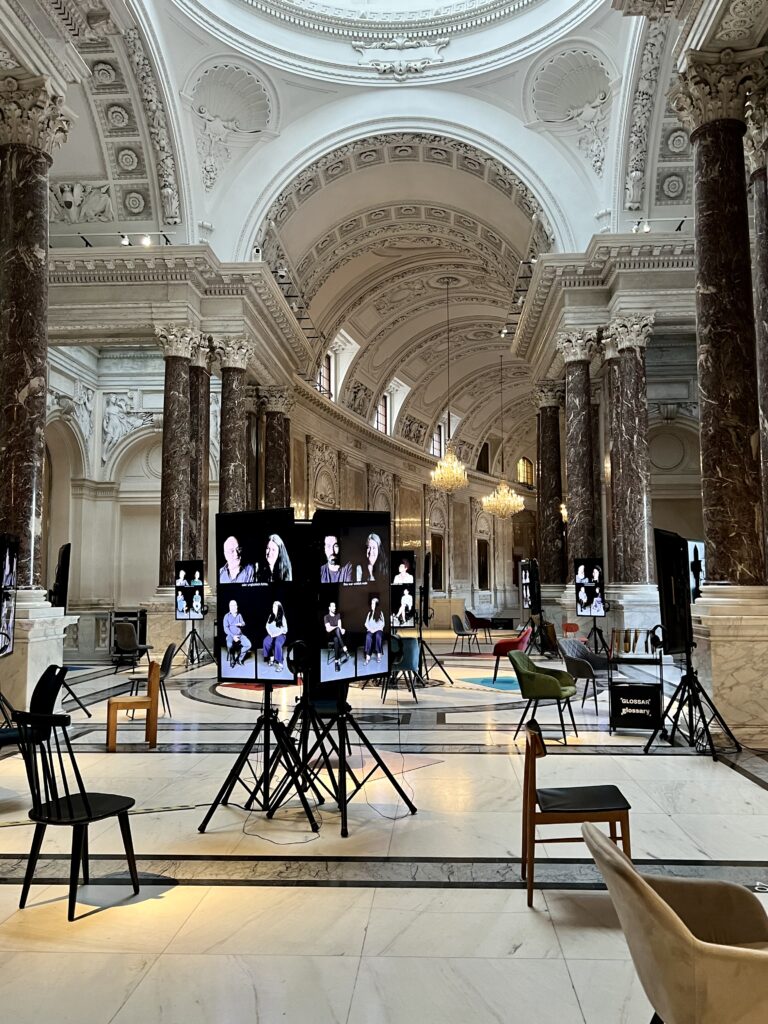
Museum of Austrian History
The House of Austrian History is one of Vienna’s newer museums.
It aims to take a critical look at the country’s heritage and what it means to be Austrian. So, you’ll see displays on the growth of Austro-fascism and WWII.
Papyrus Museum
The Papyrus Museum is the largest of its collection in the world. It hold around 138,000 papyri from the 15th century B.C. to the 16th century A.D.
The collection was compiled by Emperor Franz Josef’s nephew. Among other things, it includes the oldest surviving police ticket and a recipe for toothpaste.
The most interesting items of the collection are displayed in 30 cases in the basement of the Neue Burg. You access it via the Modern Library.
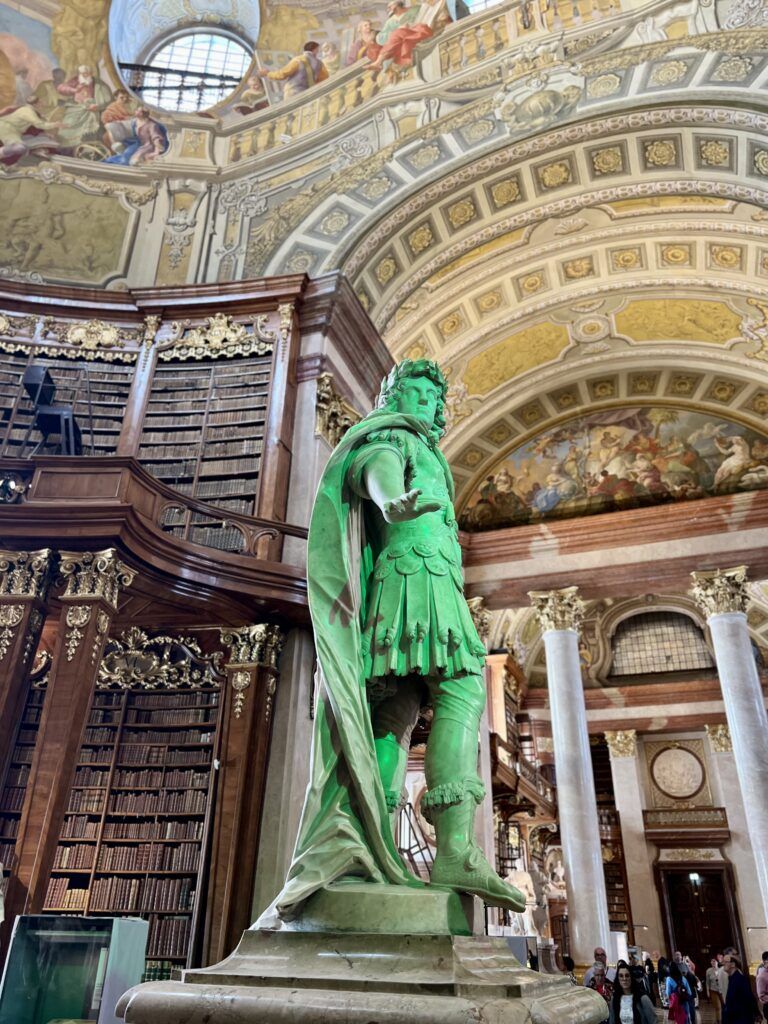
6. National Library
The State Hall of the National Library is a stunning must see. The room was designed by Johann Bernhard Fischer von Erlach.
It’s what the Viennese call Gesamtkunstwerk , a “total work of art.” The room is long and rectangular with barrel vaulted ceilings. In the middle, it opens into an oval space topped by a cupola.
The hall has gorgeous walnut book cases, white marble statues (including one of Shakespeare), and vibrant ceiling frescos.
The dome fresco depicts the Apotheosis of Charles VI . And there’s a statue of him under the dome to boot.
Tip : The statue isn’t green. It’s just the effect of a light shining on it.
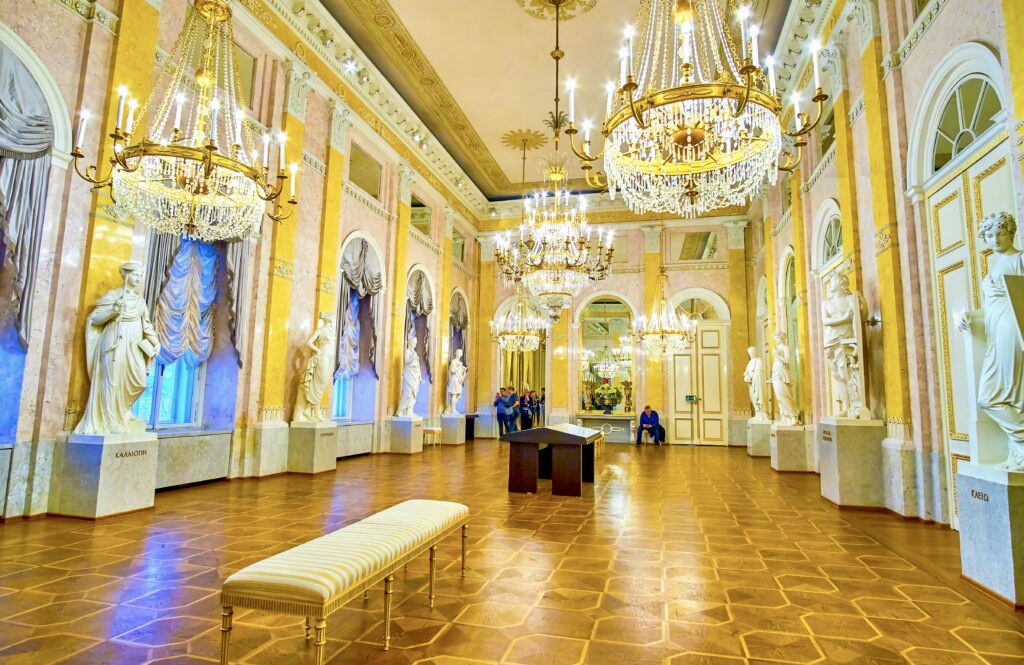
7. Albertina Museum
Vienna’s Albertina Museum is a renowned cultural institution located in the heart of the city. It houses one of the world’s most extensive and impressive collections of graphic art and early Modernism.
But the reason that it’s part of the Hofburg complex is because it houses the staterooms of Maria Christina. She was Empress Maria Theresa’s favorite daughter and the only one allowed to marry for love.
The extensive series of chambers has undergone a meticulous restoration, returning them to their original 1822 grandeur.
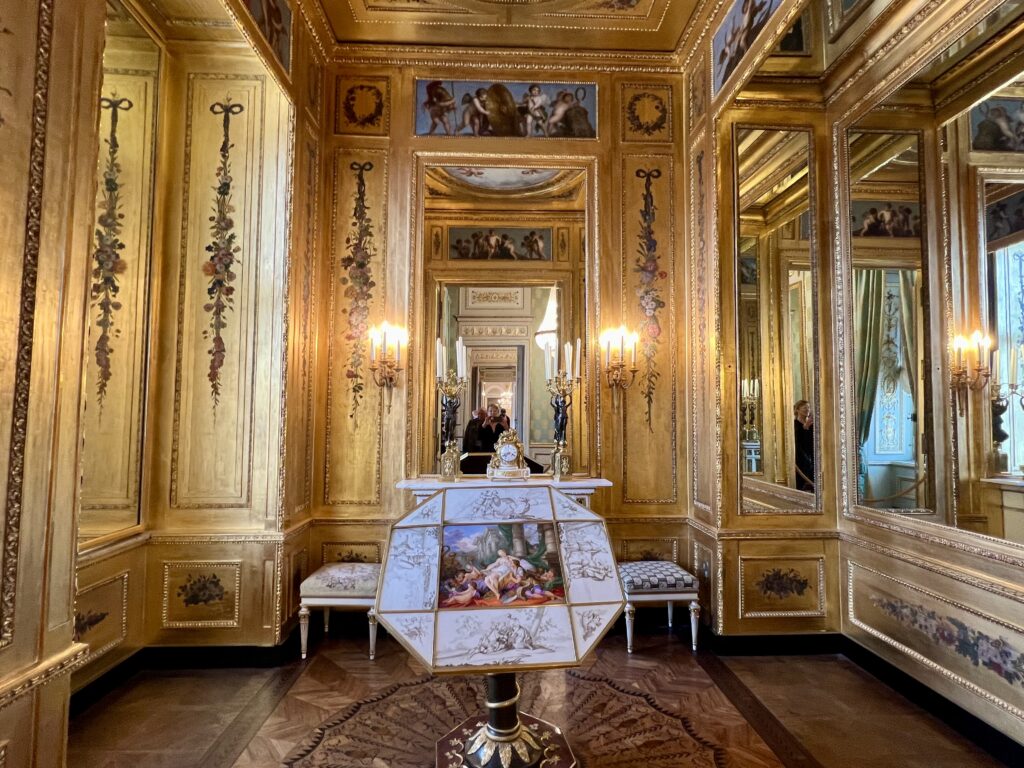
Adorned with silk tapestries and resplendent golden wainscoting, these rooms exude timeless elegance.
Among them, the Hall of Muses stands out as a true masterpiece, with crystal chandeliers and larger-than-life statues depicting Apollo and his muses.
Throughout the State Rooms, there is a treasure trove of art works on display. I stumbled upon remarkable works by Raphael and Durer.
For more information, here’s my complete guide to the Allbertina . Click h ere to pre-book a skip the line ticket.
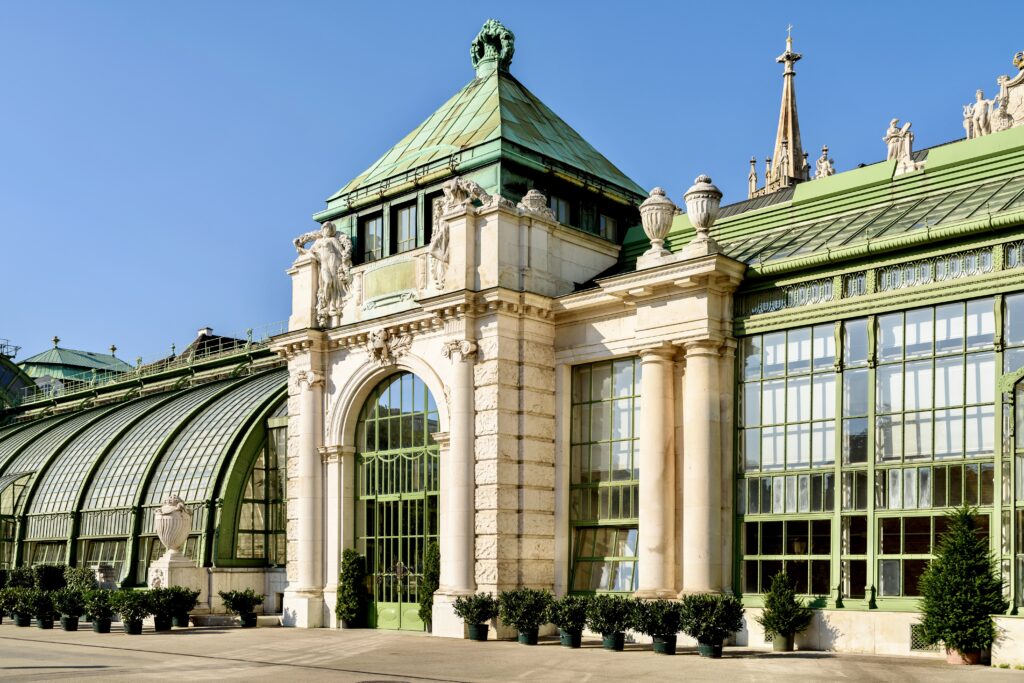
8. Burggarten
Vienna’s Burggarten is a lovely garden with a rich history, situated adjacent to the Hofburg Palace.
It was once the private haven of the Habsburg royal family. Today, this splendid garden is a public park celebrated for its meticulously manicured lawns and vibrant flower beds.
As you explore the park, you’ll see statues of Franz Josef and the musical genius Mozart. The park is also home to a charming Art Nouveau cafe known as the Palmenhaus.
Initially conceived as a greenhouse, the Palmenhaus has an exquisite iron and glass design, featuring a graceful vaulted glass dome.
The atmosphere is serene, allowing you to dine amidst luxuriant greenery and plant life. It’s a delightful location to savor both nature and a delectable meal in Vienna.
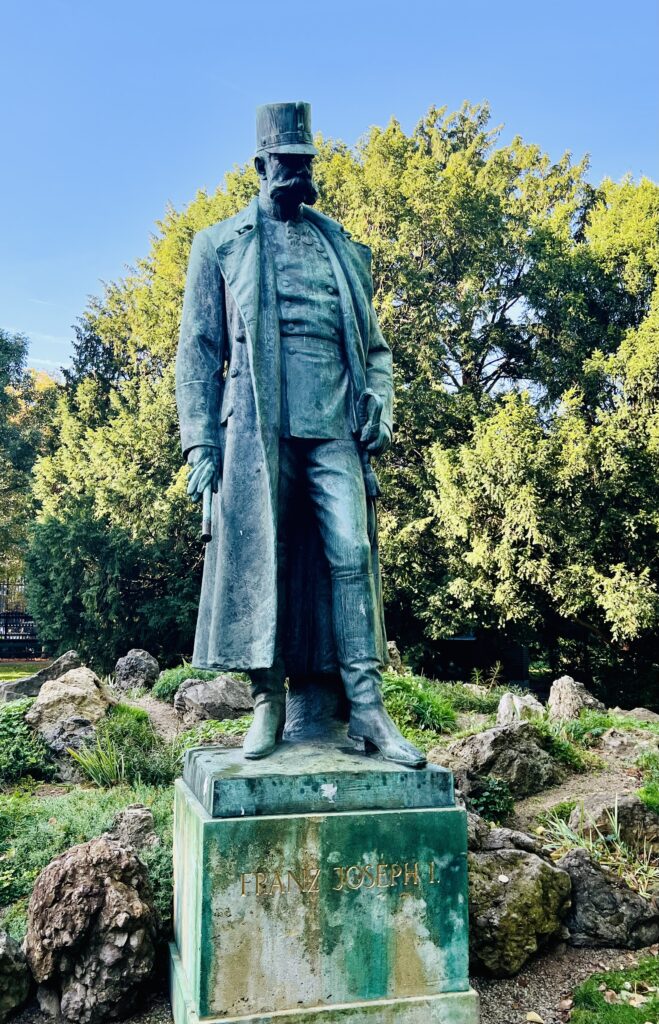
I hope you’ve enjoyed my guide to the Hofburg Palace complex. You may find these other Vienna travel guides useful:
- 3 days in Vienna itinerary
- guide to Klimt paintings in Vienna
- guide to the Beethoven trail in Vienna
- what to do in Vienna in winter
- best museums in Vienna
- guide to the Sisi Museum
- guide to the Kunsthistoriches
- guide to the Vienna Secession
- guide to the Albertina Museum
- guide to the Freud Museum
- guide to the Secession Museum
- guide to St. Stephen’s Cathedral
If you need a guide to the Hofburg Palace, pin it for later.
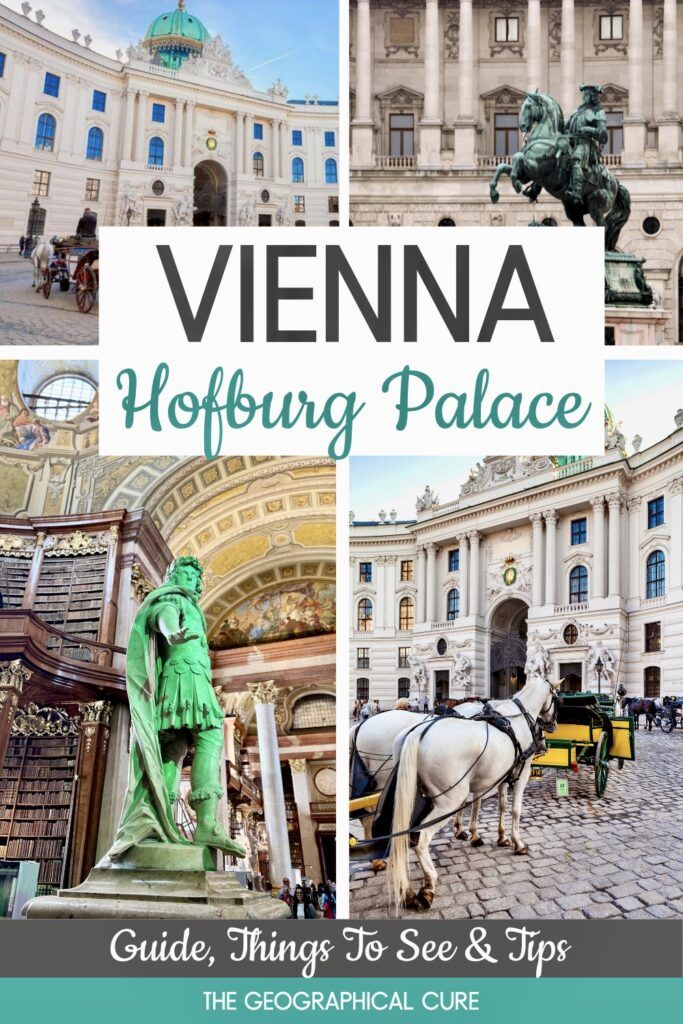
2 thoughts on “Guide To Vienna’s Hofburg Palace Complex”
The Sisi Museum and the silver collection is a must do – it’s an interesting insight what life was like living in this imperial palace. For a couple of extra euros you can get the guided tour – it’s well worth doing as you’ll learn so much more!!
I can’t say I was wowed by the silver collection. But the Sisi Museum was super interesting. On the whole, I enjoyed Hofburg more than Schonbrunn.
Leave a Comment Cancel reply
Save my name, email, and website in this browser for the next time I comment.
Last Updated on January 6, 2024 by Leslie Livingston

Should You Visit Hofburg in Vienna? Here’s What to Expect
During the early planning of my Vienna trip, before I had the chance to explore Hofburg, I was under the idea that Hofburg and Schönbrunn Palace were quite alike – both being standalone palaces. In particular — the Neue Burg of Hofburg — I thought it was Hofburg’s only remarkable building, much like Schönbrunn’s main palace.
Contrary to my initial assumptions, my exploration of Hofburg revealed a different reality. Although both palaces have been the Habsburg family’s residences for generations, they have evolved differently over time. This difference is especially apparent when comparing the things one can experience from each palace.
If I were to summarize the experience at Hofburg, it would be this: Hofburg, with its stunning architecture, wealth of discoveries, and amazing cultural scene, is a destination you won’t regret visiting. Allow me to highlight some of the most fascinating things you can look forward to in Hofburg in this post.

This post may contain affiliate links. I may receive a tiny commission at no additional cost to you from any qualifying purchases using the link.
Discover amazing ways to enjoy Vienna
Vienna Ringstrasse Walking Tour DIY (with Map and Tips)
Click to open in a new tab .
Is Hofburg Worth It?
Even though other palaces in Europe look more impressive like those that you can find in France, Spain, and Italy, Hofburg still met my expectations particularly when it comes to architecture and new discoveries.
While Hofburg isn’t as big as Schönbrunn, it seems that almost every place in this palace has something to behold or fantasize about. From the facade of the Neue Burg to the dome of Saint Michael wing and to the crowns in the Royal Treasury , I was glad to be able to explore Hofburg.
Like, if you will also be wandering outside, the most intriguing part of Hofburg you shouldn’t miss is the balcony of the Neue Burg. It was there that Adolf Hitler proclaimed the Annexation of Austria into the Nazi’s Regime. Interestingly, it is only the first of the many stories that you’re gonna unfold once you arrive in Hofburg.
Dating back to the 13th century, Hofburg is worth visiting for its undoubtedly rich history and unparalleled experience in getting a glimpse of the opulent lives of the Habsburg family.
Come inside and you’ll learn about Princes Sisi, Franz Joseph I, Maria Theresa, Holy Roman Empire, and so much more. You can also experience the living tradition that spans over 400 years. Witness the fascinating exhibits that the Habsburgs have gathered from around the globe.
There’s so much to see that anyone who will visit might need to allocate half a day (3 to 4 hours) to see only the highlights of this place .
Save to Pinterest
After visiting Hofburg, you can go to the Kunsthistorisches Museum . It’s located just beside Hofburg, and it’s worth visiting for its breathtaking interiors and undoubtedly very interesting exhibits about historical artworks.
You might also want to see another palace in Vienna: Belvedere Palace . It’s one of the most picturesque places in the city, and it is also an art museum with unique artworks from different ages.
Links open in a new tab.
What to Expect in Hofburg: Amazing Experiences & Unmissable Things to Do
Hofburg continues to function as a government office today, just as it did during the Habsburg rule. The Austrian president’s office is situated in the Leopoldine Wing of the palace.
What’s interesting is that it also accommodates numerous organizations. Some of these provide travelers with a meaningful visit to Vienna. Some of Austria’s most prominent museums are also located within Hofburg.
Among the attractions in Hofburg, there are seven that I believe are essential to see. I’ve listed them below, arranged from the most captivating to those that are still worth a visit.
Make the most of your trip to Vienna by checking out my Vienna Travel Inspiration posts. They’ll help you find the perfect experiences to suit your preferences
10 Most Picturesque Spots In Schönbrunn Palace Park, Vienna
Salzburg Day Trip From Vienna: 10 Unmissable Things to Do
7 Beautiful Day Trips From Vienna (Within Austria)
30 Little Gems in Old Town Vienna (See Them on a Map)
#1 Imperial Treasury
If there’s one part of Hofburg that could fill everyone — not only wanderers — with wonder, it would be the Imperial Treasury . This is the place in Hofburg where you can see the priceless and most important treasures of the Habsburg Empire — absolutely magnificent items.
These include both secular and religious ones, such as the Austrian imperial crown , the jewels from the Order of the Golden Fleece , the agate bowl , and allegedly one of the nails that pierced Jesus to the cross .
Overall, the Imperial Treasury has 20 rooms filled with historical splendor, and as you visit each, it’ll surely feel like more than a privilege to see such important pieces of relics.
Another artifact that I believe you’d be fascinated to see when you visit the Imperial Treasury in Hofburg is the so-called ‘ unicorn horn scepter .’ Contrary to the myth, it wasn’t made from a unicorn horn. In fact, the scepter was crafted from the tusks of a narwhal , which were considered rare and difficult to obtain during that time.
If you want to visit the Imperial Treasury, it is situated in the Swiss Wing of Hofburg . Entry to the Imperial Treasury isn’t free, but it isn’t that expensive either. There’s a dedicated ticket to visit the Imperial Treasury .
But if you want to save money, you might like to try a combo ticket that includes the Kunsthistorisches Museum . This museum is another attraction in Vienna adjacent to Hofburg. I highly recommend it for ancient art lovers. If you have a Vienna Pass , you don’t have to worry about getting a separate ticket to the Imperial Treasury.
For practical information on visiting the Imperial Treasury, kindly check its official website in the resources section.
#2 Sisi Museum
Hofburg is also rich with intriguing stories, especially with the Sisi Museum housed in it. Sisi, or Empress Elisabeth, is one of the beloved figures in Austrian and Hungarian history, known for her free spirit and beauty. Just one glance at her painting in Hofburg makes it easy to understand why she’s the apple of so many people’s eyes.
I love her for her love of travel, individuality, and independence ! Sounds like my kind of dream wife. LOL. Anyhow, her free spirit often clashed with the expectations of court life, which made her life as royalty a bit challenging. You know, a free-spirited person doesn’t like so many rules, and formal court life has many.
Her life is very interesting, and overall, I think that her museum is a must-see during a visit to Hofburg . In the Sisi Museum, you will discover much about her life: from her dressing style to her travels to the Mediterranean, Atlantic, and beyond.
Interestingly, the tour of the museum begins with her tragic death. At the very beginning, you’ll see her death mask , which, I think, was put there to show that she was beautiful even in the last days of her life. As you go further into the exhibits, you’ll find items and films giving insights into the “ historical myth of Sisi .” Yes, more intriguing stuff about Sisi!
Wondering where the Sisi Museum in Hofburg is? It’s located in the Stephan Apartments of the palace. It is recommended to book your Sisi Museum tickets in advance so you may save time and avoid long queues.
You don’t have to worry about buying tickets if you have a Vienna Pass . It covers admission to the Sisi Museum. I linked the official website of the Sisi Museum in the resources section for ticket information. Actually, it’s better if you join a tour when visiting the Sisi Museum . Not only will there be no waiting time, but most importantly, there’ll be a tour guide giving deeper insights into the life of this iconic empress.
#3 Hofburg Imperial Apartments
As you may now be aware, the Sisi Museum is housed in what were once the Imperial Apartments .
This is why, when you visit Hofburg, you can see the Imperial Apartments located just beside the Sisi Museum . Since they are located in the same building, it makes perfect sense to include both in your plans of places to see in Hofburg during your trip.
Actually, even if they were located apart, I believe that the Imperial Apartments should be on everyone’s itinerary when they visit Hofburg . They served as the residence and office of the imperial family for six centuries. By going inside each room, you’ll gain insight into the imperial lifestyle and everyday court life of the Habsburgs.
What could be particularly interesting, especially for wanderers like me, is that the Imperial Apartments were restored according to their historical models . The furniture and items inside the rooms, as well as the architecture, are preserved to their authentic appearance.
Wandering inside the Imperial Apartments, it’s hard not to feel that you’re being transported back in time. The rooms are overflowing with opulence, evident from the golden baroque embellishments all over the place.
My favorite part of the Imperial Apartments is the Berglroom , painted with trompe l’oeil landscape murals, depicting a tropical paradise. The artistry is amazing.
If you are also visiting Schönbrunn Palace, you’ll see more rooms like this. Overall, there are 20 rooms you’ll be exploring, and the fun starts with the red carpeted Emperor’s Staircase , which is also the entryway to the Sisi Museum.
Entry to the Imperial Apartments is covered by the Day Ticket for the Sisi Museum, allowing you to explore the areas within 75 minutes with an audio guide. Admission to the Imperial Apartments is also covered by the Vienna Pass .
You can learn more from the official website of Hofburg, linked in the resources section of this post. If you are traveling in a group, I recommend getting an exclusive tour of Hofburg, the Sisi Museum, and the Imperial Apartments for a more insightful visit.
#4 Spanish Riding School Vienna
If you are looking for a unique experience and a living tradition in Vienna , the Spanish Riding School is a must-see.
This institution, housed in Hofburg, is dedicated to the preservation of classical dressage and the training of Lipizzaner horses. Dating back to 1572, it has been cultivating the art of the “ haute école ” or high school movements for an impressively long four centuries. In 2015, it was recognized as one of Vienna’s UNESCO intangible cultural heritages .
Today, the institution shares their passion with travelers by offering regular and special performances.
However, the performance is like a slow dance of the horses — you can see them slowly galloping while making formations. Honestly, it could be boring for some people. It does not provide the same thrill and dopamine rush as watching an equestrian battle or play.
Nevertheless, their performance is nothing short of amazing, particularly to those who have a deep appreciation for training horses . The crowd can be seen clapping their hands in rhythm during the show. Joining in can make your time more enjoyable!
In the beginning, when I was still planning a visit to Hofburg, I was unsure if the Spanish Riding School was worth it. But I realized it is a once-in-a-lifetime travel experience . This is particularly true for people like me who come from other parts of the world with a totally different culture.
There are two ways you can discover or experience the Spanish Riding School. The first is by watching the performance of the Lipizzans . The second is by joining a tour behind the scenes of the Spanish Riding School .
The tour welcomes you to the Stallburg, where you’ll be exploring the Winter Riding School, which has stunning Baroque architecture, and the Summer Riding School, which houses the world’s largest oval horse walker. You’ll also be meeting the graceful horses in the historical stables of the Lipizzaner stallions. It’s a unique experience to try.
#5 Silver Collection
The dining room is one of the parts of Hofburg that you’ll visit during a tour of the Imperial Apartments. Here, you’ll get an idea of what courtly dining in Hofburg looked like centuries ago.
Imagine how extravagant a dinner of the Habsburg family was: from the shining set of spoons and forks to the glittering crystalline glasses . There’s one for each kind of drink. But did you know that it can look even more opulent during celebrations and special events?
Visit the Silver Collection for a better picture! I believe all the unimaginably glamorous courtly flatware and silverware are here. Interestingly, the dining utensils here are also historical. Some date back to the days of Maximilian I and Frederick III.
As of this writing, the Silver Collection in Hofburg is under renovations. I’m not exactly sure when it’ll be accessible to the public. You may check the official website of the Silver Collection for announcements.
When it reopens and you have plans to visit the Silver Collection, there are two exhibits that I bet you won’t want to miss. These are the Milan Centerpiece and the Old French Centerpiece , which were commissioned to mark the coronation of Emperor Ferdinand I of Austria as King of Lombardy and Venetia.
Intricately made with gilded bronze, they seem like they were made for a god. I think they are the most elaborate ensemble in the Silver Collection .
#6 Weltmuseum Wien
Little did I know that stepping into Hofburg could feel like a journey around the globe. That was until I discovered the Weltmuseum .
It’s the museum located on the southern wing of the Neue Burg in Heldenplatz. To me, it’s one of the most amazing attractions one can find inside Hofburg .
Some people say it is one of the leading ethnographic museums in the world, housing collections from non-European cultures. Well, after learning about its permanent exhibitions, I think I can’t disagree! There’s something from Ethiopia, the Himalayas, Japan, Brazil, the Americas , and so much more.
Many of the exhibits that you’ll find here can be attributed to the Habsburg archdukes, who collected the artifacts during their journeys. The highlights of the collection include artifacts from the renowned seafarer James Cook and a globally celebrated Mexican feather headdress.
In a way, this museum gave me an insight into how connected the Habsburg Empire was to the world even at a time when travel wasn’t yet convenient.
Overall, there are 14 rooms for permanent exhibitions and a few more for temporary exhibitions. Among the exhibits inside the Weltmuseum Wien, it’s the “ Japan Comes to Europe ” that I find so fascinating.
The exhibits here were from the World’s Fair in Vienna in 1873, and you can find samurai armors, Shinto statues, and miniatures of traditional buildings in Japan . Imagine — half the world apart from Japan, and Vienna has these artifacts. Amazing.
You might also like the “ South Seas ” section of the museum. The items here remind me of the Disney movie, Moana.
While many don’t consider the Weltmuseum as a highlight of Hofburg, I think it’s worth visiting as it’ll definitely make your visit to Vienna unique . Well, of course, it’s all because of the rare and amazing discoveries from all over the world here.
If you want to visit, the Weltmuseum Wien has a separate entry ticket . But if you already have a Vienna Pass , you don’t have to worry about buying a separate entry ticket. For more information like the opening hours, audio guide fee, digital tours, and more, please check the official website of the Weltmuseum Wien, which I linked in the resources section of this post.
When I ask people about their impressions of Vienna, the common responses usually revolve around its stunning architecture, coffee culture, and grand palaces. But if you’re looking to add a unique twist to your Vienna trip beyond the usual spots like the Weltmuseum, Liechtenstein Castle could be just the ticket. Located on the city’s outskirts, this castle offers a glimpse into a lesser-known facet of Vienna’s history. It’s definitely worth checking out!
#7 Austrian National Library
True to its name, Hofburg (Imperial Palace) is a symbol of the wealth of the Habsburg empire. The imposing architecture of Hofburg’s exteriors gives that impression as soon as you arrive at the palace.
But did you know that it is also the center of cultural and historical knowledge of the empire? That is because the largest library in the country, the Austrian National Library , is located in Hofburg. It represents the continuity and diversity of the Austrian identity, as well as the preservation of knowledge and culture.
While there are innumerable books, intriguing manuscripts, and amazing maps in this library, the real reason (in my opinion) why the Austrian National Library is another must-see in Hofburg is its breathtaking architecture .
The Austrian National Library is Europe’s largest Baroque library and one of the most beautiful that you will ever behold . From the decorated wooden shelves to the frescoes on the dome above the Grand Hall, the Austrian National Library showcases beautiful imperial heritage.
By the looks of the library alone, you could be inspired to read, discover, and learn something inside! Amazingly, the library also has four museums and eight collections that showcase the diverse and fascinating aspects of Austrian culture and history . Just perfect for that inspiration for new learning.
The museums include the Globe Museum, the Papyrus Museum, the Esperanto Museum, and the Literature Museum. The collections cover various fields and topics, such as music, maps, manuscripts, portraits, posters, and newspapers.
As a traveler, I think you would not want to miss the Globe Museum . It has a bonus, though. You can also see globes of the moon and other planets.
When you visit the Globe Museum, try checking out the two Venetian Baroque Globes . One for the earth and one for the sky, each with a diameter of more than one meter. They are the most exquisite.
Do you want to visit? The library and its museums are not covered by the Vienna Pass. You have to buy dedicated or combination tickets if you want to go inside the Austrian National Library.
For the tickets and visiting information, please check the official website linked in the resources section.
Did you know that there’s another beautiful library in Austria? It’s located in Melk Abbey , Austria’s architectural gem nestled in the Wachau Valley. It’s a perfect day trip from the city.
An alternative day trip is Laxenburg Castle Park and Kreuzenstein Castle . Laxenburg Castle Park the largest landscape garden in Austria; a wonderful destination for romantics. Kreuzenstein Castle is one of the most beautiful castles near Vienna; the filming location of the 2011 movie, The Season of the Witch.
Hofburg Photo Inspiration
Let me give you more ideas of what you can expect from the seven attractions I mentioned. Below are some photos of each attraction and exteriors of the palace. Happy virtual wandering!
For more places in Vienna filled with incredible artworks, similar to those you’ll see in the National Austrian Library, the city’s churches are the places to be. For breathtaking Baroque style, check out Peterskirche , the church rumored to have been founded by Charlemagne, and Karlskirche , which is famous for its concerts and columns similar to Trajan’s column in Rome. For a blend of Baroque and Gothic styles, visit Saint Stephen’s Cathedral .
Resources: Hofburg Vienna
So, those are the amazing experiences and activities you can look forward to when visiting Hofburg in Vienna. It’s a place you shouldn’t miss, don’t you think?
If you’re planning a trip to Hofburg, I can assist you with your preparations. I’ve listed the official websites of the attractions and parts of Hofburg that I mentioned earlier. These sites provide information on visiting hours, ticket details, and answers to common questions.
- Official Website of Hofburg
- Imperial Treasury Practical Information
- Imperial Treasury Guides & Tours
- Sisi Museum & Imperial Apartments Tickets & Prices
- Sisi Museum & Imperial Apartments Practical Information
- Sisi Museum & Imperial Apartments Guides & Tours
- Weltmuseum Wien Practical Information
- Weltmuseum Wien Guides & Tours
- Official Website of Austrian National Library
- Vienna Pass
- Best Hotel Deals in Vienna
Where to go next in Vienna after Hofburg?
Check out Danube Tower. It is the tallest building in Vienna, offering 360-degree panoramic views of the city. It’s one of the best places in the city to have dinner while watching the sunset. Learn more about Danube Tower here: Things to See and Expect in Going Up The Danube Tower Vienna .
You must also check out the Museum of Military History , which is home to exhibits that bear witness to some of Europe’s most historical events.
Leave a Reply Cancel reply
Your email address will not be published. Required fields are marked *
Save my name, email, and website in this browser for the next time I comment.
The Hofburg, Vienna: Imperial Palace of the Habsburg Dynasty
For centuries Vienna has been an important political and cultural city in Europe and nothing represents the city’s prominence quite like the Hofburg . With origins that date back to the 13th century, the Hofburg holds over 700 years of history between its walls. What’s fascinating is that it is not just one palace, but rather a complex of buildings most notable for being the primary residence of the Habsburg dynasty. Today, visitors can explore three main areas within the Hofburg and learn about the history that turned Vienna into the heart of Europe.

History of the Hofburg
The Habsburg Dynasty was one of the most powerful monarchies in what we know today as Europe. It began with Rudolf I in 1273 and over the next 600 years the family’s reign would extend over the regions of Austria, Hungary and Bohemia, the Spanish Empire as well as the Holy Roman Empire. The collapse of Habsburg rule took place in 1918 and near the end of the dynasty an incident took place that would lead to one of the world’s most infamous historical events. In 1914, the Archduke Franz Ferdinand was assassinated in Sarajevo, which is widely cited as the beginning of World War I. While much has changed throughout the 600 years of Habsburg rule, the Hofburg remained their primary residence and the historic centre of their political power.

The oldest part of the Hofburg (today known as the Schweizertrakt , or Swiss Wing ) dates back to the 13th century, which was a part of the medieval fortified castle on site. With each century came new additions to the palace complex, with some notable additions including the Amalia Residence (16th century) which later included apartments occupied by one of the most notable Habsburg rulers, Empress Elisabeth, the Winter Riding School (18th century) and the Hall of Ceremonies (19th century) where many Viennese balls have taken place. An interesting aspect of the Hofburg, is that each emperor added their own unique design elements to the palace, which means they have all left their mark on the buildings.
Today, the Hofburg still plays a part in Austrian political life as the residence of the President of Austria. The Hofburg also houses other important cultural buildings such as the Austrian National Library. In addition, the Hofburg houses three main museums and exhibitions for tourists to explore, including the Sisi Museum , the Imperial Apartments and the Silver Collection.

The Sisi Museum
In my opinion, the most interesting area of the Hofburg to explore is the Sisi Museum . This museum showcases the life of one of Austria’s most famous rulers, Empress Elisabeth. Empress Elisabeth of Austria, also known as ‘Sisi’ was born in Munich and became Empress after marrying Franz Joseph I of Austria in 1854. Sisi was as fascinating character and if you don’t know much about her, she is certainly worth doing further reading on!
Sisi was a unique individual who struggled to adapt to life at the Hofburg as she disliked the confines that came with aristocratic life at court. She is widely known as one of Europe’s most beautiful queens and was loved by her public, especially Hungarians, for her role in the Austro-Hungarian Compromise of 1867. And while she was loved, behind the palace walls she lived a sad and turbulent life. In 1889, she experienced the tragedy of her son’s suicide from which she never recovered. Sisi travelled frequently, to escape the confines of the Hofburg, and ultimately her own life tragically ended in 1898 when she was assassinated by an Italian anarchist in Geneva.
Today, visitors can explore Empress Elisabeth’s life at the Sisi Museuem at the Hofburg. The museum gives an insight into many aspects of Sisi’s life including her childhood in Bavaria, her marriage and struggle with life at court, as well as her later years and ultimately tragic death. The museum has over 300 objects on display and is a beautiful homage to one of Austria’s most fascinating royal figures.

The Imperial Apartments
The Imperial Apartments are housed in the Amalia Residence and the Imperial Chancellory Wing and allow visitors to explore the apartments that once belonged to Emperor Franz Joseph I and Empress Elisabeth. There are a number of stunning rooms to explore, including the Dining Room , both the Emperor and Empress’ saloons used for entertaining, their bedrooms as well as the Audience Chamber where Franz Joseph held a number of important meetings. I particularly enjoyed visiting Sisi’s Dressing & Exercise Room, where she is said to have spent a lot of her time perfecting her appearance.
The Silver Collection
Visitors can also wander through the Silver Collection , which contains a number of objects used at the Hofburg for dining occasions. Historically, there was actually a specific office (called the office of Silver Chamberlain) that would have been responsible for everything to do with setting the royal table. With about 600 years of dining history, it’s definitely worth a visit as you’ll be able to view some exquisite pieces.

Overall, a visit to the Hofburg is a great place to start your historical exploration of Vienna. The many centuries of history covered in the palace’s museums and exhibitions give an interesting and in-depth insight into one of the world’ most famous and powerful royal families. The Habsburgs had an immense influence on the history of Europe and I found it fascinating to explore the place they called home.
Tips for Visiting the Hofburg
1. where is the hofburg located what is the best way to get to the palace.
The Hofburg is located in central Vienna and therefore very easy to get to! It is less than a 15-minute walk from the central area of Stephansplatz or you can also take the subway to Volkstheater station from which is it about a 5-minute walk.
2. How much is a ticket to the Hofburg?
There are a few different ticket options, but I would personally recommend the “Day Ticket” for the Sisi Museum. It costs about €16.00 and gives you access to the Sisi Museum, Imperial Apartments and the Silver Collection. The ticket is also inclusive of an audio guide which is great for wandering around at your own pace.
For fans of Sisi, there is also the option to purchase the “ Sisi Ticket ” for approximately €40.00. This allows you to visit three imperial attractions in Vienna including the Sisi Museum, Schönbrunn Palace(the summer residence of the later Habsburgs) and the Vienna Furniture Museum.
Visit here to learn more about purchasing a ticket to the Hofburg.
3. When is the Hofburg open?
It’s open daily from 10:00am to 5:00pm/6:00pm depending on the time of year. However, always make sure you check the current opening times (and the last entry time) before visiting.
Visit here to check the opening times for the Hofburg.
4. How long is needed to visit the Hofburg?
If purchasing the Day Ticket, I would recommend leaving yourself about 2 hours to explore. You could probably go through it a bit quicker if needed, but there is lots of interesting information to take in.
5. What other historical things are there to do nearby?
The Hofburg’s central location means there are plenty of other great attractions nearby. If you’re interested in more Habsburg history, you’re only a 10-minute walk to the Kaisergruft , which is the burial place of many of the Habsburg monarchs. You are also about a 5-minute walk to Vienna’s Museum of Natural History . And if you’re in the mood for a tasty treat, you are also only about a 10-minute walk away from the Hotel Sacher , where you can try the original famous Sacher-Torte dessert.
For a full list of recommendations, check out 10 Historical Things to do in Vienna, Austria .
This article’s information was last updated in August 2022.
10 Historical Things to do in Vienna, Austria
10 historical things to do in salzburg, austria, you may also like, 10 “sound of music” locations to see in..., visit the cavern club in liverpool, england, 10 historical things to do in london, england, nonnberg abbey: sound of music locations, salzburg, mozarthaus: visit mozart’s apartment and museum in vienna, finding freddie mercury in montreux, switzerland, mondsee, austria: picturesque lakeside town near salzburg, mozart’s birthplace in salzburg, austria, privacy overview.
Privacy Policy - Terms and Conditions - Privacy Policy
- Italienisch it
- Französisch fr
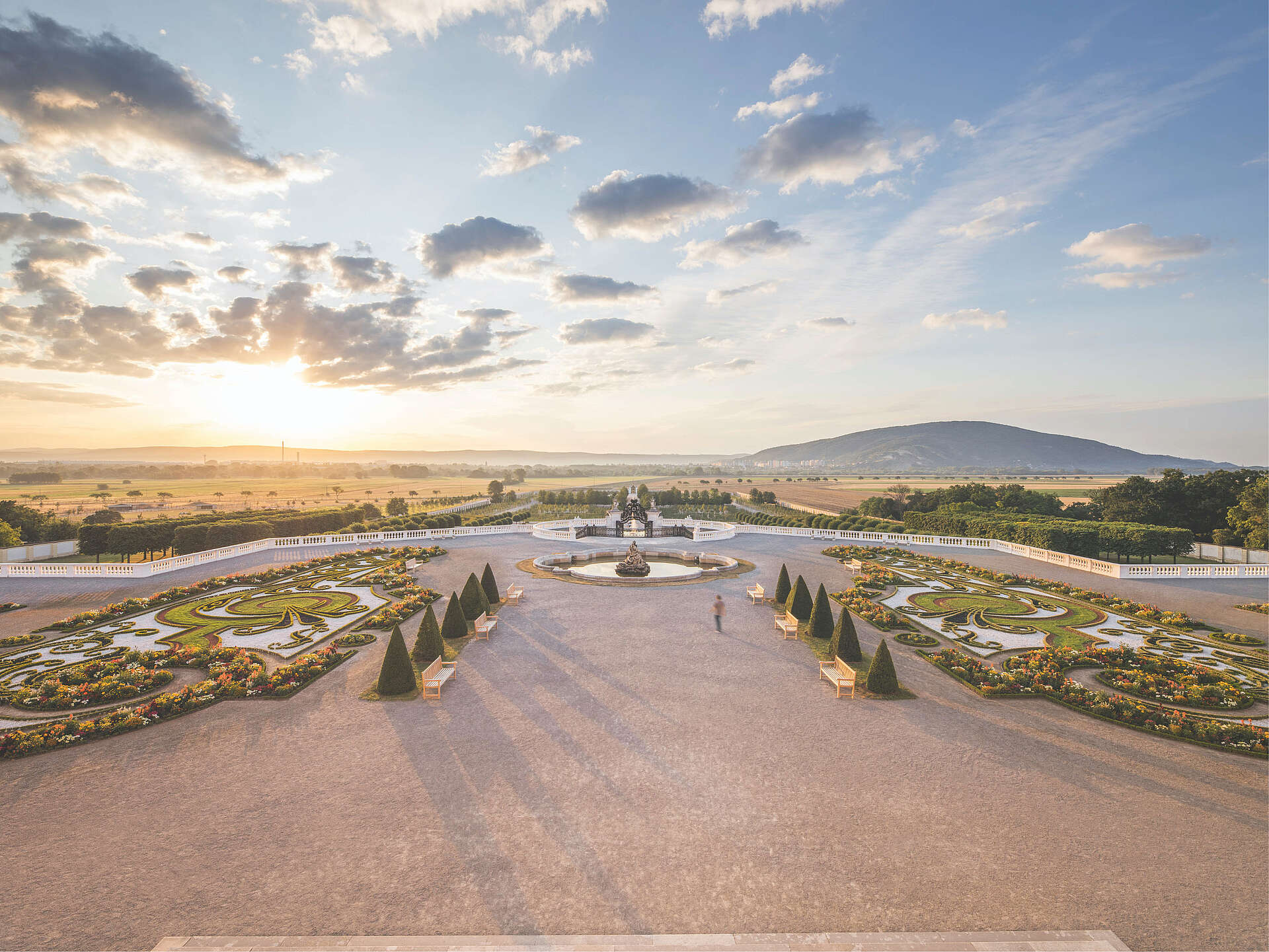
Feeling Sisi’s aura as a living experience
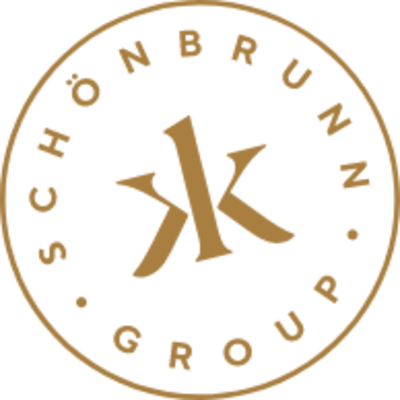
Opening times
Sisi museum, discover our tours, day ticket sisi museum.
The ticket price includes admission to the Sisi Museum and the Imperial Apartments.
Day ticket Sisi Museum with guided tour
The ticket price includes admission to the Sisi Museum and the Imperial Apartments with guided tour.
Sisi Ticket
3 imperial attractions on 1 ticket: Schönbrunn Palace + Sisi Museum plus the Imperial Apartments in the Vienna Hofburg + the Vienna Furniture Museum – you save 25%!
About the Museum
Since 2004 the Sisi Museum has been housed in the Stephan apartments, so named after Archduke Stephan Viktor. Here numerous personal items that once belonged to Elisabeth are used to help illustrate the true personality of the frequently misunderstood Empress. The sensitively designed exhibits, created by renowned set designer Prof. Rolf Langenfass, are inspired by the monarch's poetry.
Imperial Apartments
The Hofburg was the residence of the Habsburgs for over 600 years and thus the centre of the Holy Roman Empire. Apart from its function as the seat of government and administrative centre, the Hofburg was also the winter residence of the imperial family. From the 18th century onwards the court spent the summer at Schönbrunn Palace.
Virtual Tour
The sisi myth, assassination, emperor's staircase, trabant guards room, audience waiting room, audience chamber, conference room, large salon, small salon, living room & bedroom, dressing & exercise room, lavatory and bathroom, large salon of empress elisabeth, small salon of empress elisabeth, large anteroom, alexander apartments & red salon, dining room.
Court Kitchen
Old Court Silver and Table Rooms
The Court on the Road
Milan Centrepiece
Flower Plates
Foot-washing ceremony
Diverse Dinner Service
Sèvres und Meissner Service
Old French Centrepiece
The Minton Dessert Service
The tour though the Sisi museum starts with Elisabeths tragic death.
Elisabeth has gone down in history as an empress of eternal youthfulness and beauty. For more than three decades she was regarded as the most beautiful queen in Europe.
The tour through the Sisi museum gives an insight into the empresses life, from her birth on Christmas Eve in 1837, her childhood in Bavaria, to her engagement with Franz Joseph in 1853.
From the start, Elisabeth rejected this life, criticising the structures of the court and refusing to accept the justification for the rigid etiquette that prevailed there.
Having put immense pressure on the emperor during the negotiations with Hungary for the Compromise, Elisabeth was forbidden by her husband to interfere in politics ever again.
"Now it has happened just as she always wished: quickly, painlessly without medical consultations, without long, anxious days of worry for her loved ones."
The entrance to the Sisi Museum and the Imperial Apartments.
Coming from the Emperor’s Staircase the visitor entered this room in which the Trabanten lifeguards kept watch night and day.
Emperor Franz Joseph gave general audiences twice a week, at which any of the subjects of his empire could attend to present a matter of their concern to the emperor.
Over the course of his long reign, Franz Joseph gave audiences to around 260,000 individuals.
This room was used for the ministerial conferences which were always chaired by the emperor. It could also be entered from the room occupied by the duty aide-de-camp, who announced the presence of the ministers to the emperor.
‘As soon as the children were capable of eating on their own they were allowed to lunch with him in his study – often as many as eight at a time.’
When the imperial couple moved into separate bedrooms, Franz Joseph had a portable brown-painted iron bedstead set up in this room, an arrangement he also used at Schönbrunn, Budapest, Laxenburg, Bad Ischl and Gödöllö.
"… he [i.e. Franz Joseph] liked dallying in these small drawing rooms when he was visited by his family, his brother, his grandchildren, nephews etc. There in their company he would take a cup of tea at the twilight hour, chatting with them, and above all, enquiring after their wishes…"
The Small Salon served as a smoking room and is today a memorial room to Emperor Maximilian of Mexico.
Originally this room was the bedroom of the imperial couple. In 1870 Franz Joseph moved into a separate bedroom in the Imperial Chancellery Wing.
The Dressing Room/Exercise Room was where Elisabeth spent most of her time. This was where her day began, in the winter at six o’clock in the morning, starting with her daily hair-dressing ritual.
Facing the Amalia Wing courtyard, behind the Dressing Room, are the empress’s Lavatory and Bathroom, which were refurbished in 1876 during Elisabeth’s occupancy.
This rooms are painted with trompe l’oeil landscape murals commissioned by Empress Maria Theresa and executed by Johann Wenzel Bergl.
This room was used by Elisabeth as a reception room. When the empress was resident at the Hofburg, the imperial couple occasionally took breakfast together in this room.
During Elisabeth’s time this room was used as an additional reception room.
Originally Empress Elisabeth’s apartments were accessed via the Eagle Stairs, which connected the Leopoldine Wing and the Amalia Wing. When the Leopoldine Wing was converted into the offices of the Federal President in 1946 access to the Imperial Apartments was blocked up.
The Alexander Apartments were used by Empress Elisabeth for dinners and receptions.
Once a week on Sunday the imperial family foregathered at a family dinner, which every Habsburg currently in Vienna was obliged to attend.
Sisi Museum Digital
Culture and history in your own home! Bring the Sisi Museum into your living room and discover our varied digital content.
Current information
We are creating a special experience for you in the Sisi Museum, the Imperial Apartments and the Silver Collection.
PRESERVING (WORLD) CULTURAL HERITAGE FOR POSTERITY
The Schönbrunn Group bears the responsibility for preserving Austria’s most important cultural monuments and its imperial heritage.
Culture for your home! Bring the Sisi Museum into your living room and discover our diverse digital offering.
#sisimuseum
We wish you a happy Monday from the Sisi Museum! Here's to a week filled with inspiring moments and insights - you can visit the Sisi Museum as usual from 9.00 am - 5.30 pm, last admission at 4.30 pm. Be sure...
#squirrel #cute #cuteness #lovelyanimals #animals #imperial #garden

Public appearances required a great deal of preparation and effort from Sisi. As she was naturally shy and did not like being the center of attention, her imperial duties were a strenuous obligation. The...
The spring sun unfolds its power and envelops the imperial heritage in Vienna with its rays. Have you ever visited Vienna in spring? Tell us about it in your comments! ️ #SisiWaitsForYou © Pakes ....
. Why are we fascinated to-date by looking at the objects that once belonged to Empress Elisabeth? Is it because it wasn't so long ago that Sisi held these mirrors, boxes or letters in her hand? In the Sisi...
Elisabeth has gone down in history as an empress of eternal youthfulness and beauty. After Sisi's assassination, a life-size statue of Elisabeth designed by Hermann Klotz was executed for the Church of...
In the Hofburg you will find many insights into the past - including a magnificent model showing a former design for the Hofburg complex. Amidst the many buildings and outbuildings of the imperial residence,...
Happy Easter from the Sisi Museum! It seems like the Easter Bunny has hidden ten eggs in the Bergl rooms - can you find them all in the first picture? We wish you a lovely Easter celebration and joyous...
Easter is just around the corner - and therefore also a popular time to travel. As you might know, Empress Elisabeth was fond of travelling, by ship or by train. In 1873 the Austrian railway companies decided...
All winters melt into spring - and Vienna shines in the magic of the season. Here's a friendly reminder: Currently, many guests take advantage of this beautiful time and visit us at the Sisi Museum. We thus...
Behold the enchanting beauty of Vienna in spring! As the city awakens from its winter slumber, the air is filled with the promise of new beginnings. And what better place to immerse yourself in this seasonal...
Did you know that the imperial apartments inside the Hofburg did not always shine in red? In fact, the walls and the interior were upholstered with white velvet for a while when Sisi lived here. It was a...
What a view- here you can see the so- called Michaelerkuppel. Even if the Hofburg was the residence of the Habsburgs for more than 600 years, it was not until the end of the 19th century, that Ferdinand...
Discover more
How to get there.
The Hofburg lies at the centre of Vienna and can best be reached by underground or other public transport.
Special offers
Book a private tour of the state rooms or an evening tour for your clients - as the highlight of a visit to Vienna, as a gift for a special occasion or for an exclusive business client.
More imperial Locations
Where the Baroque comes to life for the whole family
An authentic experience of imperial heritage
Design trip through time from the Baroque era and through to art nouveau and the present
Videos cannot currently be played. Please accept the required cookies.
COOKIE SETTINGS
Here you can review and adjust the cookie settings used on the domain. Please note that we also provide cookies from US companies. If you allow these cookies, you are also consenting to possible processing of your personal data collected via these cookies in the USA (Art. 49(1)(a) GDPR).
This is relevant to the extent that, based on recent official decisions as well as case law of the Court of Justice of the European Union, the USA is evidenced as not having an adequate level of data protection (Case C-311/18, Schrems II). Here, it should be borne in mind that access by US authorities (FISA 0702) is not comprehensively restricted by law and does not require the approval of an independent body, and that no relevant legal remedies are available to data subjects in the event of infringements.
If you do not wish this to happen, please accept only necessary cookies.
Cookies are a technical feature necessary for the basic functions of the website. You can block or delete these cookies in your browser settings, but in doing so you risk the danger of preventing several parts of the website from functioning properly.
The information contained in the cookies is not used to identify you personally. These cookies are never used for purposes other than specified here.
- PHPSESSID : Necessary cookie for managing php sessions. Expiration: Session. Type: Typo3 Cookie.
- cookieNoticeTech : Used to check whether the user allows technically necessary cookies. Expiration: Session. Type: custom.
- cookieNoticeGA : Used to check whether the user allows analysis cookies. Expiration: Session. Type: custom.
- cookieNoticeFunctional : Used to check whether the user allows social media cookies. Expiration: Session. Type: custom.
- cookieNoticeAll : Used to check whether the user allows all cookies. Expiration: Session. Type: custom.
- LanguageRecognizer : Used to recognize the language of the user. Expiration: 30 days. Type: custom.
When calling embedded videos from YouTube or Vimeo, a connection is established with the external providers. Further information can be found at https://policies.google.com/privacy?hl=de&gl=at or https://vimeo.com/cookie_policy
We use Matomo to analyze the use of our website.
- _pk_id : Recognises website visitors ( anonymously – no personal information is collected on the user). Type: First-party persistent cookie, duration: 13 months
- _pk_ses : Identifies the pages viewed by the same user during the same visit. ( anonymously – no personal information is collected on the user). Type: First-party persistent cookie, duration: 30 minutes
- _pk_ref : This cookie contains information about the referrer (source) from which a user accessed our website. It allows us to evaluate how the use of our website differs by referrer. Type: HTML, duration: 6 months
- _pk_cvar : This cookie transmits user-defined variables. Type: HTML, duration: 30 minutes
- _pk_hsr : This cookie transfers information about the use of heatmaps; it is optional. Type: HTML, duration: 30 minutes
Genealogical Table
- Persons, places and events
- Exhibitions
- A virtual exhibition
- Facts & Figures
- Team during the project period 2008 to 2010
- Data Privacy Policy
- Legal Notice
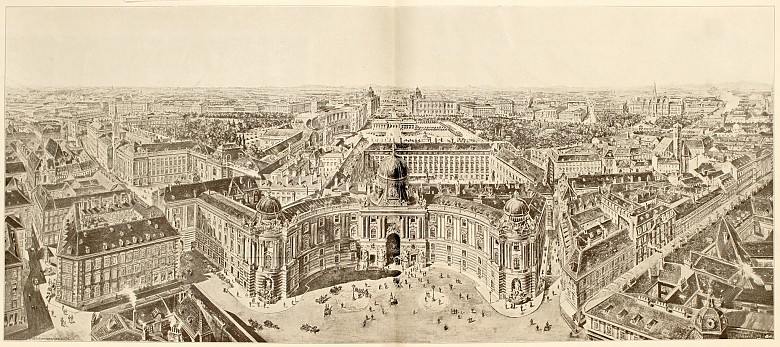
Scenographic view of the Vienna Hofburg, illustration, 19th century
The Vienna Hofburg
Between the thirteenth century and the end of Habsburg rule in 1918, the Vienna Hofburg developed by stages into the most important residence of the dynasty. The original Gothic structure around the present-day Schweizerhof (Swiss Court) was successively extended, most notably during the Baroque era and during the nineteenth century. Over time, it evolved into a sprawling complex of different wings which dominates the historic centre of the city.
https://www.habsburger.net/en/locations/vienna-hofburg
Relevant Chapters
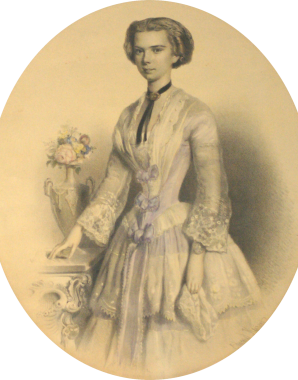
This website uses cookies.
We employ strictly necessary and analysis cookies. Analysis cookies are used only with your consent and exclusively for statistical purposes. Details on the individual cookies can be found under “Cookie settings”. You can also find further information in our data protection declaration.
Cookie settings Accept all cookies
Cookie settings
Here you can view or change the cookie settings used on this domain.
Cookies are a technical feature necessary for the basic functions of the website. You can block or delete these cookies in your browser settings, but in doing so you risk the danger of preventing several parts of the website from functioning properly. The information contained in the cookies is not used to identify you personally. These cookies are never used for purposes other than specified here.
We employ analysis cookies to continually improve and update our websites and services for you. The following analysis cookies are used only with your consent.
Save settings Accept all cookies
- Add page to list
- Delete list
The Habsburg dynasty: Here you can read potted biographies, examine portraits from seven centuries and dip into the historical contexts of past epochs.

Select a period in Habsburg history, from the beginnings of Habsburg rule in the Middle Ages to the collapse of the Monarchy during the First World War.

The map shows the territorial development of the Habsburg Monarchy as it evolved into a sprawling, geographically fragmented empire.

Monarchical rule was legitimized by descent. The classic form of representing these relationships is the genealogical table or family tree.

Collected themes - browse stories and anecdotes from the history of the Habsburg Monarchy.
Most viewed stories

Habsburgs in Exile – the Dynasty after 1918 The Habsburg Monarchy came to an end in...

Classical Music in Nineteenth-Century Vienna In the nineteenth century Vienna continued to consolidate...

Schönbrunn – the Habsburgs’ imperial showpiece Schönbrunn Palace is presented to the millions of...
Choose from various themes to access and explore the history of the Habsburg Monarchy, for example 'work', 'love' or 'death'.
Journey through the different epochs of Habsburg history from the Middle Ages to the First World War.
All the members of the Habsburg dynasty. Read biographical notes and explore the historical context.
Most viewed Habsburgs

Maria Theresa Maria Theresa was the most important ruler of...

Maximilian I, 'the last knight' With his policies of war and marriage, Emperor...

Karl I Karl became the heir to the throne after...
Vienna Hofburg – The palace of Austria’s Emperors
The residence of the habsburgs in vienna (from the 13th century until 1918).
From the 13 th century to 1918 (with interruptions), the Hofburg was the residence of the Habsburgs in Vienna. Duke Leopold VI is said to have laid the building’s foundations, while the first extension is attributed to Ottokar II of Bohemia. The building was first mentioned in a document under Habsburg King Rudolf I in 1279 and thus the beginning of its construction is classified as taking place in the first half of the 13 th century.
At that time, the original building was everything but a representative residence. It was an important component of the Vienna city fortifications and was constantly being expanded. In the middle of the 16 th century, Emperor Ferdinand I moved his residence to Vienna and began the extension. The Hofburg was extended through the expansion of the existing wings and some new buildings.
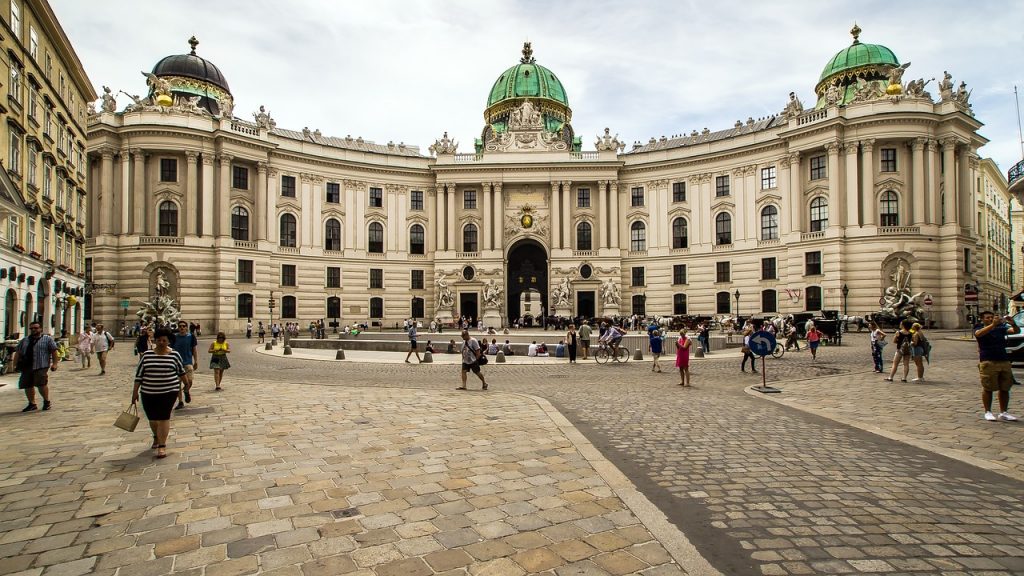
The significance of the Hofburg lay in its purpose as a seat of the “court” and also of the strictly hierarchically divided court behind it. The imperial family were at the top of the structure, while the Court Chamberlain was in charge of the court operations.
Art historical construction phases of the Hofburg
The building complex of the Hofburg came into existence between the 13 th and 20 th centuries. In retrospect, this can be divided into eight construction phases:
- Construction phase – in the Gothic epoch
The Swiss Wing with the Swiss Court is the oldest part of the palace. Here, the Gothic Hofburg Chapel mentioned in 1296 can be found. This wing also houses the Imperial Treasury today.
- Construction phase – in the Renaissance epoch
Vienna’s oldest Renaissance building, the Stallburg, was built during this epoch of style. In the middle of the 16 th century, Archduke Maximilian, later Emperor Maximilian II had a residence built. Originally envisioned to keep the city’s first elephant, this building housed the art collection of Archduke Leopold Wilhelm from 1658 to 1776 and was referred to as the Stallburg Gallery. As early as Emperor Charles VI’s rule, the horses of the Spanish Riding School arrived in the premises and are accommodated in the Stallburg to this day.
- Construction phase – Amalienburg in late Renaissance style
The Amalienburg was established opposite the Swiss Gate and named after Amalie Wilhelmine, the widow of Emperor Joseph I. Built in the late Renaissance style, over the years many different dukes and duchesses lived in this building, which is today used by the Chancellery Minister and Secretary of State.
- Construction phase – in early Baroque
From 1660 to 1668, the Leopoldine Wing was built, which connected the Swiss Wing with the Amalienburg.
Sie sehen gerade einen Platzhalterinhalt von Standard . Um auf den eigentlichen Inhalt zuzugreifen, klicken Sie auf den Button unten. Bitte beachten Sie, dass dabei Daten an Drittanbieter weitergegeben werden.
- Construction phase – in late Baroque style
At this time, Johann Bernhard Fischer von Erlach and his son Joseph Emanuel Fischer von Erlach collaborated to create the Winter Riding School opposite the Stallburg and the Imperial Chancellery Wing opposite the Leopoldine Wing. The Imperial Chancellery Wing was erected by Johann Lucas von Hildebrandt from 1723–1730. Here, you could find the offices of the Imperial Vice Chancellor as well as the Autic Council. The last wing was finally used to house the apartments of Emperor Franz Joseph I and his wife Elisabeth.
At this time, the Imperial Library founded by Emperor Charles VI, which today contains the Baroque State Hall of the Austrian National Library , also came into being. The magnificent hall contains a ceiling fresco by Daniel Gran and statues of emperors by Paul Strudel. The statue in the centre portrays Charles VI as the Holy Roman Emperor and the artwork is attributed to Antonio Corradini. The Augustinian Church bordering the library is connected to the Hofburg as part of the expansion.
To the north, the library is bordered by the Redoute Wing. Maria Theresa had an opera house built, which later become the “Redoutensäle”. This was used for banquets and concerts. Today, the Hofburg’s Festival Halls and the splendid Redoutensäle are used to host congresses, conferences, weddings, and trade fairs.
- Construction phase – in the classicism style
In 1805 and 1806, the Hall of Ceremonies was built in the classicism style and it is the most magnificent hall in the Hofburg. The court architect Ludwig Montoyer was commissioned by Emperor Franz I to create a throne room. An elaborate coffered ceiling borne on 24 round artificial marble pillars (the modern “stucco lustro” of that time) and 26 crystal chandeliers give the hall an imperial shine. This was also where Napoleon’s courtship of Emperor Franz I’s daughter, Marie Louise, took place.
The Burgbastei, part of the Vienna city walls was originally located at what is known as Heldenplatz today. From 1817 to 1819, the rest of the demolished fortifications were removed and from these, the “outer castle square” was formed.
- Construction phase – in Neo-Baroque style
To complete the northern area of the castle, Ferdinand Kirschner built the St. Michael’s Wing from 1889 to 1893. The wing was topped off with a large bronze dome. Meanwhile, two fountains featuring sculptures were erected at the front of Michaelerplatz .
After the city walls were torn down in the 1860s, the Twin Museums ( Art History and Natural History Museums) were built under the supervision of Gottfried Semper and later, Karl Freiherr von Hasenauer. They were completed in 1891.
- Construction phase – The New Castle in the Historicism style
The Twin Museums were built first as part of the city expansion and from 1881 to 1913, the New Castle was brought into being. It was not until the Habsburg Monarchy ended (in the 1920s) that the interior fittings were able to be completed. These wings were never lived in and today, serve as exhibition rooms for numerous museums and also as the reading room of the Austrian National Library.
Taking a tour through the Hofburg is like moving through the timeline of art history.
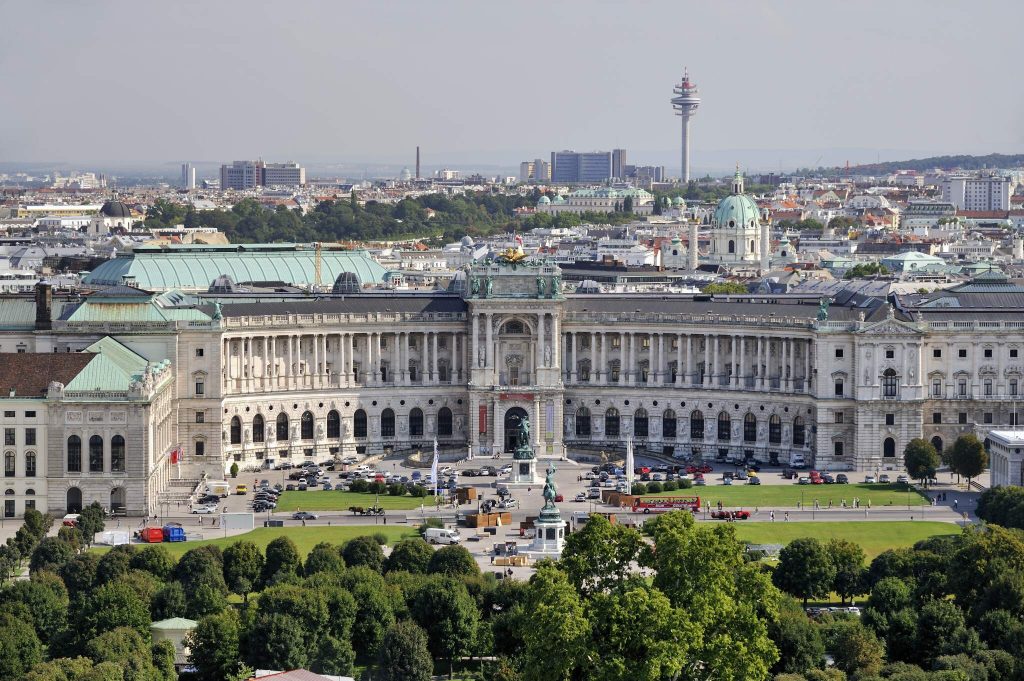
Historical squares
From the outside, the art-historical construction phases can easily be seen in the individual squares. From the Swiss Wing you can see the Gothic-style construction phase, on Josefsplatz the Baroque style, and from Heldenplatz and Michaelerplatz, you can see the Historicism-style construction phase of the Hofburg. The In der Burg square is framed by buildings from different periods, starting with the Swiss Wing from the Gothic epoch to the Baroque St. Michael’s Dome.
360-degree view underneath St. Michael’s dome:
How to reach the Vienna Hofburg
© 2024 vienna-trips.at - Ausflugstipps und Urlaubstipps

Schönbrunn or Hofburg – which one to visit first?
Which one should you visit first – schönbrunn palace or hofburg palace.
Vienna, a city steeped in imperial history, dazzles visitors with its stunning architecture and royal past. Two of its most iconic landmarks, Schönbrunn Palace and Hofburg Palace , stand as grand testimonies to the city’s opulent past. But if you’re on a tight schedule and wondering which one to visit first, let’s delve into what makes each unique, helping you decide where to start your royal Viennese adventure.
Schönbrunn Palace: A Journey into Imperial Splendor
A Baroque Masterpiece: Schönbrunn Palace, with its 1,441 rooms, is a marvel of Baroque architecture. Its yellow façade is as iconic as Vienna itself. The palace, once the summer residence of Habsburg monarchs, now invites visitors to explore the luxurious life of Austria’s imperial family.
The Palace Gardens: The Schönbrunn Gardens are a masterpiece of landscape architecture. These perfectly manicured gardens, dotted with sculptures, fountains, and the Gloriette, offer a serene escape from the city’s bustle. The Schönbrunn Zoo , located within the gardens, is the world’s oldest and adds a delightful aspect to your visit.
Inside Schönbrunn: The palace’s interior is a showcase of extravagance. The opulent rooms, adorned with lavish decorations, frescoes, and furniture, offer a glimpse into the private lives of the emperors. The Grand Tour includes 40 of the most impressive rooms.
Hofburg Palace: A Legacy of Power and Elegance
The Heart of Austrian Royalty: Hofburg Palace, the winter residence of the Habsburgs, is a sprawling complex in the heart of Vienna. Its history spans over 600 years, making it a symbol of the enduring legacy of the Austrian monarchy.
Cultural and Political Hub: Unlike Schönbrunn, Hofburg was not just a residence but a seat of power. Today, it houses several museums, the Austrian National Library, and the office of the Austrian President. The Imperial Apartments, Sisi Museum , and Silver Collection provide insights into the personal and public lives of the royals.
The Spanish Riding School: A unique feature of Hofburg is the Spanish Riding School , where you can witness the classical dressage of the famous Lipizzaner horses. This tradition, dating back centuries, is a living cultural heritage that continues to fascinate.
Making Your Choice: Which One to Visit First?
Consider Your Interests: If you’re fascinated by the grandeur of royal life and love exploring expansive gardens, start with Schönbrunn Palace. Its Baroque architecture, lush gardens, and the zoo offer a diverse experience.
Delve into the Heart of Vienna: If you’re eager to explore Vienna’s rich history and political legacy, Hofburg Palace should be your first stop. Its central location, coupled with the diverse museums and historical significance, make it an essential part of understanding Vienna’s past and present.
Time and Season Matter: Schönbrunn’s gardens are best enjoyed in spring or summer when they’re in full bloom. Hofburg, with its indoor attractions, is a great choice for a rainy day or a winter visit.
Both palaces offer a unique window into Vienna’s imperial history, each with its own charm and stories. Whether you start with the opulent Schönbrunn or the historically rich Hofburg, you’re in for an unforgettable journey into Austria’s royal past. Remember, Vienna isn’t just about ticking off sights; it’s about immersing yourself in a city that has been at the crossroads of history, culture, and art for centuries. So, take your time, soak in the atmosphere, and let the imperial grandeur of Vienna sweep you off your feet.
Recent Posts
Secret vienna newsletter, subscribe to our newsletter to get updates, exclusive offers and more. please note, our newsletter is mostly sent in german and only occasionally in english., secret vienna tours.
- Top 10 Vienna activities
- Cafes in Vienna
- Vienna in 24 hours
- Classical concert in Vienna
- Vienna team building
- Vienna's top 10
- Vienna behind the scenes
- The dark side of Vienna
- Secret societies
- The city of spies
- +43 67761612322
- [email protected]
- Spaces Icon Tower at Hauptbahnhof
Our Website
- secretvienna.org
Embedded content from other websites
Who we share your data with, how long we retain your data, what rights you have over your data, where we send your data, vielen dank, dass sie sich für unseren newsletter angemeldet haben, thanks for your interest in our secret vienna tour.
Our public tours are available mostly on weekends yet we always try to open new dates. Tell us if you prefer this tour as a public tour or as a private tour and we will get back to you with an offer!

Please note – We need at least 8 participants in order to open a public tour. If you don’t see your preferred tour in our Full Tour Calendar you can simply send us this inquiry and we will try to open a new availability.
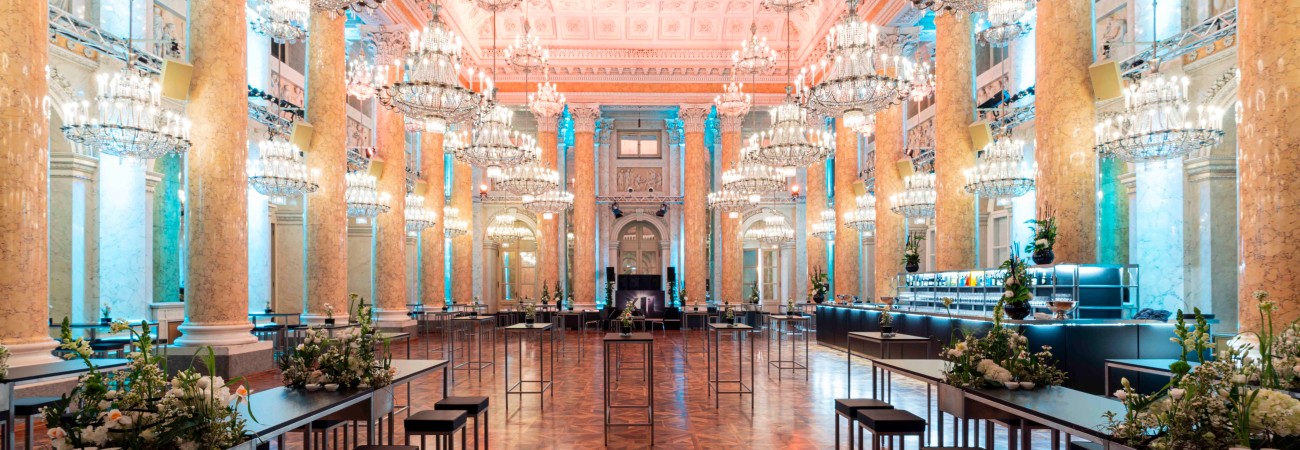
Welcome to the Hofburg Conference Centre
International conference and event centre hofburg in the heart of the capital..
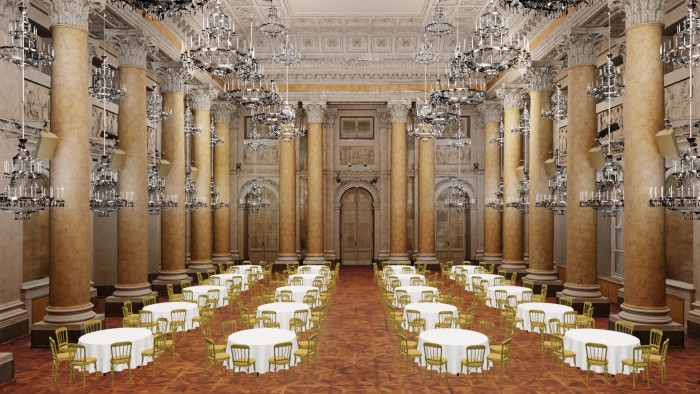
Cookie settings
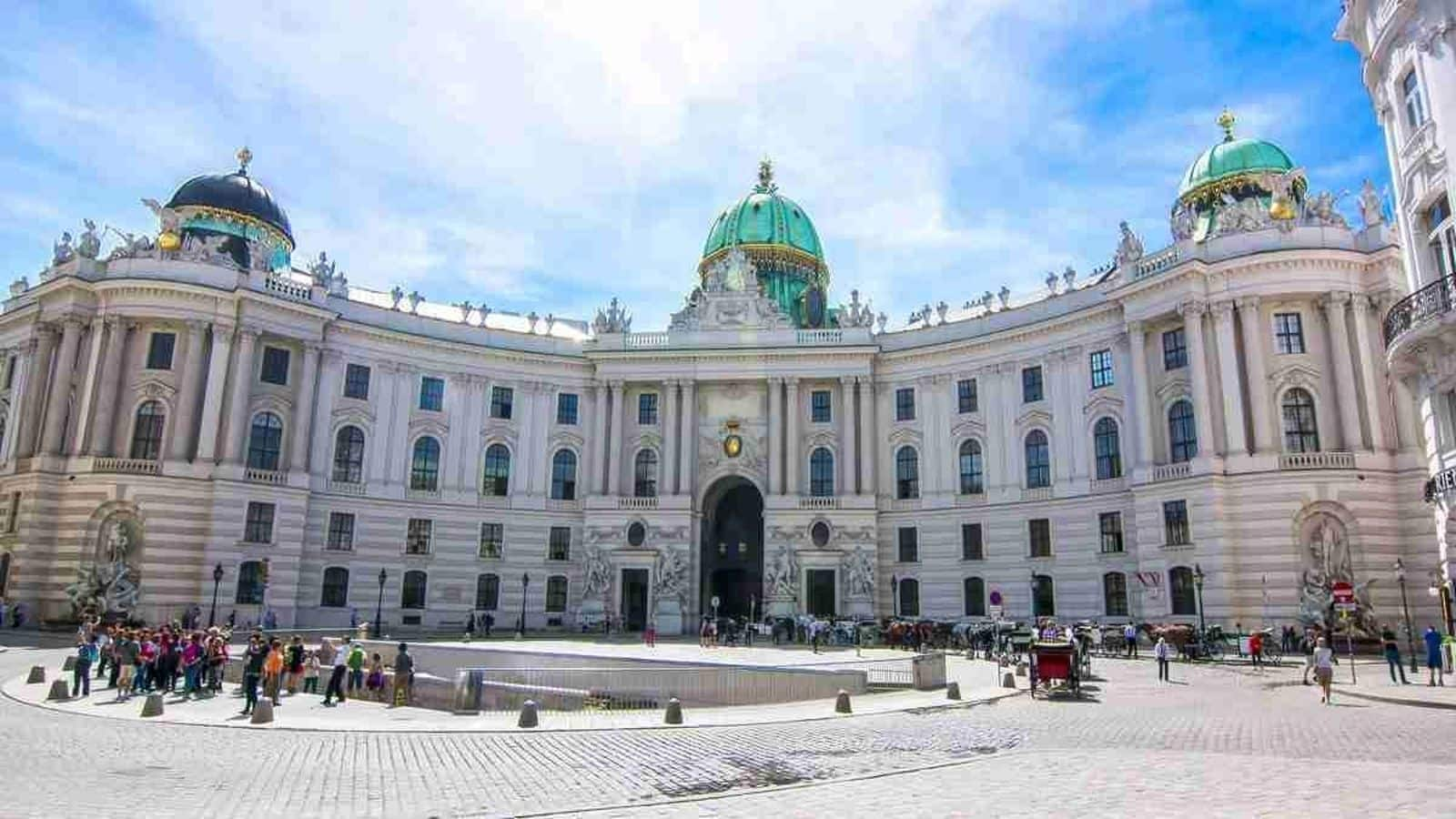
Things to explore in Vienna's Hofburg Palace
Vienna, the capital of Austria , is a city with a deep imperial past. In the winter season, it dons a festive attire with twinkling lights and a blanket of snow. This is the ideal season to visit the grand Hofburg Palace, once home to the Habsburg rulers. It remains an enduring symbol of Europe 's rich cultural legacy, inviting visitors to step into history.
Explore the Imperial Apartments
Within Vienna's Hofburg Palace, the Imperial Apartments stand as a testament to regal history. Each room, perfectly preserved, showcases the ornate furniture and cherished personal items of past emperors and empresses. The winter season brings a hushed serenity to these spaces, offering visitors a vivid sense of stepping directly into the lives of royalty against a backdrop of tranquil beauty.
Marvel at the Silver Collection
Step into the Hofburg Palace to uncover a treasure trove of silverware and tableware, once the pride of royal feasts. The Silver Collection, with its over seven thousand pieces, is a testament to the fine artistry of bygone eras. As winter's gentle light dances across these precious items, it casts a spellbinding glow that enchants all who visit, wrapping them in Vienna's regal history.
Discover Sisi Museum
The Sisi Museum, dedicated to the beloved Empress Elisabeth of Austria, offers a touching glimpse into her world. Personal belongings and evocative portraits tell her story. As you move through the quiet winter rooms, you feel a deep connection to her life. The silence amplifies the historical whispers that seem to permeate every corner of this intimate space.
Attend classical concerts
In the winter, Vienna's Hofburg Palace transforms its grand halls into venues for classical concerts. Visitors can immerse themselves in the musical heritage of Vienna as orchestras fill the air with compositions by Mozart and Strauss. This experience, where once only royalty was serenaded, is a magical journey through sound and history. It's an essential Vienna moment for anyone who cherishes classical music.

The Best Museums To Visit In Vienna
Europe is a dream destination for many. After all, it's home to some of the most historic, charming, and friendly cities in the world. From Amsterdam's canals and endless museums to Florence's incredible food and London's endless family-friendly attractions , there's something for every type of traveler. The list of popular holiday destinations in Europe is extensive, but there is one place that's often overlooked. In fact, it may just be Europe's most underrated metropolis: Vienna.
It's time to change that! The Austrian capital is home to royal palaces, top-rated art museums, family-friendly attractions (like the world's oldest zoo), a rich cafe culture with mouth-watering cakes at every turn, and more. Many of its star attractions are located within walking distance of each other and a large portion are clustered in the MuseumsQuartier. Exploring the historic city center on foot is not only easy but a must. Meanwhile, attractions that are further afield are well connected by an extensive metro and tram network. To help inspire your next trip and make planning your itinerary a little easier, here are the very best must-visit museums in Vienna.
The Hofburg
The Hofburg was once the imperial palace of the Habsburg dynasty and served as the royals' winter residence as of the 13th century. It's one of the largest palace complexes in the world and today, it's home to numerous museums. Interestingly, it's also the official residence of the President of Austria. As a tourist, you can visit the Imperial Apartments to see where and how the Habsburgs lived for over six centuries and walk through lavishly decorated bedrooms, salons, and even Empress Elisabeth's exercise room. The empress, who was nicknamed Sisi, also gets her time in the spotlight in the second major museum here: the Sisi Museum . Comprising over 300 personal objects – including a milk glass complete with a traveling case! – it paints a full picture of the life (and personality) of Emperor Franz Joseph I's wife. A single-day ticket will get you into both attractions.
Hofburg is also home to the Imperial Treasury where you can see crowns and other royal treasures; the Spanish Riding School where you can see Lipizzaner horses in action at a training or dressage performance; and the Austrian National Library, whose 18th-century State Hall is one of the most beautiful in the world. These require separate tickets.
The Belvedere
Set in a sprawling park, the Belvedere museum complex is made up of two historic palaces (Upper Belvedere and Lower Belvedere), a modern-day addition dedicated to contemporary art (Belvedere 21), and lush Baroque-style gardens. You could easily spend an entire day here, but if you're tight on time and still want to visit all three museums (Tip: Opt for the 3-in-1 day ticket), you'll need to allocate about three hours.
Built by Prince Eugene of Savoy in the early 1700s, Upper and Lower Belvedere were meant to serve as his summer home. Now, the lavish estate houses some of the world's greatest art. Start at Upper Belvedere to see works from the Middle Ages running through Baroque, Modernism, and all the way up to the 1970s. Here, you'll have the chance to view pieces from greats like Egon Schiele, Claude Monet, and Vincent van Gogh. However, it's the Gustav Klimt collection – the largest in the world – that sets art lovers' hearts aflutter, including the iconic "The Kiss."
As for Lower Belvedere, it's home to temporary exhibits, like 2023's "Klimt. Inspired by Van Gogh, Rodin, Matisse," and offers a chance to glimpse how Prince Eugene lived through preserved period rooms, including the Marble Gallery, Gold Cabinet, and Hall of Grotesques. Finish off your visit at Belvedere 21, which was specially built to showcase contemporary art, film, and music.
Schönbrunn Palace And Schönbrunn Zoo
Located just outside the historic city center, Schönbrunn Palace is perhaps the most popular attraction in the city. The sprawling complex became the Habsburgs' summer home under the 18th-century rule of Maria Theresa. Today, the imperial palace, along with its lush gardens and award-winning Schönbrunn Zoo, is on UNESCO's list of World Heritage Sites. While you could easily spend half a day exploring the palace, walking through the various green spaces, and getting lost in the park maze and labyrinth, you can tailor your visit to your time frame. Ticket reservations for the palace are a must and you can opt to visit the State Apartments (about 25 minutes), take the Imperial Tour (about 40 minutes) to see Emperor Franz Joseph I and Sisi's private apartments, or the Grand Tour (about 60 minutes) which covers all of the above, as well as Maria Theresa's rooms.
Schönbrunn Zoo, where you can spend the rest of your day, is equally impressive. In addition to being the oldest zoo in the world, it's repeatedly been voted Europe's best zoo and is home to 700 species, from Siberian tigers to capybaras, bearded dragons, exotic birds, and the show-stealing giant pandas. Tip: Make sure to check the daily animal feeding schedule for an added treat.
Depending on what you'd like to visit, there are various combination tickets available. For a family day out, be sure to also stop by the Children's Museum Schönbrunn Palace where kids can learn about royal life through hands-on exhibits.
Kunsthistorisches Museum Vienna
The Kunsthistorisches Museum Vienna looks like a palace and the collection it houses is truly royal in nature. Opened in 1891, the museum was commissioned by Emperor Franz Joseph I as a place to display the Imperial Collections of the Habsburgs. Step into the opulent entrance hall and you'll be greeted by a dizzying array of sculptures, marble columns, and gold. Walk up the grand staircase and admire the paintings created by brothers Ernst and Gustav Klimt and Franz von Matsch, which decorate all of the empty spaces between arches and columns.
This breathtaking beginning sets the tone for the impressive (and varied!) art collection you'll experience inside. Spanning Ancient Egypt to the late 18th century, artifacts range from Egyptian sarcophagi to Greek and Roman antiquities, some 600,000 coins, as well as paintings by an impressive array of Old Masters. Here, you'll be able to admire works by the likes of Peter Paul Rubens, Rembrandt van Rijn, and Johannes Vermeer, as well as experience the world's largest collection of works by Pieter Bruegel the Elder. In need of a break? You can stop by the café-restaurant for a traditional coffee and torte served in the gorgeous Cupola Hall or settle in for a full breakfast, lunch, or dinner.
Natural History Museum Vienna
The Natural History Museum Vienna has a history as impressive as its displays. Franz I Stephan of Lorraine was a Habsburg monarch, Emperor of the Holy Roman Empire as of 1745, and an avid lover of the natural world. It was he who founded the Schönbrunn Zoo in 1752, followed by Schönbrunn Palace's botanic garden the following year. His passion was so strong that he even funded scientific expeditions abroad and, in 1750, purchased what was then the world's biggest collection of natural history objects. Among the 30,000 pieces he acquired were fossils, minerals, corals, and much more. Following his death in 1765, the collection was made public, laying the foundation for today's museum.
Located right next to the Kunsthistorisches Museum Vienna, it brings together biology, earth sciences, anthropology, and archaeology. The rich permanent collection features everything from fossils to meteorites, minerals, animal specimens, and (always a hit) dinosaurs. Just some highlights include a full-sized pteranodon model, pterosaur skeletons, and an animatronic version of an allosaurus placed next to the real deal.
Leopold Museum
The Leopold Museum is conveniently located next to the Natural History Museum Vienna and Kunsthistorisches Museum Vienna and is home to an impressive array of Austrian modern art collected by Dr. Rudolf Leopold and his wife, Elisabeth Leopold. Dr. Leopold began acquiring works in the 1950s and eventually ended up with over 5,000 pieces from local masters like Egon Schiele, Gustav Klimt, and Oskar Kokoschka. As his obituary in The New York Times pointed out, Dr. Leopold was particularly fond of Schiele, even though his works were taboo and quite controversial at the time. In addition to writing books about the artist, he amassed the largest Egon Schiele collection in the world, comprising 42 paintings, 187 original graphics, and various manuscripts.
In 2001, the Leopold Museum opened to allow everyone to enjoy the fruits of Leopold's art collecting. The space is truly a love letter to the art of Vienna, particularly Viennese Modernism. In addition to the Schiele collection, the permanent exhibition, "Vienna 1900. Birth of Modernism," brings together 1,300 paintings, sculptures, photographs, textiles, furniture, and more to present a well-rounded picture of the art of the times.
Albertina And Albertina Modern
Although these two museums are housed in separate buildings, it's just a nine-minute walk between them and buying a combined entry ticket will save you over 25% on admission. Begin at Albertina and get lost in the stellar permanent exhibition "Monet to Picasso: The Batliner Collection," which features works by greats like Marc Chagall, Edgar Degas, Paul Gauguin, and Paul Cézanne. The museum also hosts top-rated temporary exhibits, like 2023's "Dürer, Munch, Miró: The Great Masters of Printmaking." But it's not just fine art you'll see here. The building that houses Albertina was once the residence of the Habsburg Archdukes and today, there are 20 restored and furnished Habsburg State Rooms for you to visit.
Once you've finished your journey to the past, you can venture over to Albertina Modern for a big dose of contemporary art. While the permanent collection focuses on post-1945 Austrian artists, temporary exhibits take a more international approach with shows like 2022's "Ai Weiwei: In Search of Humanity" and 2023's "Andy Warhol to Damien Hirst: The Revolution in Printmaking."
Tip: It makes sense to do both museums on the same day, given their proximity, but your ticket allows you to visit them on different days within one year.
Former Apartments Of Beethoven, Strauss, And More
Think of a famous composer and chances are, they lived and worked in Vienna – at least for a time. Indeed, Ludwig van Beethoven, Johann Strauss, Franz Schubert, and Joseph Haydn all called the city home and six of their former apartments have been turned into museums. You can purchase a combined ticket to save nearly 40% on admission and gain access to: Haydnhaus where Haydn spent the last 12 years of his life; Johann Strauss Wohnung where Strauss lived and worked for seven years; Schubert Geburtshaus where the composer was born; Schubert Sterbewohnung, the apartment where he spent the last few weeks of his life before his death at just 31; Beethoven Pasqualatihaus where Beethoven worked on many of his famed symphonies over eight years; and the Beethoven Museum which showcases the famed maestro's life, work, and struggles. While the museums are compact, they are spread out across the city, so you may want to visit them on separate days. Luckily, your ticket is valid for a full year.
Note: You may also wish to visit Mozarthaus Vienna, the only remaining Viennese apartment that Wolfgang Amadeus Mozart once called home, but that will require a separate ticket.
Klimt Villa
Located close to Schönbrunn Palace, Klimt Villa is a must-visit for Gustav Klimt fans. While it may not generate as much buzz as, say, Upper Belvedere's collection of Klimt paintings, it is the only space in the city where you can literally walk in the artist's footsteps and learn more about him as a person.
What is now an impressive villa used to be a single-story summer house which Klimt rented and used as a workshop from 1911 until his death in 1918. Notably, while the home was later expanded (and nearly demolished!), the studio space was left untouched. Today, it has been meticulously reconstructed to look as it did when Klimt was in residence. With help from photographs and historical accounts, curators were able to bring Klimt's reception room and studio back to life, offering visitors the unique chance to experience the space as the artist himself would have seen it. Once you're done inside, you can wander out into the very garden he once painted and imagine yourself the subject of one of his works. Tip: If you happen to be visiting on a weekend between May and October, you can enjoy a coffee break in the Garden Café.
Jewish Museum Vienna
The first Jewish museum in the world was founded in Vienna in 1895 and today's Jewish Museum Vienna continues that storied legacy. During WWII, Nazis closed the museum and confiscated its collection, over half of which was never to be seen again. The surviving objects now make up the core of today's museum, which aims to shine a light on Jewish history, religion, and culture. It is split into two locations – Museum Judenplatz and Museum Dorotheergasse – but they can easily be visited at the same time, as they're just an eight-minute walk apart. However, your ticket is valid for seven days, so you can also split them up if you prefer.
We recommend starting at Museum Dorotheergasse where the permanent exhibit "Our City! Jewish Vienna - Then to Now" will teach you about Jewish life from the Middle Ages until the present day. Other highlights include the Atelier, which showcases the art of celebrating various holidays and festivities, as well as Visible Storage, which houses the remaining collection from the original museum. Then, you can make your way to Museum Judenplatz, housed on the site where a 13th-century synagogue once stood until its destruction in 1421. This was the heart of the Jewish quarter at the time and the synagogue's remains can be seen inside the museum alongside a virtual reconstruction.
Museum Of Applied Arts (MAK)
The Museum of Applied Arts (MAK) dates all the way back to 1863 when Rudolf von Eitelberger, the first-ever professor of history at the University of Vienna, dreamt up the space to rival London's Victoria and Albert Museum. Initially called the Imperial Royal Museum of Art and Industry, the MAK showcases a wide-ranging collection, from furniture to textiles, contemporary art, and Venetian glass. Its permanent exhibition, titled "Vienna 1900," is a must-see made up of 500 pieces that shine a spotlight on the various art forms of the time. Fans of Gustav Klimt will be delighted to find that the exhibit is home to a shimmering design drawing that runs over three feet in length and is covered in gold leaf, silver leaf, and platinum leaf. The panel depicts the design from the Stoclet Frieze, which Klimt designed for the Palais Stoclet in Brussels (a private home) around 1900.
Other highlights include the MAK Permanent Collection Asia, as well as temporary exhibits from the likes of French performance artist Lili Reynaud-Dewar and New York Minimalist Rosemarie Castoro.
Ernst Fuchs Museum (Otto Wagner Villa)
Yes, the Ernst Fuchs Museum (Otto Wagner Villa) is off the beaten path, but it rewards those who make the effort to reach it with a truly surprising gem of a visit. Accessible by public transport from the Maria-Theresien-Platz, this unique museum brings together two great artists – Otto Wagner and Ernst Fuchs – and offers a rare respite from the crowds.
Famed Austrian architect Otto Wagner (born in 1841) left his stamp all around the city and you can still admire his Art Nouveau creations while wandering Vienna's historic center, from his Majolikahaus (Majolica House) to the Karlsplatz metro station. However, this villa offers the unique opportunity to visit an entire home dreamt up by Wagner. Built in 1888 as a summer getaway for his family, the villa later changed hands and fell into disrepair until Viennese painter Ernst Fuchs (born in 1930) purchased it in 1972. With help from Wagner's original designs, he lovingly restored the home and went on to use it as his own studio. These days, a visit offers the chance to admire the works of both men.
Walk through the opulent rooms filled with period furniture (including Art Nouveau decor designed by Wagner himself), take in the Fuchs paintings adorning the walls, and get ready to have your breath taken away by beautiful touches, like the stunning stained glass windows by Adolf Böhm.
Read this next: It's Time To Ditch These 10 Outdated Travel Tips
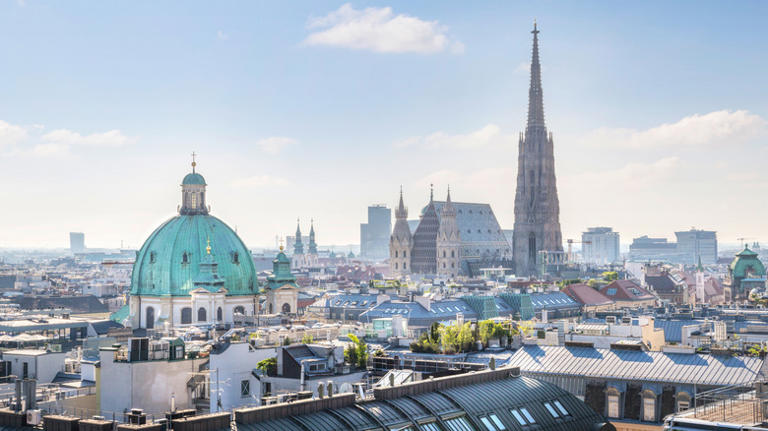

IMAGES
COMMENTS
Vienna's top attraction is Hofburg, the Imperial Palace, the winter residence of the Habsburgs who divided their residence and official receptions between this exceptional palace and a no less sumptuous summer residence, Schönbrunn Palace.. For six centuries, until the end of World War I, Hofburg was the centre of power of the Habsburgs, one of the most powerful and long-lived dynasties in ...
The Hofburg is an enormous palace complex in the heart of Vienna, which includes fascinating museums, a church and chapel, the Austrian National Library, and the Spanish Riding School, as well as the office of the President of Austria. There is undoubtedly something at the Hofburg complex to suit everyone's interests, and here we have compiled a guide to the three most popular places to visit ...
Located in the old town at the centre of Vienna, the Hofburg area covers a collection of formerly imperial and court buildings occupied by the ruling Habsburg dynasty between the 13th and early 20th centuries. The complex is not a standalone palace in the sense of a Versailles. Instead, you get a series of opulent, interconnected buildings that ...
Theater Museum. In the 17th-century Baroque Palais Lobkowitz, near the Imperial Palace, they ... Sisi Museum, Spanish Riding School, Imperial Apartments, and Heldenplatz are the highlights of the Imperial Palace, one of the biggest palace complexes in the world.
The ticket counter and starting place for the tours lie beneath the huge dome at the impressive Michaelerplatz entranceway (pictured above) at the northeastern end of the Hofburg complex. Subway: Station Herrengasse (U3 and your best choice), Volkstheater (U2/U3) or Stephansplatz (U3/U1) Tram: 1, 2, D or 71 to Burgring or 1, 2, D, 71, 46 and 49 ...
On Foot: The Hofburg lies within easy walking distance of Vienna's city center and its many tourist attractions. By Bus: The Hofburg is well served by city bus services (Routes 2A and 3A, alighting at Hofburg). By Tram: Vienna's tram services travel to the Hofburg regularly (Routes 1, 2, D, and J, alighting at Burgring).
The 13th-century Hofburg Imperial Palace is an imposing complex of buildings in the center of Vienna.It has been the residence of various rulers of the Holy Roman Empire, the Habsburg Monarchy, the Austro-Hungarian Monarchy over the centuries and has served as the official residence of the Austrian Federal President since 1946.. The Hofburg Palace covers an area of 240,000 square meters and ...
The Hofburg, like most major tourist sites in Vienna, is not free to visit. All tickets come with a free audio guide but you can opt for a guided tour with an extra charge. Also, check out the Sisi ticket below, if you're planning a visit to Schönbrunn Palace and/or the Imperial Furniture Collection as well.
Hofburg is a must-see destination for anyone visiting Vienna, as it offers a unique glimpse into the history and grandeur of Austrian royalty. However, with its vast size and numerous attractions, planning your visit to Hofburg can be overwhelming. To make the most of your experience at this magnificent palace complex, here are some helpful ...
The Gothic Hofburg Chapel, where the Vienna Boys' Choir performs during High Mass every Sunday, is a lasting reminder of the original medieval castle. The oldest part still in existence is the Swiss Wing with the imposing red-and-black Swiss Gate. Directly connected to it is the Amalienburg and the Leopold Wing, which today houses the official ...
Hofburg ( Vienna) is the former winter residence of the Habsburg imperial dynasty, considered today the largest secular palace in the world. The attraction lies on an area of at least 240 thousand m² and includes 18 outbuildings, 19 courtyards and 2,600 apartments, which cover an entire area in the center of Vienna.
Hofburg Imperial Palace is a historic building in Vienna, Austria. It was the principal imperial palace of the Habsburg dynasty rulers and today serves as the official residence and workplace of the President of Austria. The palace complex consists of 18 wings and 2 courtyards and covers almost 13 acres (53,000 m²).
Vienna, Austria, Europe. Top choice in Vienna. Nothing symbolises Austria's resplendent cultural heritage more than its Hofburg, home base of the Habsburgs from 1273 to 1918. The oldest section is the 13th-century Schweizerhof (Swiss Courtyard), named after the Swiss guards who protected its precincts. The Renaissance Swiss Gate dates from 1553.
Guide To The Hofburg Palace: What To See 1. Palace. What you general think of as the residential Hofburg Palace has 3 parts: the imperial apartments, the Sisi Museum, and the silver collection. Imperial Apartments. The Neo-Rococo imperial apartments you'll see on a visit feature over-the-top ornametation from the era.
Dating back to the 13th century, Hofburg is worth visiting for its undoubtedly rich history and unparalleled experience in getting a glimpse of the opulent lives of the Habsburg family. Come inside and you'll learn about Princes Sisi, Franz Joseph I, Maria Theresa, Holy Roman Empire, and so much more.
The Hofburg (German: [hoːf.buʁk]) is the former principal imperial palace of the Habsburg dynasty in Austria.Located in the centre of Vienna, it was built in the 13th century and expanded several times afterwards.It also served as the imperial winter residence, as Schönbrunn Palace was the summer residence. Since 1946, it is the official residence and workplace of the president of Austria.
Overall, a visit to the Hofburg is a great place to start your historical exploration of Vienna. The many centuries of history covered in the palace's museums and exhibitions give an interesting and in-depth insight into one of the world' most famous and powerful royal families.
The Hofburg was the residence of the Habsburgs for over 600 years and thus the centre of the Holy Roman Empire. Apart from its function as the seat of government and administrative centre, the Hofburg was also the winter residence of the imperial family. From the 18th century onwards the court spent the summer at Schönbrunn Palace.
The Hofburg Palace is one of the most educational yet charming and interesting places in which one can observe the life during the era of the great kings that once ruled Europe. These days, the palace serves as the official home of Austria's president. Hofburg Palace is part of Hofburg Palace, Sisi Museum Vienna Skip-the-Line Guided Tour - a ...
The Vienna Hofburg. 1278-1918. Between the thirteenth century and the end of Habsburg rule in 1918, the Vienna Hofburg developed by stages into the most important residence of the dynasty. The original Gothic structure around the present-day Schweizerhof (Swiss Court) was successively extended, most notably during the Baroque era and during ...
From the 13 th century to 1918 (with interruptions), the Hofburg was the residence of the Habsburgs in Vienna. Duke Leopold VI is said to have laid the building's foundations, while the first extension is attributed to Ottokar II of Bohemia. The building was first mentioned in a document under Habsburg King Rudolf I in 1279 and thus the ...
Hofburg, with its indoor attractions, is a great choice for a rainy day or a winter visit. Both palaces offer a unique window into Vienna's imperial history, each with its own charm and stories. Whether you start with the opulent Schönbrunn or the historically rich Hofburg, you're in for an unforgettable journey into Austria's royal past.
Welcome to theHofburg Conference Centre. International conference and event centre Hofburg in the heart of the capital. Virtual Tour.
This is the ideal season to visit the grand Hofburg Palace, once home to the Habsburg rulers. ... In the winter, Vienna's Hofburg Palace transforms its grand halls into venues for classical concerts.
Hofburg is also home to the Imperial Treasury where you can see crowns and other royal treasures; the Spanish Riding School where you can see Lipizzaner horses in action at a training or dressage ...